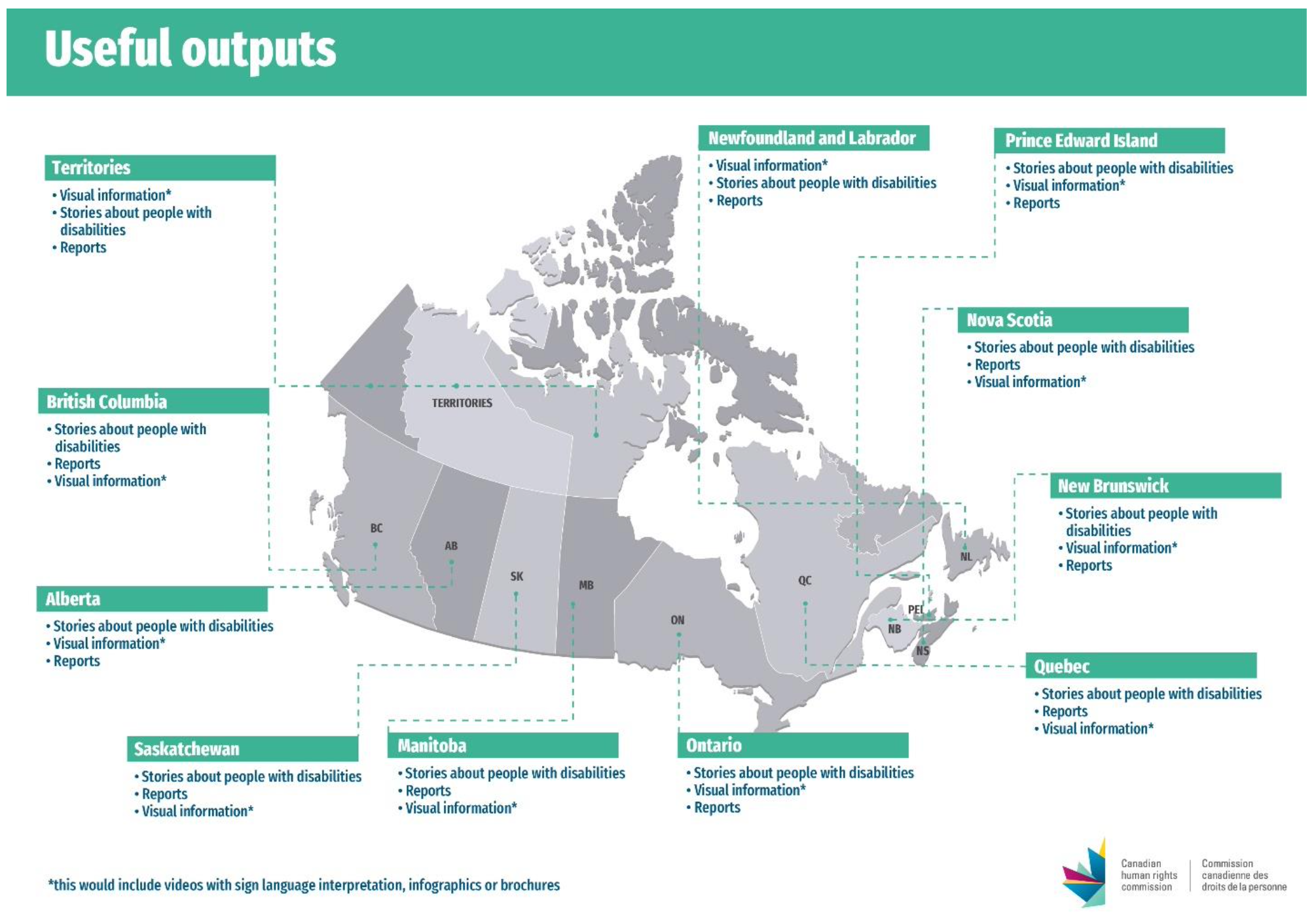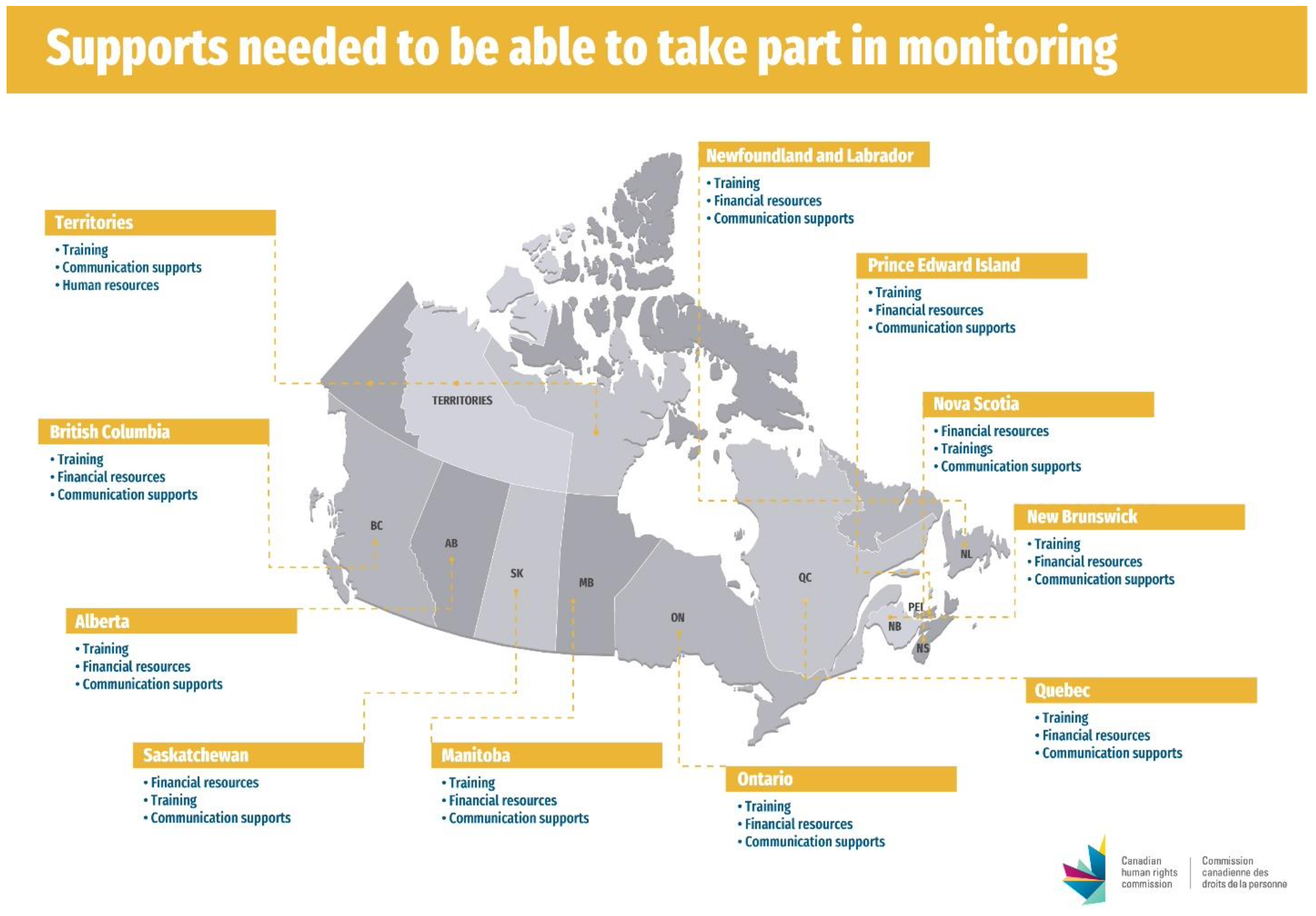What we did and what we learned: Monitoring Disability Rights
This report provides a plain language summary of what people shared during the public engagement process. This report has been translated and tested by People First of Canada’s plain language team. Self advocates from across the country provided their input, expertise, and experience to help make this report more accessible through plain language. It includes Sign language videos and closed captioning. It can also be read with a screen reader.
1. Executive Summary
The United Nations Convention on the Rights of Persons with Disabilities is an international treaty. An international treaty is an agreement between countries. In this document, we will call it the 'Convention' for short. The goal of the Convention is to protect the rights and dignity of people with disabilities. It makes sure they are safe from discrimination. It makes sure they are treated equally.
Canada agreed to follow the rules of the Convention in 2010. These rules say that Canada will do the following things.
- Promote the human rights of people with disabilities
- Make sure people with disabilities can use and enjoy their rights
- Make sure people with disabilities are treated with equality in Canada
In 2019, the Canadian Human Rights Commission was put in charge of keeping track of, or monitoring, how the Convention is put into action in Canada. In this document, we are called the 'Commission' for short. It is the Commission's job to identify gaps and problems that need to be fixed.
Monitoring the Convention is an important responsibility. We will involve other people and groups in our monitoring work. We will work with people with disabilities and disability advocacy groups. Together, we will work to make sure Canada follows the rules of the Convention.
Before we could start monitoring the Convention, we needed to do some work first. The first step was to talk to people and listen to their thoughts. We needed to understand the most important problems that we should look at. We also needed to give people a chance to tell us how they think we should do our monitoring. This is called the public engagement process.
This report gives a summary of the public engagement process. Most importantly, it explains what we heard and what we learned from the people we talked to.
When we started talking to people, we reached out to possible partners. Here is a list of the people and groups we contacted.
- People with disabilities across Canada
- Organizations that advocate on behalf of people with disabilities
- Families and caregivers of people with disabilities
The public engagement process included two parts. The first part was an online survey. The second part was online conversations or chats. This allowed us to hear about the experiences of people with disabilities in Canada. We learned about the barriers and discrimination they face. We learned what can be done to reduce and remove those barriers.
People also gave us their views on other issues. Here is a list of some things they talked about.
- What monitoring should look like
- Who should be involved
- What information should be collected
- How information should be shared with the public
- The supports they might need to take part in monitoring work
The public engagement process took place in 2020. This was also the time of the COVID-19 pandemic. The pandemic has made life difficult for people and communities. It has been especially difficult for the following groups.
- People with disabilities
- Marginalized communities (These are communities and people that are often left out or forgotten by most of society.)
- People living in vulnerable situations (This could include people who could easily lose their jobs, become sick, or become homeless.)
We had to make changes to our process because of the pandemic. But it was important to move ahead with our work. Here are some of the changes we made.
- We kept the online survey open for a long time. It was open for all of June and July 2020. This encouraged more people to take part. Almost 3,000 people across Canada took our survey. Most of them were people with disabilities.
- We talked to people online instead of in person. After the survey was over, we held chat sessions. We talked to people who took the survey. We also talked to people who were not able to take the survey. We wanted to hear from diverse voices. We had over 50 people take part in these chats. Most of them were people with disabilities.
We look forward to moving ahead with this monitoring work. We believe that the engagement process is just the beginning.
The next section contains a summary of what people shared during the process. This information is very important. It will guide how the Commission does its work and makes plans. It will help us know what to monitor and how.
1.1 Guiding principles for monitoring
We learned a lot through the survey and chats. Many people who did the online survey said they did not know about the Convention. This means that we need to do more to raise awareness. People said they want to learn more about what the Convention means for people with disabilities. They want to know how it affects their daily lives.
Most people who did the survey felt that Canada was not doing a good job to promote or protect the rights of people with disabilities. We heard that people with disabilities need to feel their lives matter. They want Canada to put the Convention into action and start following its rules. People repeated that they want action now. They want the Commission to partner with people with disabilities and community groups to do this.
We told people about the four main principles that will guide our work.
- Participation
- Accessibility
- Equality and non-discrimination
- Intersectionality
We asked people to tell us what these principles mean to them. We asked people about their experiences and barriers when it comes to each of these principles.
Participation
Participation means making sure everybody can take part. It means getting people involved in an activity or event. People told us that they want to help with our monitoring work. They said that people with disabilities are usually not included in decisions that affect them. Families are often not consulted or included either. They are often left out of decisions that affect their children with disabilities.
People listed the following barriers to taking part
- Cost barriers
- Lack of funding for supports
- Lack of accommodations
We heard that people with disabilities should not be left behind. They must be included in the monitoring process. All groups and people with disabilities must be given the chance to take part. There must be energy and effort put towards including them.
Accessibility
We heard that people are concerned about accessibility. Accessibility means that everyone has equal access. It means that everybody can get to and use spaces and places. It means that everyone can get to and use information. It means that people with disabilities can do what people without disabilities do in a similar way. It means it should take about the same amount of time and effort for both groups to do the same things.
Barriers are one of the things that affect accessibility. A barrier is anything that stops people with disabilities from taking part. There are many different kinds of barriers. A barrier can be in a building or space. It can be a policy. It can be in information or communication. It can be in the negative attitudes of other people.
People told us about the many barriers they face every day. A lot of times these barriers are overlooked. This is because not everybody understands what barriers are and how they impact people. People gave two common examples of barriers that are overlooked.
- Physical barriers in buildings and public places
- Accessibility barriers in school or the workplace
People said that physical barriers are a problem. They stop people from taking part in society. They talked about ways to remove these barriers.
People also asked for better education and training. They said to teach people how to accommodate people with disabilities. They said teachers and school staff need training. They said managers need to learn how to build a workplace with no barriers.
Equality and non-discrimination
Equality and non-discrimination mean that people are treated equally and fairly. It means that people are not discriminated against. Most people who took the survey were people with disabilities. They told us that they face discrimination. They also face unfair treatment. This happens in many parts of their lives. This includes in their workplace and the community.
People said that workplaces are sometimes not accessible. They said they do not get the accommodations they need.
They also said that they don't talk about their disability. They said it can lead to unfair treatment. They said they are sometimes made to feel uncomfortable in public. Sometimes they also feel disrespected. This is because of how other people see their disability.
We asked them what needs to be done to make things better. They said there needs to be work done to change how people with disabilities are seen. They said public attitudes need to change. The way people with disabilities are treated needs to change. They said it would help if there was more awareness about how people with disabilities are treated. They also said that public education and training would help.
Intersectionality
Intersectionality is a word used to describe an idea. The idea is about different parts of people's identity. A person's identity includes a lot of things about them. It can include their disability, gender, race or age. It can include their sexual orientation and other parts of their identity. A person's identity also includes the situations they live in. This can include living in poverty or having a low income. The idea of intersectionality says that all these different parts of a person's identity combine, or intersect, with each other. And that people are treated unfairly because of more than one part of their identity or living situation. We wanted to learn more about this.
We asked people about the discrimination they have faced. We asked them if it was because of more than one part of their identity. We asked them to share their stories. These were the most common factors that led to their experiences of discrimination.
- Identity as a person with disabilities (this includes invisible or multiple disabilities)
- Gender identity
- Living situation of poverty or a lack of money
- Racial identity
- Any mixture of these factors
People want more education and awareness. They said that society needs to learn how these factors can affect the way people with disabilities are treated.
People told us that intersectionality is important. They said that it should be taken into account when making decisions that affect people with disabilities.
1.2 Involvement of people with disabilities in monitoring
People want to take part in the monitoring process. They said they need more information and supports to do so. Here are some of the things people told us they want and need to take part.
- People want to know what monitoring is. It needs to be better explained.
- People want different kinds of disabilities and experiences represented in the monitoring.
- People want to tell their own stories.
- People want more information about how they can get involved with the Commission.
- People want the Commission to seek out people with disabilities. They want them involved in the process. This includes people in institutions or care homes. They need the chance to take part as well.
- People want it to be easy to take part in the monitoring process.
- People want to be trained and given resources so they can take part.
- People want to be paid for their advice and skills.
- People want to be paid back for travel and other costs to take part.
Many people said the barriers they face every day make it hard for them to be involved. These barriers include poverty, inadequate housing and accessibility issues.
People want to play different roles in the monitoring process. Many people said they would like to be kept up to date about monitoring. Other people want to take part in the work itself. They could help by reviewing reports. They could also help collect information.
Some people find the Convention difficult to read. It is hard to understand. They would like a simpler version. This would make it more accessible. People said it should have the following features.
- It would be easy to read and understand.
- It would list the rights protected under the Convention.
- It would say who enforces each right in Canada.
This would make it easier for people to make sure the Convention is followed. It would clearly show where to report issues. It would also help people with disabilities understand how their rights are protected.
People who did the survey felt that advocacy groups have an important role to play in monitoring. Here are some of the ways these groups can help.
- Continue to advocate for people with disabilities
- Raise awareness about the monitoring process
- Help people with disabilities take part in monitoring
- Help with supports
- Help with accommodations
People also said that advocacy groups do not represent everyone. This means that it is important to listen to individual voices as well.
1.3 Monitoring priorities and framework
We heard that people with disabilities face many issues. These issues vary from region to region across Canada. Overall, we heard that poverty, housing and work are the three most important issues or areas of concern.
People with disabilities shared stories about living in poverty. They shared that they face many barriers. These barriers make it hard to have a good standard of living. Many people do not have financial aid. They also shared that provincial disability payments are too low. And there is no basic universal income in Canada. This is why many people with disabilities live in poverty.
People shared stories about having nowhere to live. This included stories of housing that is not accessible or appropriate.
People also talked about not having a job. This was linked to why they experience poverty.
Healthcare was another important issue or area of concern. We learned about barriers that people with disabilities face in getting healthcare. This includes mental healthcare. People who did the survey said it is important to monitor this area.
People told us that they want the Commission to be inclusive in its monitoring. They feel that it is important to think about the individual articles in the Convention. They also think it is important to think about the general themes in the Convention. Together, the articles and themes will provide a better picture of the important issues facing people with disabilities across Canada.
1.4 Monitoring data and communicating results
The Commission will gather information to help with the monitoring process. This will help to make sure we know how Canada is following the Convention. People said it is important that intersectional information is used. They also said this information should reflect people's experiences. This includes people's experiences living in poverty.
People talked about how the results of monitoring should be shared. They said that using stories is the best way. Stories bring information to life. Stories have the most impact. These stories need to be heard. These stories must lead people to act. People want government to be accountable. People want to be able to see real results and progress.
People would like to see information presented in a variety of ways. There is no “one size fits all” approach. But many said that the best way to present results is by using pictures and words. This can include the following things.
- Videos with Sign language and captioning
- Infographics
- Brochures
- Reports that give results of monitoring
They also said it is important that all communications are fully accessible to everyone. They suggested ways to communicate. Here are some of them.
- Social media
- Traditional media
- In person
- Online
- Printed material sent through the mail
- Printed material at agencies and social services
- Printed material at health care offices
We believe that this engagement process is just the start. It is the start of a monitoring plan that will do the following things.
- Empower and partner with people with disabilities
- Empower and partner with disability advocacy groups
- Share a commitment to seeing real action
- Continue to involve people with disabilities, their families and caregivers in the monitoring process
The Commission is grateful to the thousands of people who took part in this engagement process. They shared valuable experiences about the barriers they face. They also gave useful opinions about how to monitor the Convention in Canada. Their stories prove that Canada must do much more to help people with disabilities. Their rights need to be promoted and protected.
The rest of the report gives the full details and results of our engagement process.
2. Project Overview
In Canada, every person has the same rights. Every person has the same right to make the lives they are able to and want to have. But for some people there are barriers to having the life they want. Barriers are things that get in the way of people taking part. Barriers stop people from doing the things they want to. People with disabilities often face barriers in their everyday lives.
Most of the complaints about discrimination that are brought to human rights commissions are from people with disabilities. This is true in all areas across Canada. People with disabilities face many different kinds of barriers in many parts of their lives. There are barriers in policies and in workplaces. There are barriers in buildings and public spaces. There are barriers in our health care and transportation systems. There are barriers in our media and broadcasting. There are barriers in our banks and schools. There are also barriers in our views and attitudes towards people with disabilities.
The Canadian Human Rights Commission has a role to play in changing this. We are Canada's human rights watchdog. In this document, we are called the 'Commission' for short. The Commission is independent from the government. We work for the people of Canada. We promote and protect human rights. This includes receiving discrimination complaints. These are about employment and services that come under the area of the federal government.
Monitoring the Convention on the Rights of Persons with Disabilities
Recently, the Commission has been given a new responsibility. We will monitor the United Nations Convention on the Rights of Persons with Disabilities. In this document, we will call it the 'Convention' for short. Monitoring means that we will track how the Convention is put into action by governments in Canada. It also means we will make sure the Convention is being followed by governments in Canada. It is the Commission's job to identify gaps and problems that need to be fixed.
The Convention is an international treaty. It is an agreement made between countries. It will help countries to protect the rights of people with disabilities. It will help to make sure people are treated equally. Canada agreed to follow the Convention in 2010. This means Canada is required to promote and protect the rights of people with disabilitiesFootnote 1.
Monitoring the Convention is an important responsibility. We want to do a good job. We want to work with people with disabilities. We want to work with their families and caregivers. We also want to work with advocacy groups that work on behalf of people with disabilities.
The first thing we wanted to do was hear from people. We wanted to get some information from them and listen to their thoughts. We needed to understand the most important problems that we should look at. We also needed to give people a chance to tell us how they think we should do our monitoring. We called this our engagement processFootnote 2.
Survey
The process included an online survey. The survey was open between June 8 and July 31, 2020. The survey was available in English, French, American Sign Language (ASL), and Langue des signes québécoise (LSQ). The full survey is in Appendix A of this document. The first results of the survey were published and shared in the fall of 2020. The information was shown using infographicsFootnote 3.
Chat sessions
We wanted to hear more from diverse people who may not have been able to do the survey. So we also held dialogue, or chat, sessions. These were held online due to COVID-19 health guidelines. We had three sessions. Two were in English. One was in French. We did these in November 2020.
The sessions were accessible. There was Sign language in English and French available. There was also CART services available. CART stands for Communication Access Real-time Translation. This service takes spoken words and changes them into text. This helps people who use devices for communication.
The sessions included people with disabilities and their families and caregivers. It also included disability advocacy groups. People were asked some of the questions from the survey. They were asked how to make sure people with disabilities are included in monitoring. They were also asked to share important issues or areas of concern.
The questions asked in the chat sessions can be found in Appendix B of this document.
Engaging people
We collected information during the engagement process. We heard from people with disabilities, their families and disability advocacy groups. We also heard from other members of the public.
We heard about the experiences of people with disabilities in Canada through both the survey and the chats. We heard about the barriers and discrimination they face. We heard what could be done to reduce or remove those barriers.
We asked them what the process of monitoring the Convention should look like. We asked them who should be involved. We asked what information should be collected. We asked how that information should be shared.
We also asked people to tell us if they want to be part of this process. We asked what support they would need to be able to take part.
Understanding this report and the results
The Commission values the voices of all who took part in their own way. All questions in our survey were optional. People took part as much as they could.
The survey included two kinds of questions. One kind of question gave choices in a list. The other kind of question allowed people space to write their answers. The answers to these kinds of questions were studied to find out the main ideas and themes.
We considered all responses that people gave. But this means the response rate for each question can be different.
It also means that some results add up to more than 100%. This happens when people can choose more than one answer in a question. Some results can add up to less than 100%. This can happen when people do not answer all the questions. Other reasons for results not adding up to 100% are due to number rounding.
There are four appendices at the end of this report. They give the following information.
- Appendix A – The online survey questions
- Appendix B – The online dialogue sessions questions
- Appendix C – The results of the survey and dialogue sessions
- Appendix D – Infographics of provincial and territorial information
The following sections of the report are a summary of what we heard through our engagement process. The words used in this report try to reflect the language used by the people we talked to. We understand that the language used to talk about disabilities changes over time. Some people may prefer different words.
3. Who participated
Who took part in the survey?
The online survey had 2,927 responses. The full record of the responses discussed in this section can be found in Appendix C.
We asked people to help us understand who they are. People did not have to answer the questions about themselves, such as their age or gender. The results only show the people who answered each question. For some questions, people could choose more than one answer. In these questions, the percentages add up to more than 100%. In some cases the percentages add up to less than 100%. This is because some people said they don't know or they'd prefer not to answer. For some questions, only a small number of people answered. These answers are not representative of all people with disabilities or all Canadians.
Below is some information about who filled out the survey.
Disability
Most people who did the survey said they had a disability. Here are some of the responses.
- 64% said they had a disability
- 4% said they had a disability sometimes
- 29% said they did not have a disability
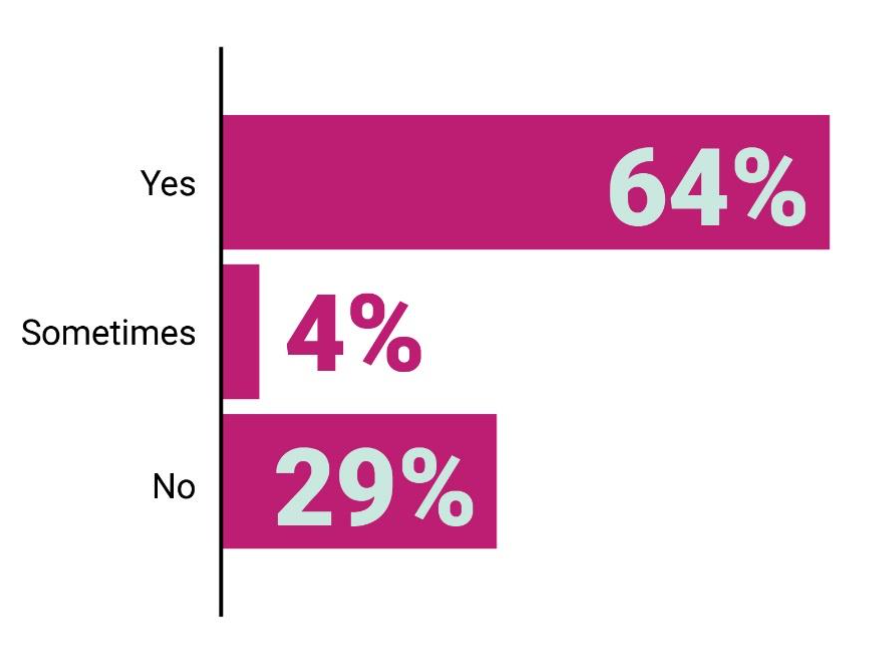
Deaf identity
People were asked if they identify as a Deaf person. Here are some of the responses.
- 89% did not identify as a Deaf person
- 9% did identify as a Deaf person
Gender
Most people who did the survey said they were women. Here are some of the responses.
- 72% said they were women
- 23% said they were men
- 3% said they were another gender or non-binary
2SLGBTQQIA
People were asked if they identify as 2SLGBTQQIA. This means people identify in the Two-Spirit, Lesbian, Gay, Bisexual, Transgender, Queer, Questioning, Intersex and Asexual community. Here are some of the responses.
- 81% did not identify as 2SLGBTQQIA
- 16% did identify as 2SLGBTQQIA
Age
People who did the survey were between 16 years old to over 75 years old. Here are the responses.
- 4% were between 16 and 24 years old
- 13% were between 25 and 34 years old
- 20% were between 35 and 44 years old
- 25% were between 45 and 54 years old
- 25% were between 55 and 64 years old
- 10% were between 65 and 74 years old
- 3% were older than 75 years old
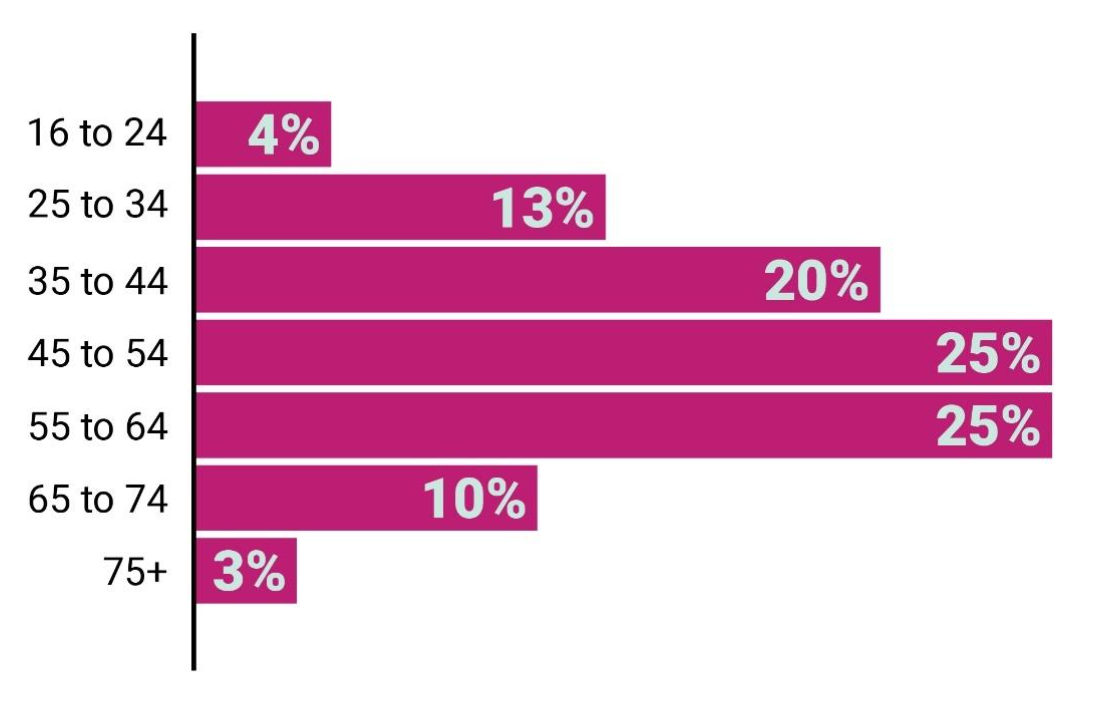
Race and national or ethnic origin
This question had a list of ethnic and racial backgrounds. People were asked to choose the ones they identify with. They could pick more than one answer. Most people who took the survey were White. Here are the responses.
- 70% were White
- 4% were Indigenous
- 2% were South Asian
- 2% were Black
- 1% were Arab
- 1% were Latin American
- 1% were Chinese
- 5% identified as 'other'
- 14% preferred not to answer or did not self-identify
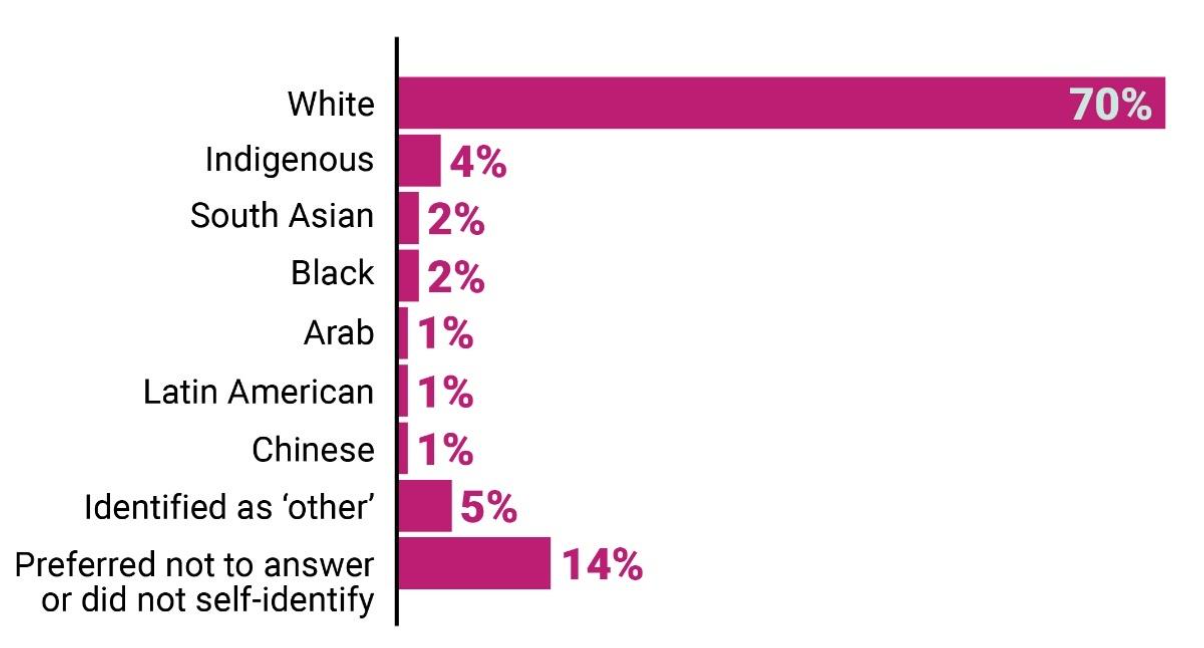
There was another question for people who said they were Indigenous. They were asked to choose from a list of Indigenous groups. Half of the Indigenous people who took the survey were Métis. Here are some of the responses.
- 51% were Métis
- 29% were Status First Nations
- 12% were Non-status First Nations
- 5% were Inuit
Language
Most people took the survey in English. A very small number did it in French or Sign language. Here are the responses to this question.
- 93% in English
- 4% in French
- 2% in American Sign Language
- 1% in Langue des signes québécoise
Province or territory
Almost half of the people who did the survey were from Ontario. Many were from British Columbia and Alberta.
There were small numbers of people from the other provinces and the territories. People from New Brunswick, Nova Scotia, Newfoundland and Labrador, and Prince Edward Island were grouped together as Atlantic Canada. People from the Yukon, the Northwest Territories, and Nunavut were grouped together as the Territories. They were grouped together because of low participation in the survey. Here are the responses to this question.
- 49% from Ontario
- 20% from British Columbia
- 11% from Alberta
- 8% from Atlantic Canada
- 6% from Quebec
- 5% from Manitoba and Saskatchewan
- 1% from the Territories
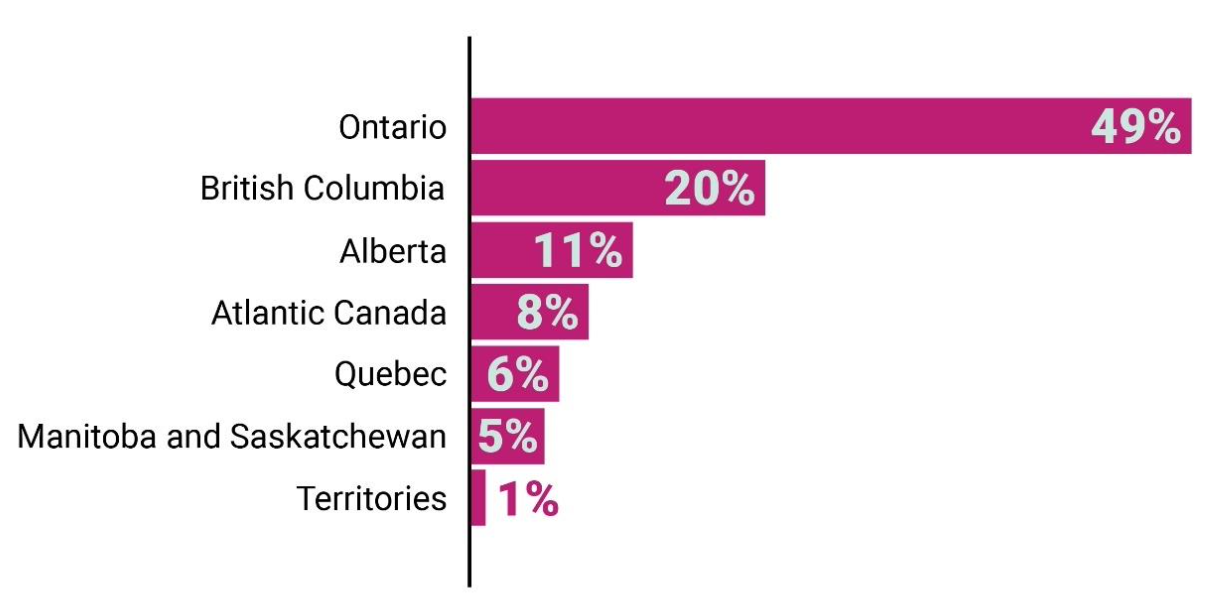
Most people who took the survey lived in a city. Some lived in a rural or small community. Here are some of the responses.
- 70% live in a city
- 17% live in a rural or small community
- 0.5% lived in an assisted living home or in long-term care
How people filled out the survey
Almost everybody did the survey on an electronic device. A little more than half the people did the survey on their home computer. Here are the responses to this question.
- 54% did the survey on their home computer
- 40% did the survey on their smartphone
- 6% used an 'other' method, such as a tablet or a borrowed computer
Main daily activities
People were asked how they spent their days. They could choose more than one answer. They could pick from a list of six different activities. They could also answer that they did something that was not on the list.
Most people said that they were working at a paid job or running a business. A very similar amount of people said they were not working because of their disability or because they are sick. Many people said they did things that were not on the list. Here are the responses to this question.
- 34% were working at a paid job or running a business
- 31% were not working because of disability or sickness
- 18% were providing care to family or friends for a health condition
- 17% were doing household work
- 14% were doing volunteer work
- 12% were caring for children
- 35% listed other activities
Other activities included many different things. Some people were doing advocacy activities. Some people had part-time jobs. Some people were self-employed. Some people were looking for work. Some people were on medical or long-term disability leave. And some people were working on personal projects.
(Respondents were allowed to select more than one answer, so percentages add up to more than 100%.)
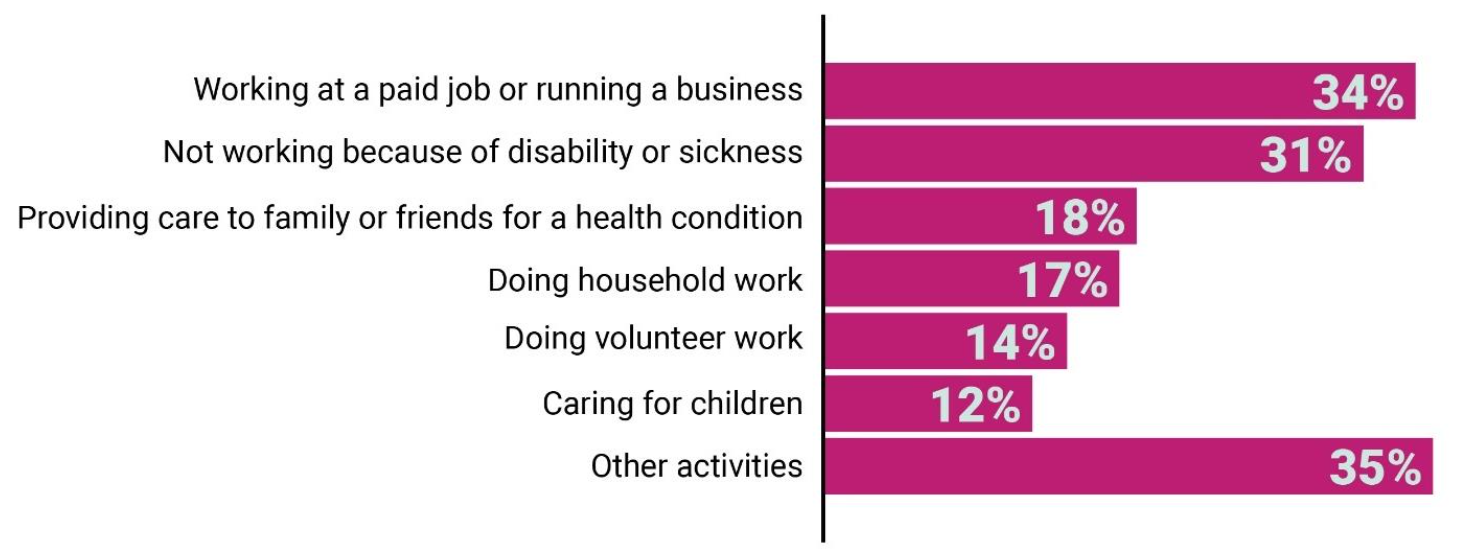
Who took part in the chat sessions?
In addition to the survey, we also held online chat sessions. There were 54 people who took part in these sessions. We asked them to answer some questions about themselves, if they wanted to. There were 41 people from the chat sessions who did answer these questions. Here are some of the responses to those questions.
- 83% identified as having a disability
- 9% identified as First Nations, Métis or Inuit
- 46% said they lived in Quebec
- 34% said they lived in Ontario
The full record of the responses to the questions asked in these chat sessions can be found in Appendix C.
4. What people shared
4.1 Foundations of monitoring
a) Familiarity with the Commission, the Convention and the Accessible Canada Act
We wanted to find out what people might know about monitoring. We asked people if they knew about the following things.
- The Convention on the Rights of Persons with Disabilities
- The Accessible Canada Act
- The Canadian Human Rights Commission
Most people knew about the Commission (65%). A little over half knew about the Accessible Canada Act (56%). The Convention was the least known item (48%).
There were differences in awareness of the Convention across the country. People in Saskatchewan and Manitoba were the most likely to be aware of it (62%). People in Quebec were the least likely to be aware of it (31%).
The survey showed that there is still a lot of work to do to raise awareness. The sections below have more information that people shared. The full record of the responses discussed in this section can be found in Appendix C.
Figure 1. Familiarity with the Commission, the Convention and the Accessible Canada Act
Before today, how much did you know about the following? (Data represents responses from online survey participants who chose “Very familiar” or “Somewhat familiar”)
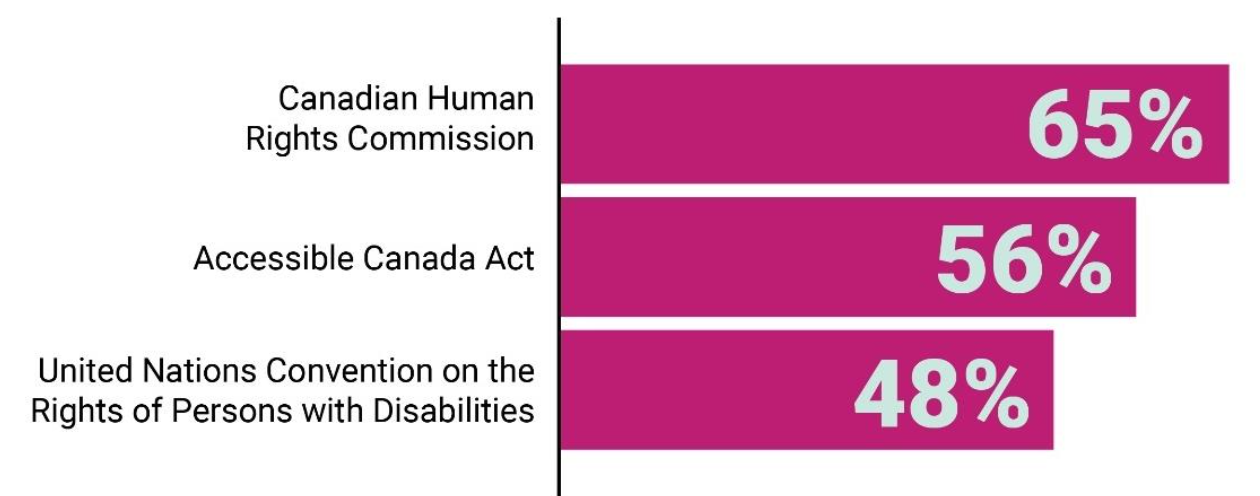
People told us some of the reasons why the Convention might not be well known.
- It uses legal language. It can be confusing and hard to understand.
- It is hard to keep up with how the Convention is being followed in Canada.
- It is hard to find out how the Convention affects people's day-to-day lives.
- The media does not often have news about disability rights.
- The media does not have news about this Convention.
People said that Canada needs to do a better job to promote the Convention. The public needs to know about the rights of people with disabilities. The public needs to know what it means to follow the Convention. Canada has to make sure the rights in the Convention are respected.
Outreach and education about the Convention will help. People in both the survey and chats said this. They also said that people with disabilities need to be involved to get this done. The groups that advocate for people with disabilities also need to be involved.
“We need to know that the Convention exists. The general population needs to be more familiar with it.” – Dialogue session participant
b) Rating how well Canada is doing
People with disabilities said that they need to feel that their lives matter. They want to see the Convention put into action. They want Canada to do a better job.
We asked people to rate how well Canada is doing when it comes to the human rights of people with disabilities. We asked them about these rights being protected and promoted. Here are the responses to this question.
- 17% felt that Canada is doing very well or good at protecting the rights of people with disabilities
- 14% felt that Canada is doing very well or good at promoting the rights of people with disabilities
There were differences in the answers to this question across the country. Less people in British Columbia think that Canada has done a good job in these areas (10%). More people in Quebec think Canada has done a good job in these areas (23%).
Overall, many people across Canada felt that Canada has done a very poor job at both protecting the rights of people with disabilities (29%) and promoting those rights (28%).
Figure 2. Questions to think about: How Canada is Doing
Overall, how do you feel Canada is doing in protecting or promoting the rights of people with disabilities? (Data represents responses from online survey participants who chose “Very well” or “Good”)

c) Effect of the Convention on the lives of people with disabilities
In the survey, we asked people a very similar question two times. We asked one question early in the survey. This question was about the positive effect of the Convention on the lives of people with disabilities. We asked another question later in the survey. This question was about the positive impact of the Convention on their own lives in the future. People were not as positive in the second question. Here are the responses to those questions.
- 54% felt that the Convention will have a positive effect on the lives of people with disabilities (first question, early in survey)
- 46% felt that the Convention will have a positive impact on their own lives in the future (second question, later in survey)
d) Partnerships
Almost everybody who took the survey said the Commission should partner with others (92%). This includes people with disabilities and community groups. Together, we can make sure Canada keeps its agreement. We will work together to make sure Canada follows the rules of the Convention.
4.2 Guiding principles for monitoring
As we start our monitoring work, we want to make sure the dignity and rights of people with disabilities guide what we do.
We told people about the four main principles that will guide our work.
- Participation
- Accessibility
- Equality and non-discrimination
- Intersectionality
A principle is an idea that represents what we find important. It describes our values. The Convention contains many principles about how people with disabilities should be treated.
We asked people to tell us what these four principles mean to them. We asked them how they would like to see the principles incorporated into our work – both how we monitor, and what we monitor.
Many people shared their everyday experiences and barriers as a person with a disability. This helped us to understand where we need to do better when it comes to each of these principles.
The following section describes what they told us. The full record of the responses discussed in this section can be found in Appendix C.
a) Participation
Participation means being able to take part in something. It means people are active and involved. This could be in an activity, event, project or program. It also means consulting with people about an issue or topic. It means people, groups and organizations are all included. We will follow the principle of participation in our monitoring work.
Almost everyone agreed about who needs to be involved in monitoring the Convention. The most important group is people whose lives are affected by disability. People said this group must be involved to help monitor the Convention. They also said that no disability groups should be left out.
Many also agreed that people with disabilities must have a meaningful role. They said these roles must happen at all stages of the monitoring process.
Many people also said they wanted to take part in the monitoring process. These results show the interest in taking part.
- 66% said they were interested
- 39% said they were very interested
- 77% in Alberta said they wanted to take part
- 49% in Quebec said they wanted to take part
Several people said there was another principle to follow. They said that 'Nothing about us without us' needs to be followed. This means that people with disabilities need to be involved. People felt this was a key principle to remember when we monitor the Convention.
Being represented
People told us to include all people with disabilities and groups in monitoring the Convention. They said to make a special effort for some groups. This includes people with invisible disabilities, mental health disabilities and Deaf people. People said these groups may face additional challenges. They may not have devices that can help them. They may not be able to afford these devices.
We also heard that other groups need to be involved. This includes the following people.
- Young people
- Older people
- People with disabilities in the north and in rural and remote communities
- People in long-term care
- People in institutions
There were some suggestions on how we could find and contact people with disabilities.
- Use information from disability support programs
- Use information from accessible parking permits
- Set up a hotline that would collect information about disability barriers
“You need to engage every disability in Canada and listen to the clients (and) the hardships they face daily to be able to improve life for them.” – Online survey participant
Barriers to participation
We wanted to know why people could not take part. We wanted to know why they were not included. We wanted to know why they were left out of the decisions that affect them. We also wanted to know why parents were not involved in decisions about their children with disabilities. We asked people to share examples of what kept them from participating in decisions that affected them.
Figure 3. Guiding Principles: Participation
(Top five responses from the online survey)
In this question, we are asking you to share any examples from your life where you were not able, comfortable or asked to take part in decision making about an issue that affected you.
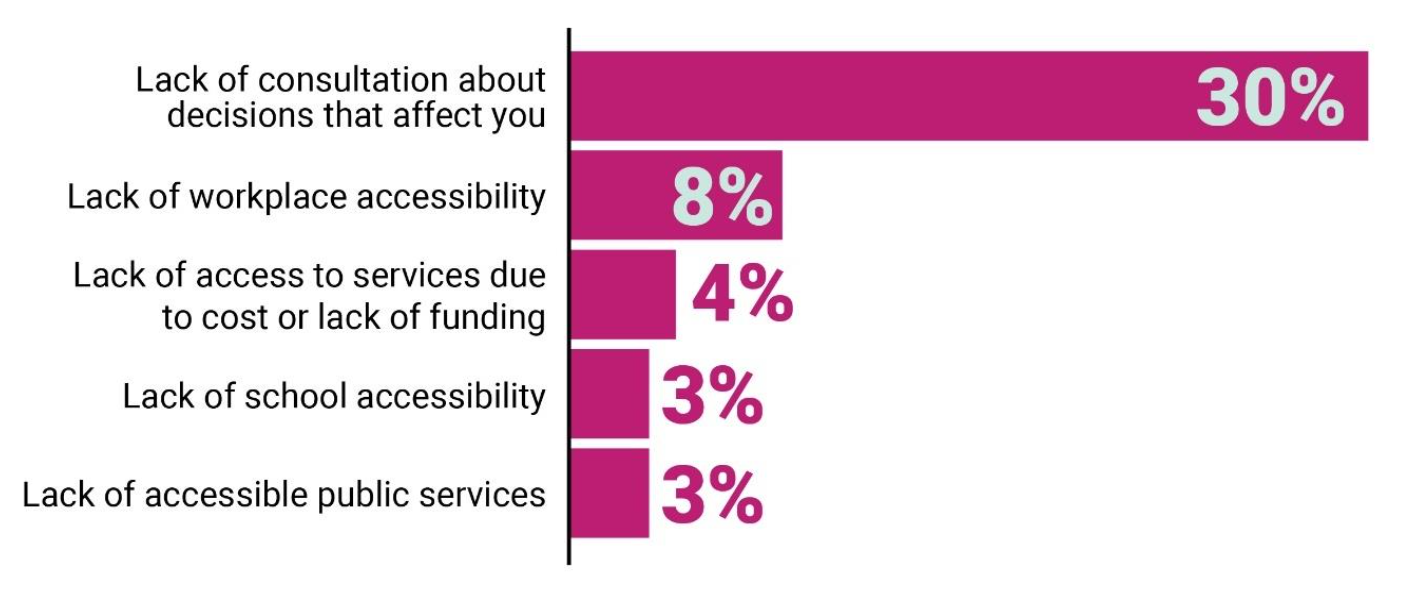
Our survey showed that most people were not asked any questions (30%). They were not consulted. Nobody talked to them. They also said that leaders and decision-makers do not listen to them when they do talk. This was a very common answer so we looked at the examples in more detail.
These are some of the experiences people had when they were not consulted. They said they were not consulted before buildings and spaces were changed. They said this caused accessibility problems. This happened in businesses and at housing and healthcare buildings. After, people with disabilities have to do the work to make the spaces accessible again. This has been worse during COVID-19. Many places have new entrances and exits. There are new dividers and caution tape. Many places also have new rules on how they operate.
Some of the barriers we heard were about jobs and working. Again, this happened when decisions were made without consulting people with disabilities first. They could not do their jobs well because of this. People gave us the following examples of this.
- Some employers do not provide Sign language. This means that Deaf and hard-of-hearing employees miss important information.
- Some employers hire consultants who do not understand accessibility. This means people with disabilities do not get the right accommodations.
- Some employers change the layout of offices. They do not talk to employees with disabilities before making these changes. Workers can experience negative effects from these changes. Some people with chemical sensitivities, or autism, or attention deficit disorders may be affected.
- Some employers set up equipment without talking to employees with disabilities. A printer can be placed out of reach for workers in wheelchairs.
- Some employers buy work items without talking to employees with disabilities. Something as simple as buying a new type of garbage can could be a barrier. It could be too tall or have a foot pedal to open it. This can be a barrier to some employees.
“People always make decisions that affect people with disabilities without consulting them. It's quite disgusting really. It's as though they think if one part of our body or brain has trouble, we are automatically stupid and have no awareness of what's going on. Either that or they just flat out have no respect for us as human beings.” – Online survey participant
We heard some other examples of how children with disabilities are not represented in decision-making and consultations that directly affect them. These had to do with students with disabilities. Parents and caregivers gave the following examples.
- Parents of children with learning disabilities said that schools do not involve them in decisions about their child's education. They said that they are not included.
- One parent said that the special bus service for their child was stopped. Nobody was asked about it first. Their child lost their door-to-door transit to school. They also lost their bus aide.
- Another parent told us their child is not able to speak. They are not treated the same because of this. School staff think the student cannot make decisions. But the student can make their wishes known.
We also heard about other barriers to participation. Some people with disabilities said they cannot take part because they could not get the accommodations they needed to complete their job successfully (8%). Some people with disabilities said they cannot take part because they don't have enough money to pay for the supports they need. For example, people shared stories of how some children with disabilities could not take part in school activities outside of the classroom. There was not enough funding for support workers. This meant that students with disabilities did not get included. Other people could not participate because they were worried about negative attitudes. They were afraid of the bad outcome that might happen if they spoke up.
b) Accessibility
Accessibility is another key principle. It means people with disabilities can do things without barriers. It means they can get into buildings and places. It means they can get and use information. It means they can do things in a similar way as people without disabilities. It means taking about the same amount of time and effort to do everyday things like paying bills or going to school or work. We will follow the principle of accessibility in our monitoring work.
We asked people to tell us about the barriers they face every day. We asked them for examples to help us understand. This will help us to include them in the monitoring work.
Figure 4. Guiding Principles: Accessibility
(Top five results from the online survey)
Can you think of any examples from your life where you faced barriers to taking part in an activity?
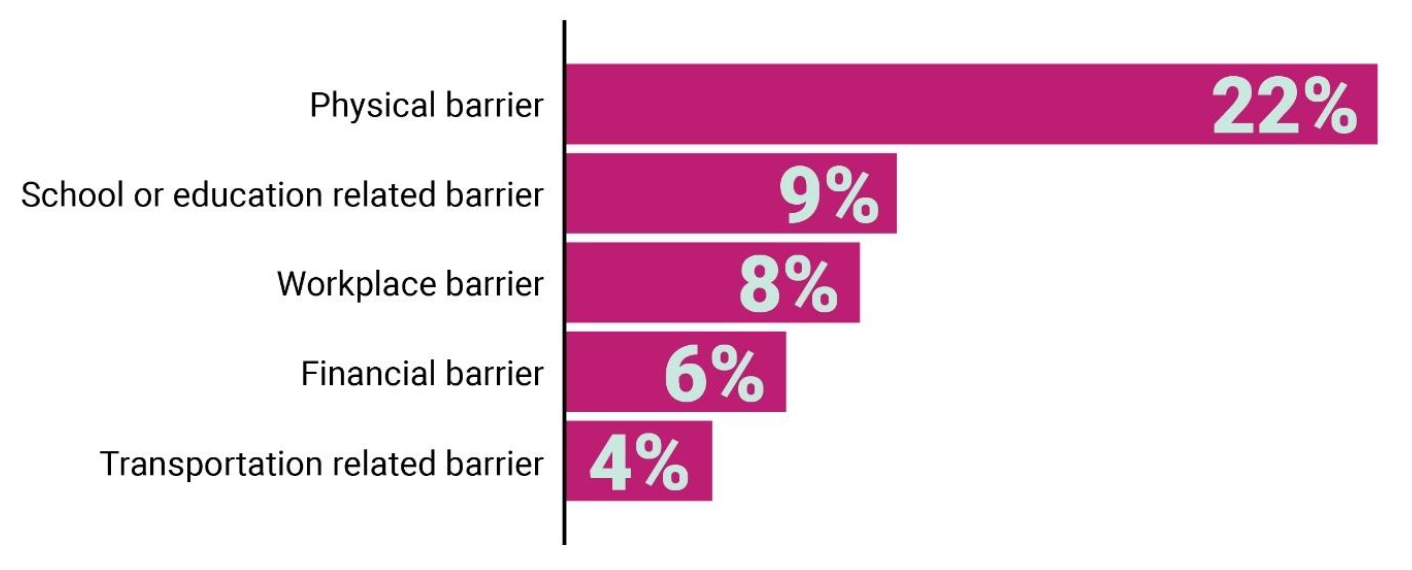
Common barriers
We heard about a lot of different barriers. The most common are listed below.
- Physical barriers in buildings and public spaces (22%)
- Barriers and challenges in school or the classroom (9%)
- Barriers in the workplace (8%)
People also said they have barriers related to money and transportation.
Some people had different experiences than others did. People with mental health disabilities told us about this. Their disability is invisible. Because it is invisible, they said other people did not consider them to have a disability. They said they don't feel like they are taken into account even though they still experience barriers. They said they can have barriers that stop them from using public transit. They said crowded places can be a barrier. They also said they have barriers that make it hard to get a job or join a group.
More detailed examples of common barriers are described below. These examples show how barriers are connected and related to each other.
Physical barriers in buildings and public spaces
People told us about barriers in buildings and public spaces. Here are some examples they gave.
- Accessible buildings can have meeting rooms in far parts of the building. People with disabilities find it hard to get to these rooms.
- Some accessible buildings are blocked off in the winter. Snow and ice can stop people from using ramps and paths.
- Medical offices often cannot accommodate people in wheelchairs. They do not have lifts and tables at the right height. People cannot be examined properly.
- Many accessible public washrooms can still be hard to use for people with disabilities.
- There are not enough gender-neutral washrooms. This can be uncomfortable for people with disabilities who have a support worker with a different gender.
- There are not enough accessible seats in public spaces. This makes it hard for people with disabilities to go to sports and cultural events.
Line-ups are also barriers. Many people with disabilities can't wait in a line for a long time. COVID-19 has made this worse. There are limits to how many people can be inside at one time. This can cause long line-ups in many places.
School or education related barriers
People told us about barriers in school and education. Again, this situation has gotten worse since the start of COVID-19. Many schools tried to accommodate students with disabilities. But some students with developmental disabilities did not get the support they needed for online learning. Those students fell behind in their studies.
Here are some other examples of barriers related to school.
- Some students cannot go on day trips. There is not enough support available at school. In one case, an elementary student could not go on a trip to the zoo. There was no one to support her. The parent asked to be her support person. But the school refused.
- Students with disabilities who have support workers can have additional barriers. Their parents often have to pay for two places in summer camps. They have to pay for their child and the support worker.
This shows how barriers at school can affect parents as well as students. Another example we heard was about a graduation ceremony. It was held in a courtyard. The accessible route was locked. No one could find the key. The student's father was in a wheelchair. He could not get into the courtyard any other way. He missed the ceremony and the chance for pictures.
“[My son] is often not provided adequate options for education. None of the school programs work for him and inclusion as it is right now is more accurately described as integration. Also, as a caregiver, I have been excluded from the job market because there is no adequate access to childcare for my child who needs one-on-one support.” – Online survey participant
Workplace barriers
People told us about the barriers they face at work. We heard that people with disabilities were not accommodated. They did not feel like others understood their disability. People gave us the following examples of the barriers they face at work.
- They can't get the accessible tools they need to do their job.
- They can't get printed material in another format.
- They can't get forms that work with their accessibility devices.
- They can't get software that is accessible for blind or Deaf workers.
- They can't find low-sensory workplaces for employees with autism.
People also said they miss out on opportunities to network. Meetings and social activities can be held in places that are not accessible. Workers with disabilities do not have support to go to these events. This makes them feel like they are not a part of the team.
Financial barriers
People told us about the barriers they face when doing financial transactions. They told us about the following situations.
- At many stores, payment machines are fixed on the checkout counter. This makes it difficult for people in wheelchairs to use them.
- Automatic Teller Machines (ATMs) are also at a fixed height. Some ATMs that are not linked to specific banks may be less accessible.
Some credit and debit cards are not in an accessible format for people with visual disabilities. This means that they must share their PIN or security code if they want to use them. As a result, they lose the fraud protections that come with their cards.
Transportation related barriers
People told us about transportation barriers. They had to wait hours to book an accessible ride. They had to go long distances to get to a bus stop. They can't get picked up or dropped off at their homes. Many communities do not have disability transit services.
Voting barriers
People told us about barriers to voting. They talked about some of the areas above. They said some of the buildings used for voting were hard to access. They also said many places do not have seats for people who have to wait in line.
People also told us about the barriers blind people experience when it comes to voting. There is no system that allows them to vote in secret. This includes electronic or online voting systems. They can't get documents in formats they can use. The websites around voting don't work with screen readers. Advance voting stations don't have Braille templates or other accessibility tools. This makes it hard for blind people and others with disabilities to vote in advance.
Suggested actions
People said accessibility was very important. They made the following suggestions to remove barriers.
- Make buildings more accessible.
- Improve the signs in buildings.
- Improve the entry in buildings.
- Provide education and support on how to accommodate people with disabilities. This could be provided to managers and school staff.
- Give people with disabilities more money to live.
- Give people with disabilities free public transportation.
People said it was very important to make sure that people with disabilities are able to access services and materials. This will help people take part in school and work and voting.
They also said accessible information is important. This means having formats like Braille or plain language. This helps people to be included.
c) Equality and non-discrimination
Another principle that will guide our work is equality and non-discrimination. This means that all people are treated equally and fairly. It means that all people have the same rights. It means that people are not discriminated against in any way.
We heard about many situations where people with disabilities were not treated equally. People with disabilities face these situations in their everyday lives. This adds to the participation and accessibility barriers described above.
We asked people to describe these experiences. We asked them to tell us how they were discriminated against because of their disability. We wanted to understand how this could also affect them in taking part in the monitoring work.
Figure 5. Guiding Principles: Equality and Non-Discrimination
(Top five results from the online survey)
Can you share any examples from your life where you were not treated equally or discriminated against because of your disability?
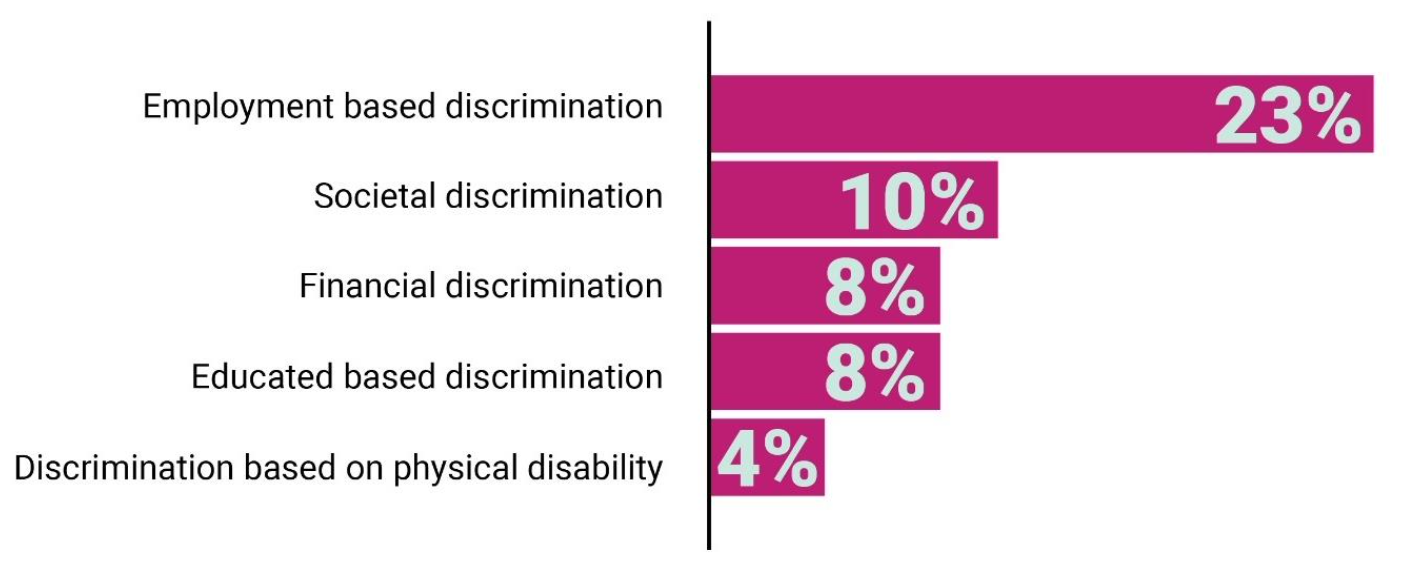
Almost one-quarter of the responses were about experiences in the workplace (23%). Other examples were about experiences in public or the broader community (10%). For example, we heard about people who were refused an apartment because of their disability. We also heard from people who feel rejected by their community because of an invisible disability.
We heard other stories of people losing disability benefits. We heard about people being discriminated against in school. We also heard about people who were discriminated against because of their physical disability.
Further examples are described in greater detail and under common themes below.
Employment-based discrimination
We heard about many different kinds of discrimination in the workplace. People with disabilities said they could not get the accommodations or tools to do their job. People with invisible disabilities said they were isolated from their co-workers or managers.
We also heard that people with disabilities are discriminated against when they apply for a job. Several people said they were not considered after having an interview. This happened when the interviewer could see that they had a disability. Or it happened after the person told the interviewer about their disability.
Other people said they were not accommodated when applying for a job. For example, a person with a visual disability was not allowed to use a digital device at the interview. But people without disabilities could use a pen and paper to take notes.
Many people told us about job qualifications. Some of these exclude people with disabilities. An example was needing to have a driver's license. Another example was being able to lift 20 pounds. These qualifications were listed for an office job that did not need their workers to have those skills.
Some people gave examples of not being able to advance in their jobs. One person with a mental health disability told us that they cannot get promoted. Their supervisor does not think they can do the job. They were not given a chance to show they could.
Another person had a disability that changed from invisible to visible. They worked at the same place for 10 years. They were told not to ask for accommodations at work for their disability. They were told that this would make it hard for them to get a promotion in the future.
“Being autistic, you learn from a young age to keep it as hidden as you can, to avoid being bullied and abused. It doesn't change when you're an adult and applying for jobs. It's terribly risky to disclose that you are autistic when interviewing for a job. Many automatically think you're stupid, regardless of how many intelligent conversations you've had with them previously.” – Online survey participant
We also heard the following experiences of discrimination in the workplace.
- Several people told us that they have to use their vacation days for medical appointments. They were not allowed to use their sick days.
- Another person told us they were not allowed to take a break after a panic attack. They were not given time off to go to therapy appointments.
- Many people said they were bullied or teased at work. This was done by their co-workers and was because of their disabilities.
- Many people felt ignored or avoided. This was because they needed accommodations for fatigue, pain or nervousness.
One man who uses a wheelchair told us about his experience. He was in an elevator at work. Another person without a disability pulled his wheelchair out of the elevator. They said it took up too much room. Because of this, the man who uses a wheelchair missed his taxi ride to a medical appointment.
Stigma and societal discrimination
People with disabilities told us about their experiences in public. They told us about being disrespected. They told us they were made to feel uncomfortable. Here are some examples of their experiences.
- One person said they often feel left out and unwanted. This is because of their mental illness.
- Another person with autism said they try to hide their disability. They fear people will treat them badly.
- Some people with disabilities said that they feel like the public has a bad opinion towards them. They feel they are seen as 'useless' or just looking for financial support.
- Some people with disabilities said they are made to feel uncomfortable when in public or eating in restaurants.
- Some people with invisible disabilities said they are often judged as lazy by others.
Several people told us about how they are treated when getting healthcare. They said doctors and healthcare providers assume they are not capable. They do not think people with disabilities can be fully involved in decisions about their own care and treatment.
One example came from a person who is a paraplegic. They had broken their leg. The doctor treating them was not concerned if the leg did not set properly since they “couldn't walk anyway.” The person had to explain to the doctor that it was important. They had to explain how it would affect their ability to do other things like get into a car, or use a toilet, chair or bed.
Another example happened in a bank. A couple who are both blind had already been approved for a mortgage. But when they met with the bank official, the bank withdrew the approval.
We heard that people with disabilities can be ignored or talked down to by others. This happens when they try to go to school, or get a job, or seek services from government agencies.
Marital status and financial discrimination
We heard many examples about disability support programs across Canada. These programs can discriminate against people with disabilities in relationships. This happens when they marry or move in with a person without a disability. Many programs will reduce or stop support payments when a person has a partner. This can affect people a lot. It affects them more if their partner is also on low income. This can put them at risk of not being able to afford their housing or other expenses like food.
One person said it is hard enough to date as a person with a disability. It does not help when people think they might be a financial burden to their partner. This makes having a long-term relationship more difficult.
Suggested actions
People said being treated fairly and equally is important. They said they experience discrimination and are treated unfairly in many important parts of their lives. They said there needs to be more public awareness of how people with disabilities are treated. They said that education and training is very important to change behaviours and attitudes. They made the following additional suggestions to improve this area.
- Teach people about accommodations. Teach people about support. Let them know why these are important for people with disabilities.
- Train teachers and bosses. Show them how to accommodate people with social or sensory disabilities.
- Raise awareness about the challenges people with disabilities face every day.
- Raise awareness about how people with disabilities can make their own decisions.
Many people said that more funding is needed. This could help improve public places, workplaces and schools. This will help to accommodate people with disabilities.
d) Intersectionality
The principle of intersectionality will also guide our work.
Intersectionality is a word used to describe an idea. The idea is about different parts of people's identity. A person's identity includes a lot of things about them. It can include their disability, gender, race or age. It can include their sexual orientation and other parts of their identity. A person's identity also includes the situations they live in. This can include living in poverty or having a low income. The idea of intersectionality says that all these different parts of a person's identity combine, or intersect, with each other. And that people are treated unfairly because of more than one part of their identity or living situation. We wanted to learn more about this. We asked people to give us examples of being treated unfairly because of their identity or situations they live in.
Figure 6. Guiding Principles: Intersectionality
(Top five results from the online survey)
Can you think of any examples from your life where you felt you were treated unfairly because of the combination of factors related to your identity?
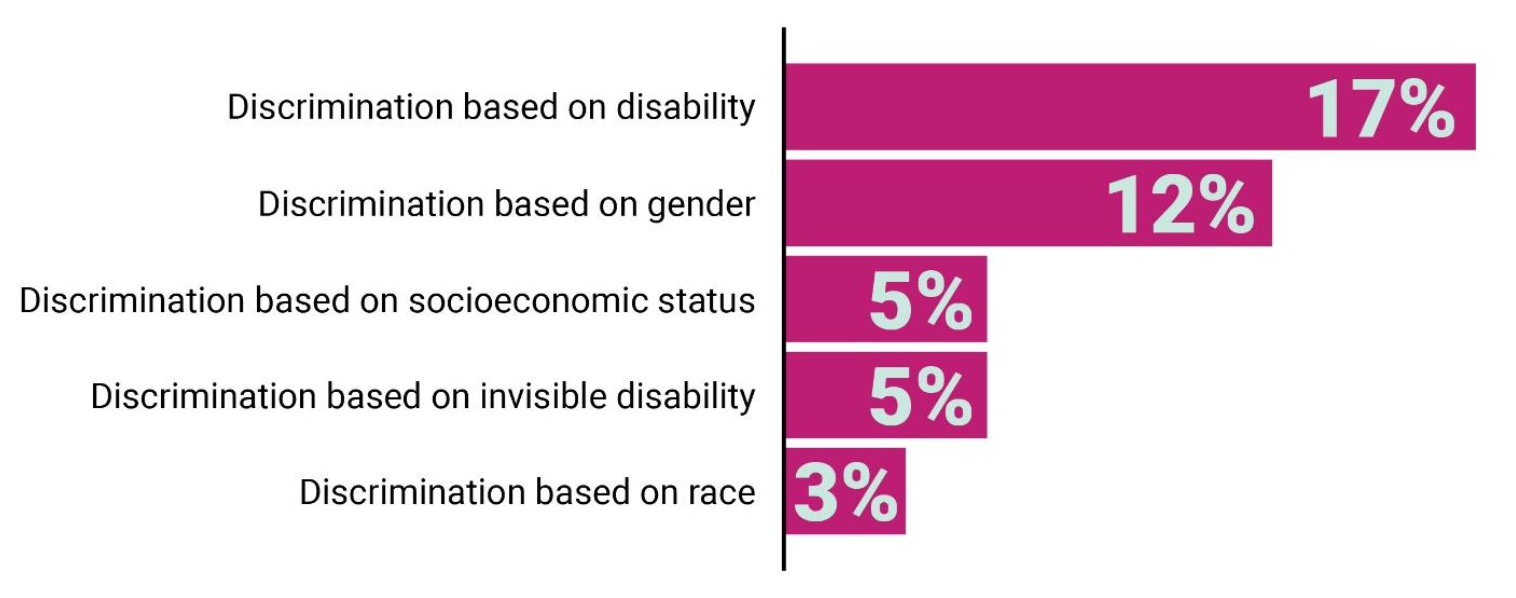
Almost one in five people said they were treated unfairly because of their disability (17%). Many women also gave us examples. They said they felt unsafe because of both their gender and their disability. There were also examples based on invisible disability. Many people with disabilities also shared stories of being discriminated against because they live in poverty.
We heard many examples of people being treated unfairly based on their disability and other identities or situations. They are described in more detail below.
Multiple disabilities
We heard from people with more than one disability. We heard that people with multiple disabilities often can't get help from service providers. They were not listened to or were considered 'difficult.' They told us it was hard for them to get a job. Employers thought that they would need too many accommodations.
They also told us that having more than one disability makes it hard for them to be outside of their homes. We heard the following examples.
- Some people have both Multiple Chemical Sensitivity and Electromagnetic Hypersensitivity. They are sensitive to Wi-Fi signals. This makes it hard for them to be outside their homes.
- A blind person with chronic pain and anxiety told us they hardly leave their home anymore. They find the stress of being outside their home too much to take.
We also heard how people with multiple disabilities are not able to take part in activities. One example came from a Deaf person with an intellectual disability. They were not able to take part in many activities. This is because there are not enough Sign language interpreters. Also, there are not enough support workers who understand Sign language. Another person said that they couldn't take part in most live events. This is because they have limited mobility. They also have an eye disease that makes them low-vision and sensitive to electronic screens.
Gender
We heard from many women who felt more unsafe because of both their disability and gender. Here are some of their examples in more detail.
- One woman told us she was concerned about getting help around her home. She was worried someone would take advantage of her.
- One woman said she is often treated like a child. Other people treat her as if she is non-sexual or asexual. She said that many people assume that women with disabilities are not capable of making their own life decisions.
- One woman with an invisible disability said she was concerned about disclosing her disability. It would put her at a higher risk of being abused by men.
Several women with disabilities said doctors and health professionals do not listen to them. They were called 'hysterical' or 'neurotic.' One woman went to a doctor because she was dizzy. The doctor told her it was because she was “over breathing, a lot of women do it.” In reality, the woman had a condition called anemia.
One woman said that men with disabilities are more likely to be taken seriously when they assert their rights. She said that when women do the same thing, they are often seen as 'pushy.'
2SLGBTQQIA
We heard from people with disabilities who are 2SLGBTQQIA. This means they identify as Two Spirit, Lesbian, Gay, Bi-sexual, Transsexual, Queer, Questioning, Intersex, and Asexual. They said they are discriminated against. They said they did not always know the main reason why. It could be based on their disability. Or it could be based on their sexual orientation.
Others told us that their sexual orientation does add to the discrimination they face. They said they are denied services. They said this happens when they do not fit into the categories needed for services. One person with autism said they hid their disability from health care professionals. They did this to avoid doubt about their capacity to make decisions. They were getting gender-affirming health care.
Another person told us that there are people who accept their disability but not their sexual orientation. This makes it hard for the person to feel comfortable around those people.
A Deaf man told us he was not able to go to events at the only gay bar in his city. This was because there were no Sign language services for the events and shows at the bar.
“I can speak from my experience as a Deaf person who is also gay and not born here. It's a triple threat of barriers thrown at me. I have to hide my truth to live and work. I feel discriminated daily for being the person that I am. It's exhausting to hide. It's exhausting to feel afraid.” – Online survey participant
Poverty
Many people with disabilities told us why they are living in poverty. Many could not work. Those on disability support said their payments are too low. They said this makes it hard to afford to buy the accessibility devices they need. It also makes it hard to afford clothes and transportation. It makes it hard to take part in activities that have membership fees.
“I'm disabled, homeless and hungry all the time. I can't think about anything else.” – Online survey participant
Race and National or Ethnic Origin
We heard some examples of discrimination based on race and national or ethnic origin. A Canadian woman of Filipino descent told us of an incident. It happened to her and her family when they were walking their dogs. They had rocks thrown at them. This happened after the start of the COVID-19 pandemic. She believes this happened for two reasons. One reason was her disability. The other reason was her and her family being identified as being of Asian descent.
Another woman said she is often treated differently when she speaks up for herself. She believes this is because of her race, gender and disability.
Some parents told us about discrimination against their children with disabilities. This happened in their schools and with government services. This was in part because of the colour of their skin.
People who moved to Canada also faced barriers. They said it was difficult to get Sign language services from agencies that provide services for people who move to Canada.
Age
We heard that age also affects people with disabilities. It affects both young and old people with disabilities. For example, a woman with disabilities said people used to listen to her. But as she has grown older, this has changed. Many people now treat her as if she needs someone else to make decisions for her.
We also heard that the needs of children with disabilities are often ignored or played down by adults.
“My daughter has felt discriminated against because of her dyslexia and being a girl and being a child. There have been situations where the stress and anxiety she feels due to her [Individualized Education Plan] not being followed or being singled out and embarrassed by a teacher who doesn't believe in her disability, have been minimized because she's a girl who likely exaggerated or is having an emotional day, or because she's a child who doesn't understand the challenges of running a classroom.” – Online survey participant
Weight
We heard from people with disabilities who identify as overweight. They told us about the barriers and discrimination they face. They said there are accessibility barriers in buildings. This includes no seating for larger-sized people. Many said their health problems were often dismissed. They were told to lose weight instead. This happened even when they had multiple physical, mental and sensory disabilities.
Some told us that they have a difficult time getting a job interview because of their weight. When they do get an interview, it is often shorter than other people who are interviewed.
Several people said they are insulted or made fun of by other people. This increases their anxiety or depression.
Language
We heard about people being discriminated against because of their language. One person with disabilities said it is hard to find accessible materials in French. Another person speaks French but is living in an English-speaking community. They experience verbal abuse. They also get negative comments because of the language they speak.
Suggested actions
We heard about the different kinds of discrimination people with disabilities experience. This discrimination is based on their identities and the situations they live in. People gave us the following suggestions to improve these experiences.
- More education and awareness about intersectionality and the different kinds of discrimination people experience.
- Teach people how gender, race and poverty can also affect how people with disabilities are treated.
- Improve financial support for people with disabilities. This would help give everyone the same opportunities no matter what their race or gender or financial situation is.
People said to give attention to the idea of intersectionality. It should be taken into account when important decisions are made that affect people with disabilities. Decision makers need to think about the different people that are affected by those decisions. People with disabilities need to be included when decisions are being made about them. People also shared that it would help if people who make decisions are as diverse as the people they make decisions for.
e) Other guiding principles
We asked people to tell us about any other principles that would be important to the monitoring work.
Overall, people said the most important additional principle was being able to get funding and financial supports. They thought this would give people with disabilities the best opportunity to live in dignity. It would allow them to more fully take part in decisions that affect them.
People also repeated the principle of taking part and being involved in decision-making. This is especially true when people with disabilities are affected by the policy or decision.
Other important principles included being accountable. Another one was enforcing the Convention and making sure it is followed. This would help make sure the rights of people with disabilities are protected and respected.
Treating people with dignity and respect was another important principle. Making sure accessibility is taken into account in decision-making was another important principle.
More examples of other guiding principles are described in greater detail below.
Inclusion
People told us it is important to see the difference between allowing people with disabilities to be in a space and making sure they can take part.
We also heard that inclusion should happen at many different levels. This includes at the individual and team level. It also includes in organizations and systems in society. These all have to be taken into account. They all have a role to play to address the barriers faced by people with disabilities.
Dignity and Respect
We were told to always assume that people with disabilities have competence. This means they have the ability to do things successfully and well. We were told that people with disabilities must always be valued and respected. We heard that they should be given the chance to show what they can do. We were told that more attention must be paid to their quality of life. This means looking beyond just meeting their basic needs.
Many people agreed that it was important to educate people without disabilities. This would help remove the negative views about disability. It would also make it clear what accommodations are. It would help others understand that people with disabilities do not get 'special treatment.' Education would help others to understand that accommodations are about fair and equal treatment.
People told us that there should be resources to do as much good for as many people as possible.
Consistent and equitable access to supports
We heard that people with disabilities should be supported at all stages of their lives. For example, we heard this from many people with autism. When they became adults, they no longer got the support they needed.
We heard that people want to be able to get the same supports and services across the country. Many pointed out that disability services are not provided by the federal government. They are provided by local governments. This means there are different levels of support. It means the rules are different between many communities.
Interdependence of rights
People said that the following were important things to consider.
- People with all kinds of disabilities need to be included.
- People with visible and invisible disabilities need to be included.
- No disability should be more important than another one.
People also said that rights are related and connected. The other rights of people with disabilities need to be taken into account. This includes the right to work or get an education. It also includes the right to choose where and with whom to live. All of these rights need to be upheld. When some rights of people with disabilities are not upheld, it affects their other rights.
4.3 Involvement of people with disabilities in monitoring
The Commission wanted to hear from people across Canada. We especially wanted to hear from people with disabilities. We also wanted to hear from organizations that advocate for them. We asked them how they wanted to be involved in monitoring the Convention. We wanted to hear what the monitoring could look like. The following sections provide details on the answers from both the survey and chat sessions. The full record of the responses discussed in this section can be found in Appendix C.
In general, people said they are not sure what 'monitoring' means. They are not sure what should be monitored. They do not know how the Convention is being carried out. This makes it difficult to be involved in the process. People wanted all of this clearly defined. They wanted clear direction about the monitoring and what will happen.
We also heard that the Convention is hard to read and understand. People said it would be helpful if the Commission made a version that is easier to read. This version should be clear on which rights are protected. It should show which level of government is responsible for each right. It should show who is responsible for enforcing those rights. This will help everybody to better understand the rights of people with disabilities and how they are protected. It will also show people where to report situations where the Convention is not being followed.
a) Interest
We said earlier that people want to take part in the monitoring. Most people were interested. Many people were very interested in being involved. Some people were not interested or neutral about being involved. Here is a summary of the responses.
- Interested – 66%
- Very interested – 39%
- Neutral – 14%
- Not interested – 12%
Even though people were interested, they did not know they could be involved. They do not know how to become part of monitoring. They said the Commission needs to actively seek out people to be involved. The Commission needs to let people know what is needed to take part.
People also told us what they think about human rights commissions. They said these places can seem too big and impersonal. People said it is important to make these spaces more accessible and approachable. This would help people to be involved in the monitoring. It would also help anyone who wants to contact a commission to get information or file a complaint.
b) Barriers to participating in monitoring
People with disabilities told us a lot about the barriers they face in their daily lives. We mentioned these earlier in this report. We also heard that COVID-19 has made many of these barriers worse. We heard that people with disabilities have to spend more time and energy to advocate for their needs. They said this may leave them with less time to take part in monitoring the Convention. Many people said it will be important to remove or reduce as many of these barriers as possible. This will help people with disabilities who want to take part to be fully involved.
c) Supports or resources required to facilitate participation
People told us it should be easy for them to take part in monitoring the Convention. They said that people need tools and resources to take part. The survey showed four main supports people need to take part in monitoring. People could choose more than one support.
- Training – 47%
- Financial resources – 40%
- Communications supports – 27%
- Human resources – 21%
These results were mostly the same across the country. People from Nova Scotia and Saskatchewan said that the most important resource for them would be financial. The full details of these results across the country can be found in Appendix D.
Figure 7. Involvement: Supports and Resources
(Top four results from the online survey)
Are there any supports that you would need to be able to take part in monitoring activities?
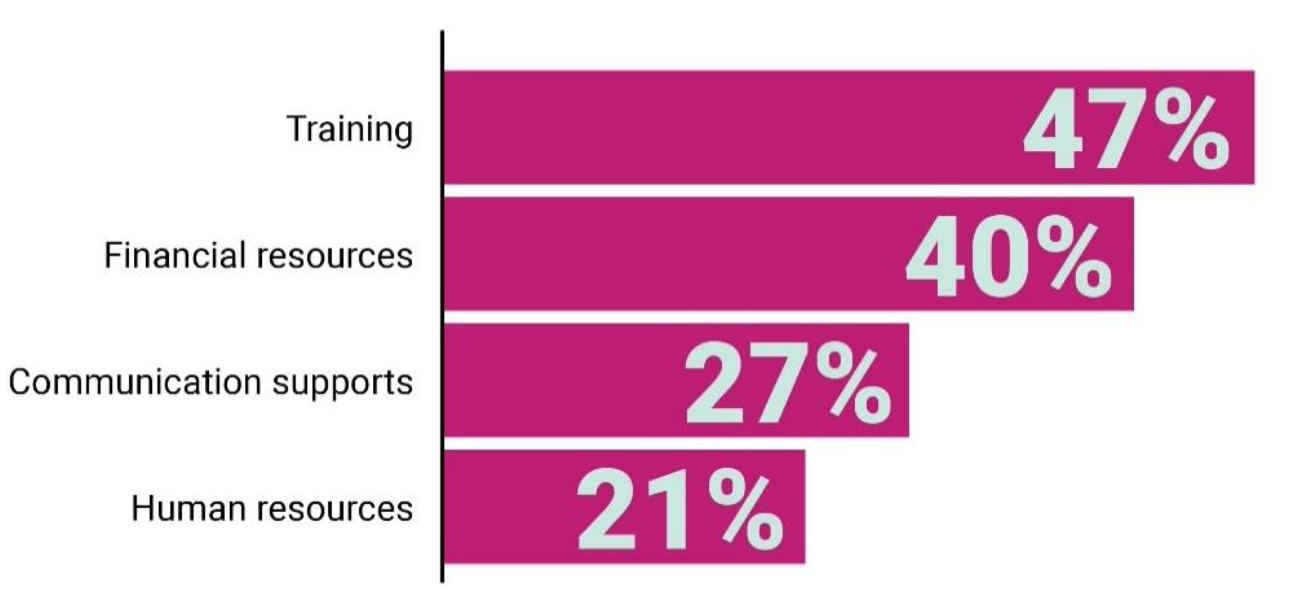
Training
People told us that they want to be trained. They want to learn what to monitor and how to do it. They said training needs to be accessible to all people with disabilities. They said it needs to be accessible to people with and without access to the internet. They said training needs to have clear instructions. It has to use simple language. It needs to show what is required. It needs to show how to report.
People told us that the monitoring work needs to be as flexible as possible. People should be able to take on specific tasks. They should be able to take on one-time tasks rather than long-term ones. People also need enough time to finish their work. This means having extra time that may be needed due to their disability or condition.
People said that if they were asked to be more involved, there were other things that would help. For example, they said bigger tasks should be broken down into smaller parts. This will help people to manage and finish their task. People should also be able to work from home if they want. People in rural or remote places may need to work from home.
If people are taking part in an office or another location, it needs to be fully accessible. This includes the following points.
- Appropriate seating for people with chronic pain
- Low-sensory environment
- Scent-free environment
- Located on a public transit route
“I believe that offering training and fair honorariums is the key. People with disabilities are often relegated to positions where they are underpaid and over-qualified. It is important to consider disability-related economic issues.” – Online survey participant
Financial Resources
Many people said that people with disabilities should not be asked to volunteer to monitor the Convention. Instead, they should be paid for their advice and expertise. They should have their expenses covered while doing this work. This includes for travel, meals, childcare, support workers and internet access.
Several people told us the cost of basic technology is too much for people with disabilities who live near or below the poverty line. They can't always afford a smartphone or tablet or internet access. They can't always access these services at libraries or schools. Many of these buildings are older and hard to access. Or they are not on public transit routes.
It was also suggested that people be given funds for expenses in advance. People may not be able to cover these expenses and wait to be paid back. This would be hard for people living on a fixed or low income.
“Why are we expected to do it all out of the goodness of our hearts? If you value it, pay for it.” – Dialogue session participant
Communication and Technology Supports
People generally agreed on the following points. The monitoring information should be available in both official languages. It should be written in clear and simple language. Many different people should be able to understand it. This includes people with intellectual or psychosocial disabilities. It also includes people who do not speak English or French as their first or second language. People told us that interpretation should be available. This includes having Sign language in English and French. There was also a suggestion to have information in other languages. This would reach groups such as people who move to Canada.
People said they wanted tools to help them monitor the Convention. They want to make sure all areas of the Convention are covered. This includes areas like access to buildings and services. It also includes areas like work and having enough income to pay for living expenses. They want tools to measure the progress and the shortcomings in all areas.
They said a toolkit should be made to show how to monitor the Convention. It should have a guide on how to give meaningful input. It should be in simple language and easy to understand. These tools should be accessible to people. One person suggested that the Commission create an online portal. One suggested a smartphone app. Others wanted offline tools. This would accommodate people who do not have devices or internet access. It would accommodate people who find it difficult to work online due to their disabilities.
We also heard that some people with disabilities have low levels of literacy. They can find formal writing hard to understand. We heard that there should be support to help people access websites. There should be support to help people record their needs or feelings. Some people said there should be 'mentors' or teachers available. This will help with questions and teaching the skills needed to do the work. It will also help with writing and editing reports. Some people said they would need a note-taker. Another said that it can be hard for some people with a physical disability to fill out a form. It can also be hard for people with anxiety. Other ways to get information besides forms should be available.
Finally, we heard that technology should be provided. This includes a computer or tablet for people with disabilities working from home. We also heard that this technology should be accessible to people with vision or hearing disabilities. There should be adaptive technology. This includes screen readers and voice recognition software. People should be trained to use the technology. There should also be technology support provided.
d) Roles people could see themselves playing
There are many roles for people and organizations in the monitoring process. Most people wanted to be informed and kept up to date about monitoring. In the survey, people could choose more than one role. Here are some of the roles and the amount of interest in them. These preferences were about the same across the country.
- Stay informed and up to date – 42%
- Review drafts of reports and give input – 30%
- Review and give input on data or information before reports are written – 30%
- Help make information accessible and engaging for people with disabilities – 28%
- Be an observer for a community or organization and report back to them on monitoring work – 27%
- Help to figure out how the monitoring work will be done – 26%
- Collect data and help to assess Canada's progress – 25%
- Write or help write reports – 19%
- Train other people with disabilities to do these roles – 16%.
Figure 8. Monitoring: The role of people with disabilities
(Top three results from the online survey)
Which of the following roles could you see yourself playing [in monitoring]?
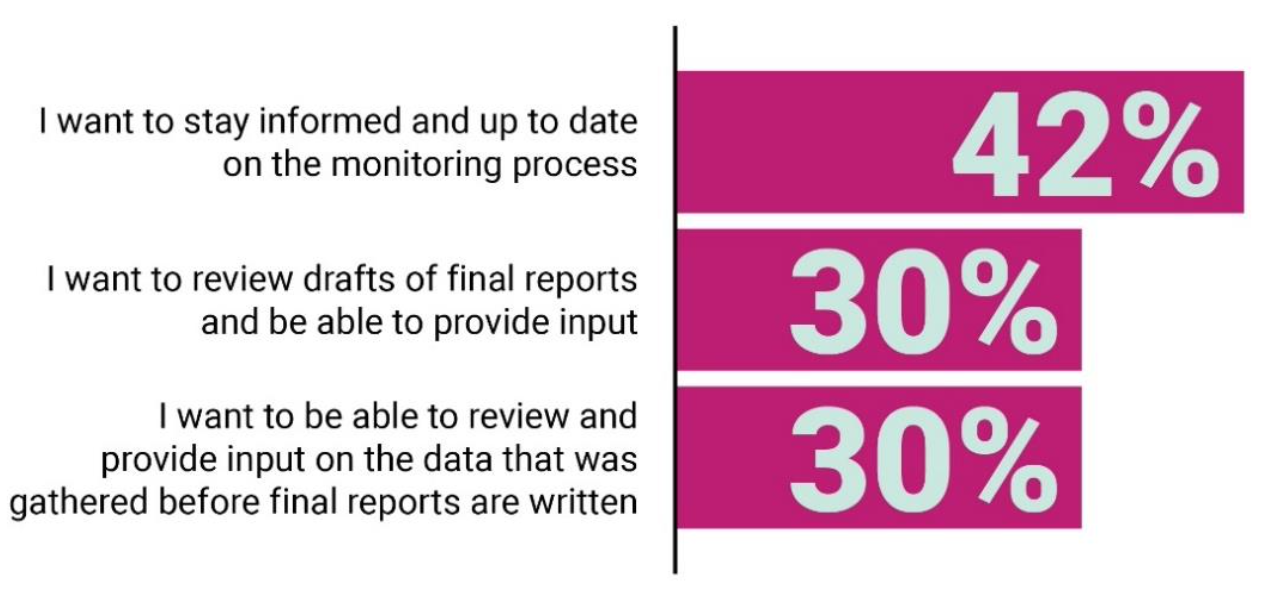
People shared other ideas about what their role could be in monitoring. They also shared other ideas on what could be monitored. We heard that people with disabilities want to report on their experiences. They want to be able to report on the barriers and discrimination they face. They want to report on the causes. They also want to know about the experiences of other people with disabilities. This includes both good and bad experiences. This will help to show if and where progress is being made. They also want to be able to compare experiences in different parts of the country. They want to track the effect of intersecting factors on people with disabilities.
Several people wanted the monitoring to look at the attitudes of people without disabilities. They wanted to know about their attitudes towards people with disabilities. They also wanted to look at Canadian media. They want to look at how movies and television shows portray people with disabilities.
We were told that a monitoring program should have a clear way to measure success. People with disabilities need to know what will happen if they report a breach of the Convention. They need to know how complaints will be followed up and resolved. They also want to be kept informed about how the Convention is being enforced across Canada.
Finally, people told us they need better information on the role of governments. They said there should be a copy of the Convention that is easy to understand. They said the Commission should make this version. It should clearly show which issues are covered by the Convention. There should also be information about who is responsible for the parts of the Convention. Here are the important questions that people wanted answered.
- What is the responsibility of the federal government?
- What is the responsibility of the provinces and territories?
- What issues belong to local or municipal government?
- What issues belong to other governments?
- Which departments, agencies or offices are responsible?
- How do people let governments know when the Convention is not followed?
The answers to these questions will make it easier to identify the goal of monitoring. It would help to keep all levels of government accountable. We also heard that people want to see the Commission do outreach to communities. This would be done by working with provincial and territorial human rights commissions.
e) Role of organizations that advocate on behalf of people with disabilities
We asked about advocacy organizations. We asked if they should be involved and how they should be involved. In the survey, most people who answered this question (13%) said organizations could play a role in communicating with, and informing, people with disabilities about monitoring activities.
But other people said these organizations should do more. Here are some of the things people said they should be doing.
- Directly involve people with disabilities in monitoring work – 10%
- Financially support people with disabilities to be involved – 6%
- Make sure documents and meetings are accessible – 3%
- Listen to people with disabilities – 2%
Figure 9. Monitoring: The role of organizations
(Top five results from the online survey)
What could an organization, such as those that represent people with disabilities, do to help you participate in monitoring?
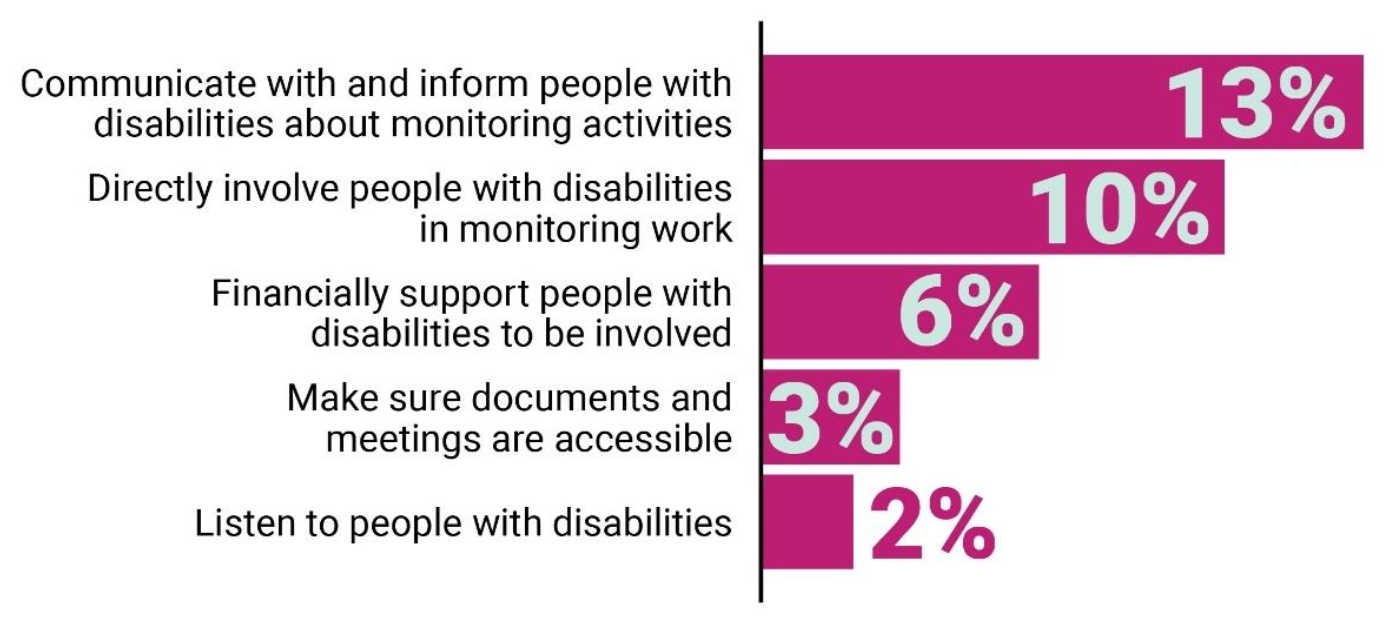
People also said they wanted to work together. This way, they can develop networks of organizations. These organizations could gather and share the information they collect. They could tell people how Canada is doing in following the Convention. Others want these organizations to do outreach and education programs. These would teach about the Convention and monitoring process. One person suggested that an independent party could evaluate the organizations. They could see how well they are doing in supporting people with disabilities.
Some people want peer support systems. These would be made up of people with disabilities who have been trained about the Convention and can answer questions about it. One person said this would not cost a lot of money to set up. They said peer support workers could help people with disabilities in their own community. They could find out the needs of people in the community and then help them get the tools to respond to some of their needs. People said peer support workers should be trained and paid for their work.
We heard an example of an immigrant agency that used this kind of peer network. People think that this kind of approach would be very helpful for some groups of people with disabilities. This includes people with disabilities who do not speak English or French. It also includes people with disabilities who are racialized.
Some people suggested that the Commission should help to bring people together. They suggested the Commission should help to set up disability advocacy groups. The Commission can also help set up networking opportunities. This could be done in communities across Canada. With appropriate supports, people with disabilities can come together to find solutions to the issues they face.
It was further noted that advocacy organizations do not represent all people or groups. It was also said that sometimes organizations are heard more than individual voices. This was especially true in northern and isolated communities.
4.4. Monitoring priorities and framework
Earlier in the report, we talked about the four principles that will guide how and what we monitor: participation, accessibility, equality and non-discrimination, and intersectionality. People told us about their experiences and barriers in these areas.
In this section, we asked people to tell us about their top concerns. We wanted to give them a chance to talk about some of the biggest problems they face living their lives as a person with a disability. We wanted to understand what their everyday situations and experiences were like where they live.
The issues and areas of concern identified here build on many of the barriers that we talked about earlier in this report. People told us that monitoring needs to focus on the issues and areas of concern that affect the daily lives of people with disabilities.
We also asked them how we should organize the monitoring process. This will help us track progress on the rights of people with disabilities in Canada.
Some of the responses to these questions are described in more detail in this section. The full record of the responses discussed in this section can be found in Appendix C.
a) Areas of biggest concern for monitoring
The survey showed the important issues and concerns for people with disabilities. People could choose more than one answer from a list. The top three were poverty, housing, and work and employment. Here are some of the concerns in order of preference.
- 34% Poverty
- 33% Housing
- 29% Work and employment
- 28% Accessibility
- 27% Access to adequate services for people with disabilities
- 27% Healthcare
- 26% Discrimination
Figure 10. Priorities: Issues or Areas of Concern
(Top five results from the online survey)
What are the top three issues or areas of concern for you?
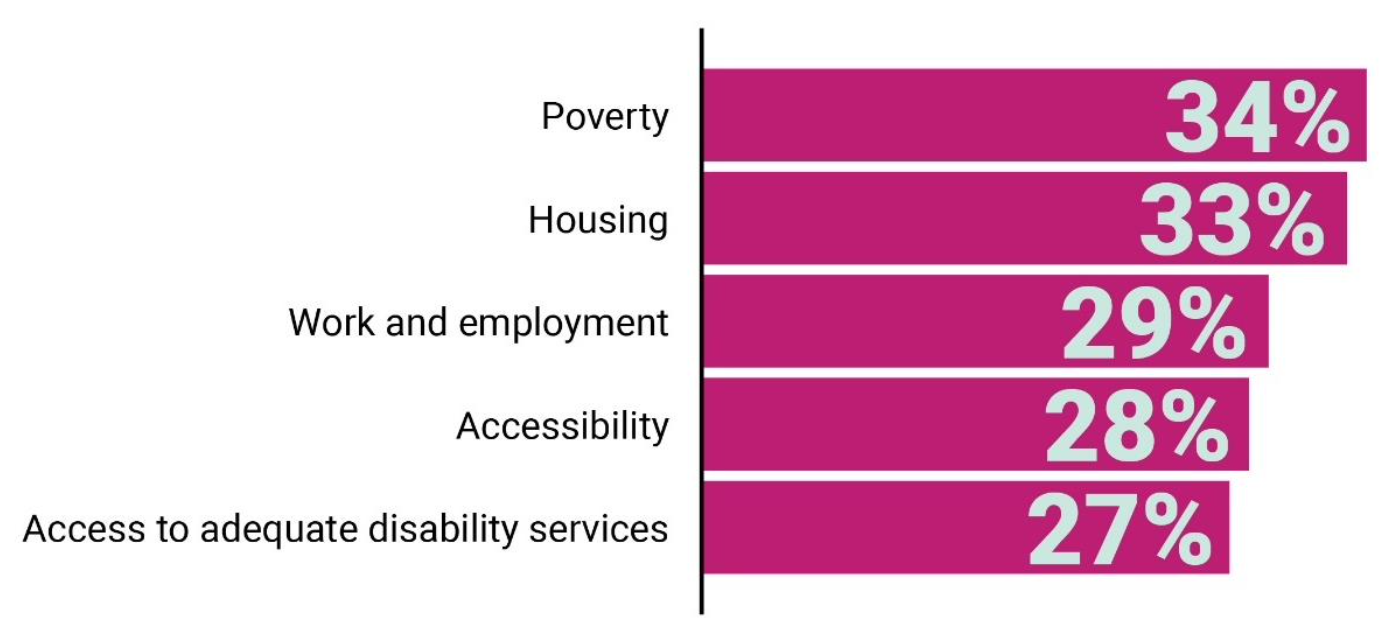
People from different provinces and regions have different concerns. For example, housing was not identified as a top concern for people in Alberta. And poverty was not a top concern for people in Alberta, Manitoba, Saskatchewan and Quebec. Here are some of the differences across the country. A detailed breakdown of the top concerns by province and territory is also provided on a map further below.
These are the main concerns of people in British Columbia.
- Poverty (45%)
- Housing (37%)
- Healthcare (29%)
These are the main concerns of people in Alberta.
- Access to adequate disability services (38%)
- Education (38%)
- Accessibility (37%)
These are the main concerns of people in Manitoba and Saskatchewan. (Only a small number of people from those provinces answered the question. We grouped their answers together.)
- Accessibility (38%)
- Work and employment (34%)
- Housing (32%)
These are the main concerns of people in Ontario.
- Poverty (36%)
- Housing (36%)
- Work and employment (30%)
These are the main concerns of people in Quebec.
- Discrimination (37%)
- Access to adequate disability services (33%)
- Accessibility (30%)
These are the main concerns of people in Atlantic Canada. This includes Nova Scotia, New Brunswick, Newfoundland and Labrador, and Prince Edward Island. (Only a small number of people from those provinces answered the question. We grouped their answers together.)
- Poverty (35%)
- Work and employment (33%)
- Healthcare (32%)
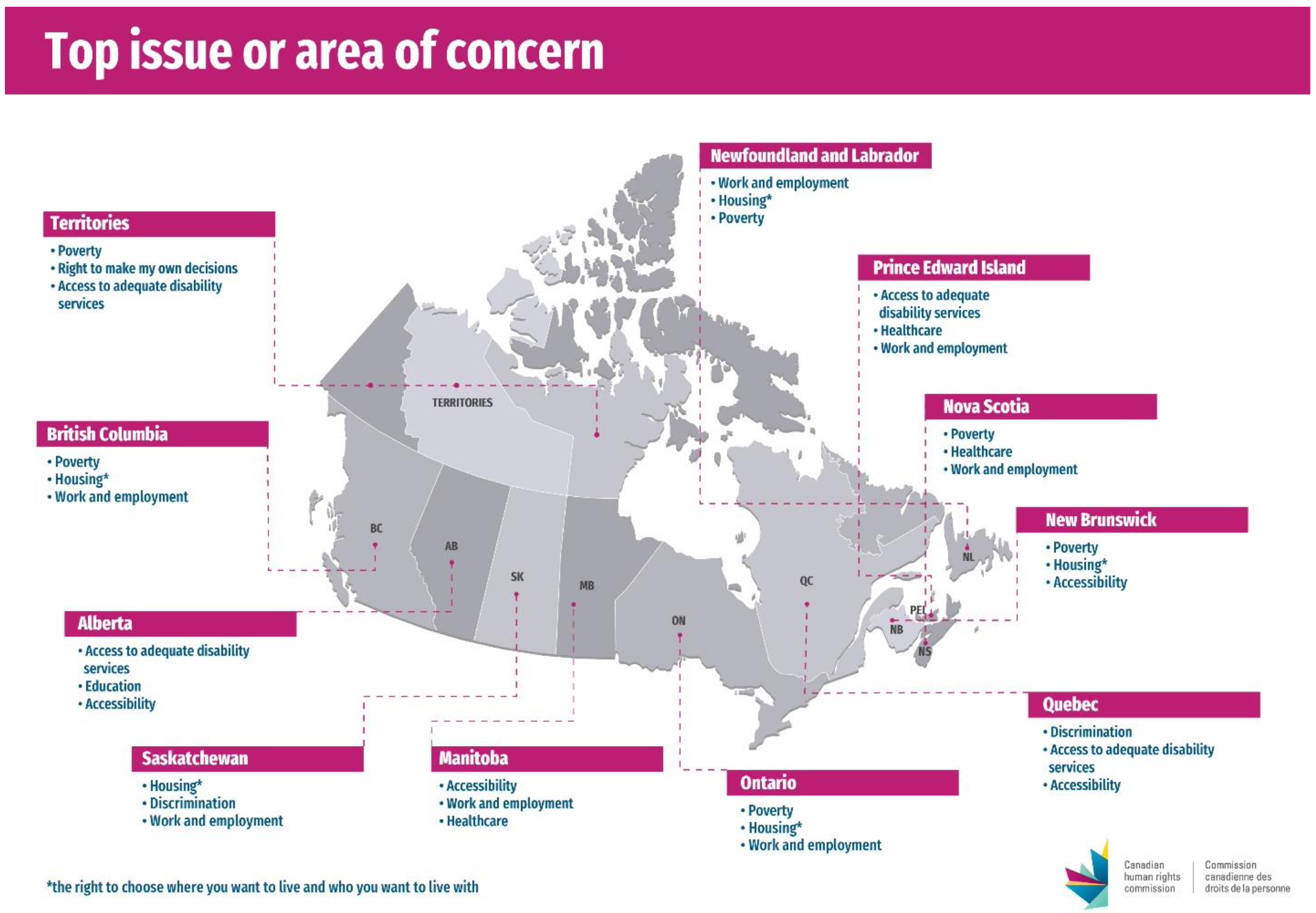
People in the chat sessions also talked about their top concerns. What we heard was very similar to the survey results. For example, people with disabilities need adequate financial support. They also need better living conditions. People described how living in poverty affects everything in a person's life. There are more details about this in the next section.
Poverty and employment
Many people talked about the low income and low salaries for people with disabilities. We heard this from both the survey and the chat sessions.
People described how hard it is to find work they can do. It is also hard to find workplaces that are accessible. This area was also covered in earlier sections of this report.
Some people spoke about not having adequate childcare. They said there is not enough support for single parents. One person said she did not have enough food for herself and her child. This meant she often had to cut back so her child could eat. This made her feel like she was in a “brain fog.” This was because she was not getting enough to eat.
“We are living in poverty! In Ontario, a single person with a disability who is unable to work receives $1,169 a month to live on. That is for your rent, food, bills, etc. That is unjust! We are being ignored for cries for help to increase these rates because we are living 40% below the poverty line.” – Online survey participant
Some people spoke about disability support and COVID-19 support for people who lost their jobs because of the pandemic. They said that disability support pays less money per month than COVID-19 support.
Canada started an emergency support benefit for people with disabilities in October 2020. This was many months after COVID-19 began. This disappointed people with disabilities. It made them feel frustrated. They felt like they were second best. They felt like other people deserved a good income but not them.
We heard that people want long-term solutions. This means solutions that give them an adequate standard of living and social protection. It means solutions that reduce poverty. Several people said disability payments need to be increased. They need to be above the poverty line.
They also called for a 'universal basic income'. This means every Canadian can get enough money to live, even if they don't have a job.
Sometimes, a person can have their disability support payments reduced because they got a job. Sometimes their support payments drop if they get married to someone without a disability. They can also drop if they live with someone without a disability. People want governments to stop doing this.
Many people said that it is hard to find accessible housing. Especially housing they can afford. Support payments barely cover rent. This leaves no money left for other important items. Here are some of the things they cannot afford.
- Food
- Clothes
- Accessibility aids
- Transportation
- Recreational activities
- Joining gyms or other groups
Housing
We heard that there is not enough affordable and accessible housing for people with disabilities in Canada. Some people with disabilities have to live with strangers. This is because they cannot afford to live alone.
One person told us she is only able to afford to rent a room. She is often told she will be evicted if she raises any concerns. She is also threatened with eviction if she objects to increases in her rent amount.
Others told us about long waiting lists for accessible public housing. One was a 35 year-old person with a disability. They live with their parents. They have been on a waiting list for an apartment. They need an accessible apartment they can afford. They have been waiting for more than 10 years.
We also heard that some landlords will not rent to people with disabilities. Especially those who get disability support. Some will not rent to people with disabilities even if they can afford the rent.
“I have a number of housing requirements and barriers due to my health and disability which make it harder to find any housing at all, let alone cheap housing. As a result, I've been forced to live in housing that is wholly unsuitable for almost a decade. I've lived with abusive roommates, in housing where I can't access the laundry because of stairs, places that had so much mold it was making me sicker, places where the landlord walked into my bedroom while I was sleeping, where I've had my food stolen by other roommates, where my therapy animal has been abused, where I've had no light, a fridge that worked so poorly my food went bad days after buying it, and where I was too far away from my care community, my doctor's office, grocery stores, or pharmacies to live independently and not rely on others to do all my shopping for me.” – Online survey participant
Access to adequate disability services and healthcare
People who took our survey also identified two other top concerns. This included access to adequate disability services (27%) and healthcare (27%). People everywhere thought these issues were important. But as noted above, access to adequate disability services was especially important in Alberta and Quebec.
People said it was difficult to get the services they need. They talked about lack of accessibility. They also said services are not consistent and can change. Many people with disabilities are affected in a negative way when governments make cuts to the supports they need.
One person told us about a support group that they had depended on. This group gave them counselling, training, and money for clothing. Government cuts meant that the support group's staff were laid off. This meant they could not provide the help people needed. This person had to find somewhere else for support and counselling.
We also heard that many people with disabilities have trouble getting adequate health care. This includes emergency health care. It also includes long-term mental health care. They cannot afford medications that are not on public health plans. People told us they also need help getting accessible devices. They also need training and other supports. These are things they need to live comfortably. They allow for independent living.
We also heard about the places people go to get healthcare. One person said people with disabilities who have high care needs should not be “warehoused” in nursing homes.
Finally, people said that healthcare workers who help people with disabilities should make more money. Low pay can lead to a lower quality of services. It can also lead to a lower quality of support for people with disabilities.
b) Monitoring framework
We asked how we should organize the monitoring process. We heard that people want a broad and inclusive approach to monitoring. They don't want the process to be restricted or done in isolation. For example, we heard that issues covered by the articles in the Convention do not occur in isolation. People told us that we should look at specific issues and their impact on a community. Another suggestion was to use the articles as a guide and then themes to show differences in issues across regions. Here are some more things we heard.
- One in eight said monitoring should focus on each article in the Convention (12%).
- One in five people said it should focus on themes and issues covered by the Convention (19%).
- Almost half said it should be a mixture of the two approaches (49%).
These numbers were mostly the same across Canada. Except both Alberta and Atlantic Canada were more in favour of monitoring the themes and issues.
Overall we heard that a broad and inclusive approach to monitoring will help to show us how well Canada follows the Convention.
Figure 11. Framework: Preferred Option to Monitor the Convention
(Results from the online survey)
Which of these options would you prefer to monitor the Convention?
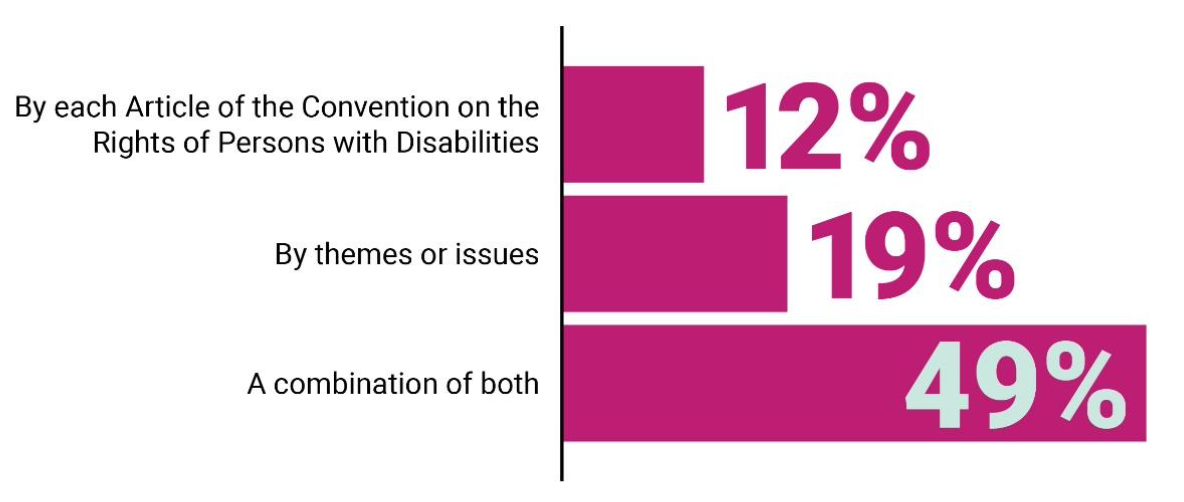
4.5 Monitoring data and communicating results
We want to make sure the Commission collects important data. Data is information and details and facts. This data needs to be useful too. We asked people what sort of information we should collect. We also asked people how we should communicate and share this information. The full record of the responses discussed in this section can be found in Appendix C.
a) Types of data
People who did our survey told us the type of information we should collect. This section will give details about some of the things they said.
Socioeconomic status of people with disabilities
People would like to see social and economic information about people with disabilities. This means details about their finances and their day to day lives. This could include information on the rate of poverty experienced by people with disabilities. It could also include the impact of disability support programs on people with disabilities. People said this information is important because it has such a big effect on all parts of people's lives.
Data on lived experiences of people with disabilities
Other people said that details about people's lived experience should be included in monitoring. This could include personal stories from people with disabilities. Here are some suggestions of how to collect this information.
- Get stories from people with disabilities and their caregivers
- Find social media groups and posts about people's experiences
- Interview people with disabilities
Working with groups that advocate on behalf of people with disabilities
Others said advocacy groups can have good information. These groups know about many of the issues and challenges people with disabilities face. Similarly, information could also come from families and caregivers of people with disabilities. This could provide useful information for monitoring.
Data on accessibility
People said the Commission should look at accessibility issues that affect the daily lives of people with disabilities. Here are some suggestions they made.
- Check that venues – places where events and activities are held – are accessible
- Check that venues are scent free
- Check to make sure organizations have an accessibility policy
- Check to make sure organizations enforce their accessibility policy
- Do random and unannounced checks of venues on a regular basis
Data on day to day lives
People also told us to collect other information affecting the quality of their day to day lives. Here are some areas they suggested.
- Information about the amount of affordable and accessible housing in Canada
- Information about the level of poverty among people with disabilities
- Information about the quality of life of people with disabilities
We heard it would be useful to know how the lives of people with disabilities compare with those of people without disabilities. This will help show where things are not equal. It will help to improve these areas.
Comparing data
People also told us they want to be able to compare information. They want to see the differences between provinces and regions. Here are some of the questions they wanted answered.
- How much financial support does each region provide to people with disabilities?
- How many affordable and accessible housing units are there in each region?
- How accessible is transportation in different places?
- How do different school boards support children with disabilities?
Data on identity
People want to know about other factors that affect people with disabilities. They want information about the parts of their identities that intersect with their disability. They want to know about the following factors.
- gender
- race
- sexual orientation
- income levels
- degree of disability
People want to know how this information differs in each province or region.
Data on what people think about disabilities
People told us they want to know about the attitudes of people without disabilities. They want to know what the public thinks about the needs of people with disabilities. They want to know if the public understands their lives.
They want the public to know about the number of people in Canada that have a disability. They want the public to know how their lives are affected by the various barriers outlined in this report.
This means sharing information about people with disabilities. This will help Canadians understand how barriers affect people's lives.
Data on positive stories
People said that it is important to report positive stories along with the negative ones.
People said we should look around to see what works best for people with disabilities. Different people and organizations will have different examples of what works best. Businesses should share their good examples on how to be accessible. These good practices need to be collected from around the world, not just from Canada. These good practices need to be put together and shared. This will show what works best to further the goals of the Convention. These good practices will help the Commission to do its job.
Monitoring government
Many people also said it was important that all levels of government are monitored. They should be reminded of their responsibility. Governments should also set goals and review their progress. A person gave an example of the federal Employment Equity Act. It was noted that this Act has not been reviewed in almost 20 years.
We heard that every government agency should be monitored. This will show how well they serve people with disabilities. It will show if they include people with disabilities in all levels of their organization.
One person wondered if monitoring could provide information on how often people with disabilities are denied support when they request it.
“Accountability is key. Individuals not upholding these values must be held accountable with serious consequences.” – Online survey participant
b) Monitoring outputs
We asked people how we should present the results of our monitoring. They could choose more than one answer. Here is what they suggested.
- Many said that sharing stories about people with disabilities would be a useful output (67%).
- Many said that results should be in a visual form (63%). This includes videos with Sign language. It also includes infographics or brochures.
- Many people said a summary of the monitoring results in a report would be a useful output (59%).
- Less people wanted to see the results presented in a technical report with raw data (37%).
This was mostly the same across the country, except in the Territories and Newfoundland and Labrador. Visual information was the most popular type of output in these places. For a more detailed look at the responses across Canada, please see Appendix D.
Figure 12. Most Useful Outputs (Top three results from the online survey)
What types of outputs would you find most useful?
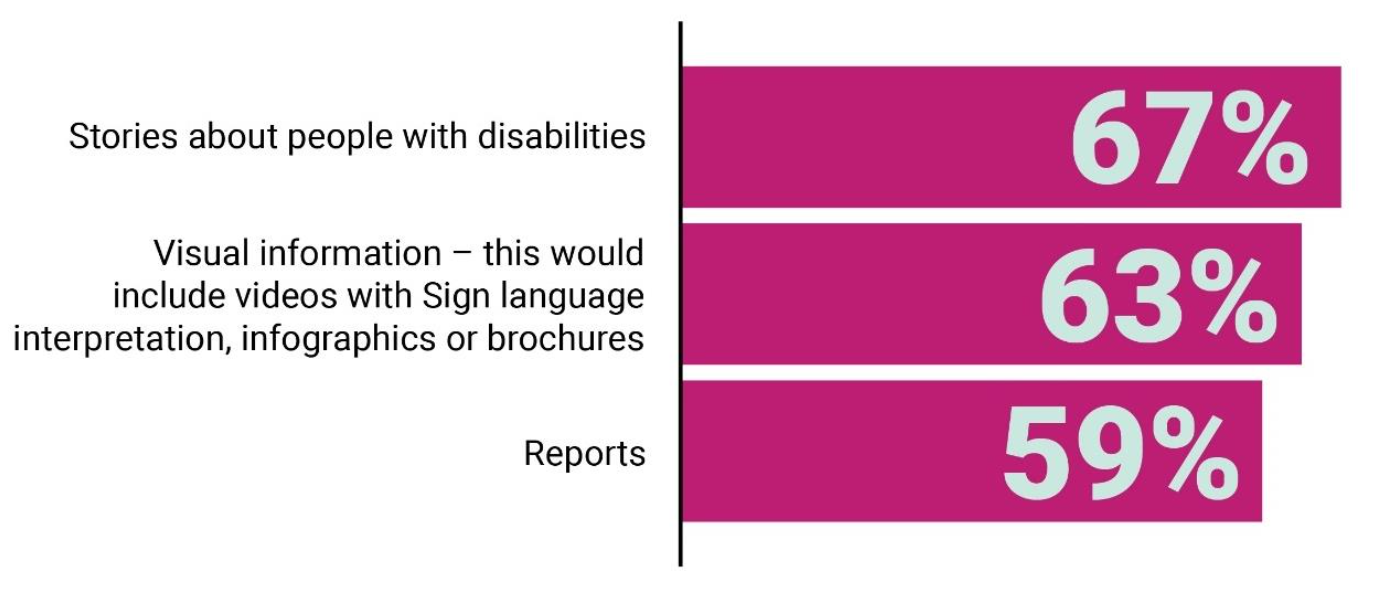
People said they would like to see annual surveys about discrimination and barriers. This would allow trends and progress to be measured. It would show if the lives of people with disabilities are getting better or worse.
One person recommended using tracking surveys. This is a survey that is given to the same people every year over a long time. It shows whether people are seeing progress over time.
Another suggestion was for a database. It could store information about the Convention. This could include things like the following.
- The number of complaints filed
- The number of complaints resolved
- The number of complaints not resolved
Some people want to hear about lived experiences. They said it could be in written or spoken form. It could also be in a video. This would put a face to people with disabilities. They feel that this would have a bigger impact than formal reports.
There are people who want to share their stories but cannot speak for themselves. Some of them are in hospitals or institutions. They need other people or facilitators to help them share their stories. We also heard that the stories of family members and caregivers should be included.
Over and over, people with disabilities said we need to listen to their stories. They said this was very important. They want to see how their stories are used. They also want their stories to be used in meaningful ways. They want to see if their stories inspire people to act. They want to see how their contributions lead to action.
c) Communicating about monitoring results
The Commission will report on how well Canada follows the Convention. People said we need to stay in touch with the disability community. People also told us how we should share these results.
People said they want the Commission to report on a regular basis. They want timely information and ongoing communication. They also said we need to use as many types of communication as possible. They must be accessible. Everybody should have equal access to the information.
Some people with disabilities told us they like to communicate in person. This could be done through small gatherings. It could also be through training or conferences. There could even be a telephone number people can call to stay informed. They said they prefer this way over virtual meetings or speaking online.
Many people said they would rather have online communications. This could be by email or social media. They said that they found these methods quicker and more accessible. This is especially true during the pandemic.
It was suggested that online communities and Facebook groups could have a role. They can help bring people together.
People said that the Commission website should be a source of information. It needs to be accessible. Although one person said it is not always easy to follow the website.
Many people said they cannot afford internet. They cannot afford the devices needed to use it. This was especially true for people receiving disability payments. Other people have poor internet service because they live in rural, remote or northern communities.
One person who did the survey said they could not afford a phone. They had to use their roommate's phone to take part in the online survey.
Several people said the internet should be an essential service. This would mean everybody has the same right to it. They want rates to be reduced for those on low income.
Others told us they still like to get and send information by regular mail. Some people also suggested using traditional media such as the following.
- Newspapers
- Radio
- Television
Some said that advertising could be useful. This could be public service announcements. They could talk about the rights of people with disabilities. They could tell people about the Convention and Canada's role.
Another suggested reaching people with disabilities through local agencies and social services. Provincial disability programs could deliver information. This could be done using leaflets included with disability cheques. It could also happen using special mail-outs or on their websites.
It was suggested that pamphlets could be distributed. They could be left in the following places.
- Libraries
- Agency offices
- Social services offices
- Medical clinics
- Dentists' offices
People said all communications must be clear and accessible. Information needs to be in English and French. Other languages should also be used when needed. It should be translated into Sign language in both English and French. They said information needs to have captions and alternative text. Information should also be provided in visual formats. Overall, information needs to be in as many formats as possible.
We also heard that reports should be summarized. This will make them easier for people to read and understand. It will also make it easier for people who find it hard to read long reports.
Finally, we heard that people want to see diversity in the monitoring process. They want this in information about the Convention too. People especially want to see a diversity of disabilities. They want diverse images of people with disabilities. They want these images to show the full range of disabilities. They do not want to see only images of people in wheelchairs. This will help to change wrong ideas and harmful beliefs about people with disabilities.
Conclusion
We would like to thank all the people who took part in this process. Thank you for sharing your experiences. Thank you for teaching us about the barriers in your life. Thank you for your great ideas on how we can work as a team. We will work together to make sure the Convention is fully put into effect in Canada. The stories we heard are important. They taught us that Canada has lots to do. Canada needs to do more to promote and protect the rights of people with disabilities.
We listened carefully to people. They told us what our priorities should be. They told us what a monitoring system should look like. They told us how to get rid of barriers. They told us what people with disabilities need to take part in monitoring the Convention. Many people said they want to participate in the monitoring process. We think this is very encouraging.
Overall, people who took part in the online survey felt positively about the experience. Many people (65%) said they learned new things by doing the survey. They learned about the Convention. They learned about the Commission and our role in monitoring.
Many people (62%) said they think their feedback will be used by the Commission. Most people (79%) said they would consider doing another survey in the future.
The themes and suggestions people gave us are very useful. They will help shape our plans. They will help us to do the monitoring. They will help us know what we need to monitor.
We want to include everyone in our monitoring work. We want to include people with disabilities. We want to include caregivers and families. We also want to include organizations that advocate on behalf of people with disabilities. We need input from all these people and groups. We want them to be involved in the entire process.
We know that not everybody was able to take part in this process. But we will continue to engage with as many people as we can. Diverse ideas and views will make the monitoring process better.
We believe this engagement process is just the beginning. It is the beginning of our action plan, which is a monitoring plan that will seek to empower people with disabilities. The plan will also seek to partner with people with disabilities and advocacy groups as well.
This is the beginning of a new relationship with people with disabilities and disability stakeholders across Canada. They will guide our future work.
We want to work together to promote and protect the rights of people with disabilities in Canada. We want them to be able to lead their lives in a way that is equal to others, no matter what identity or lived experiences they have.
One thing came through loud and clear in our engagement process. People want real action that will make a difference in their day-to-day lives. We share their determination.
Appendix A: Online survey
Welcome
Thank you for your interest in taking the Canadian Human Rights Commission's survey!
In Canada, every person has the right, equal with others, to make for themselves the lives that they are able and wish to have. The problem is, not everyone is free to do so without barriers.
Barriers to equality for people with disabilities exist in many forms, in many places. They are in our policies, workplaces, buildings and public spaces, in our transportation systems, in our media and broadcasting, in our banks and schools, even in our biases or attitudes.
Across Canada, across jurisdictions, the majority of discrimination complaints brought to human rights commissions are from people with disabilities. This needs to change. And we need your help.
The Canadian Human Rights Commission's mission is to promote and protect human rights in Canada. As part of that role, we have recently been given a new responsibility to monitor the implementation of the United Nations Convention on the Rights of Persons with Disabilities here in Canada.
As we take on this new responsibility, we will need your help to determine what this monitoring should look like and what our priorities should be. This survey is your chance to provide input and help guide the process. At the same time, you will learn more about the Convention on the Rights of Persons with Disabilities and the Commission's role in monitoring it.
Thank you in advance for taking the time to complete our survey. Your participation and input will contribute to how we can work together to ensure that all people in Canada, especially people with disabilities, are treated equally and equitably.
Marie-Claude Landry
Chief Commissioner of the Canadian Human Rights Commission
How we got here
The Canadian Human Rights Commission is Canada's human rights watchdog. We work for the people of Canada. We are independent from government. We promote and protect human rights. We also receive discrimination complaints. The complaints are about employment and services that are under the power and control of the federal government.
Recently, the Commission was given a very important task. The task is about the United Nations Convention on the Rights of Persons with Disabilities. The Convention is an important agreement. It is meant to protect the rights and dignity of people with disabilities.
The task the Commission is responsible for is to monitor the Convention. This means we will watch and make sure it is followed by governments in Canada. We will work together with people with disabilities and disability organizations on this task.
If the Convention is followed properly in Canada, people with disabilities will see real change in their day-to-day lives. They will be able to live their lives in a way that is equal to others.
In this survey we will share more information about what we have been asked to do. We want to make sure that the work is done right. We want it to be meaningful to you. We want it to focus on the right priorities. To do that, we need your feedback.
Let's begin!
About this survey
This survey is divided into 3 parts.
- Part 1 is background information. Here you can learn about the work we are doing. And you can tell us a bit about you.
- Part 2 is the guiding principles. Here you can look at the principles that will help to guide and inform our work. And you can share your experiences in this part.
- Part 3 is about the monitoring work. Here you can explore how we plan on monitoring the Convention in Canada. And you can tell us what you think is important.
The survey takes between 15 and 30 minutes to finish. This depends on how much detail you give in your answers. You can choose to answer any question or not answer it.
Thank you for taking part in this survey.
About you
The first thing we want to do is learn a bit more about you. This will help us to better understand all the information we collect. All answers in each section are optional. This means that you don't have to answer a question if you don't want to. All the information we collect will be combined together. Nobody who takes the survey will ever be identified. This means that nobody will know this information was collected from you.
How are you filling out this survey today? Choose one
- On a computer at my home
- On a computer at a library
- On my phone
- On a paper version
- Other, please specify:
Please choose how you would best describe your main daily activities. Choose all that apply
- Providing care to family or friends for a health condition
- Not working due to a disability or illness
- Going to school
- Caring for children
- Working at a paid job or running a business
- Working at more than one paid job
- Looking for paid work
- Temporarily off work
- Out of work but not currently looking for paid work
- Household work
- Retired
- Maternity/paternity/parental leave
- Volunteer work
- Don't know
- Prefer not to answer
- Other, please specify:
In which province or territory do you live? Choose one
- British Columbia
- Alberta
- Saskatchewan
- Manitoba
- Ontario
- Quebec
- New Brunswick
- Nova Scotia
- Prince Edward Island
- Newfoundland and Labrador
- Yukon
- Northwest Territories
- Nunavut
- I do not live in Canada
- Don't know
- Prefer not to answer
Where do you live? Choose all that apply
- In a city
- In a rural (small) community
- In a remote community (with limited or no road access)
- Indigenous community (First Nation, Métis or Inuit)
- I don't have a fixed address
- I'm staying with friends or family temporarily
- I live in an assisted living home or long-term care facility
- Don't know
- Prefer not to answer
- Other, please specify:
Do you have a disability? Choose one
- Yes
- Sometimes
- No
- Don't know
- Prefer not to answer
Do you identify as any of the following? Check all that apply
- Indigenous (for example, First Nations, Métis, Inuit)
- Arab (for example, Saudi, Egyptian)
- Black
- Chinese
- Filipino
- Japanese
- Korean
- Latin American
- South Asian (for example, East Indian, Pakistani, Sri Lankan)
- Southeast Asian (for example, Cambodian, Indonesian, Laotian, Vietnamese)
- West Asian (for example, Afghan, Iranian)
- White
- Prefer not to answer
- Other, please specify:
[If yes Indigenous] Do you identify as First Nations, Métis or Inuit?
- Status First Nations
- Non-status First Nations
- Métis
- Inuit
- Prefer not to answer
Do you identify as a Deaf person? Choose one
- Yes
- No
- Don't know
- Prefer not to answer
What is your gender? Choose one
- Female
- Male
- Non-binary or another gender
- Prefer not to answer
Do you identify as 2SLGBTQQIA? (This refers to people who are Two-Spirit, Lesbian, Gay, Bisexual, Transgender, Queer, Questioning, Intersex and Asexual). Choose one
- Yes
- No
- Prefer not to answer
How old are you? Choose one
- 16 to 24
- 25 to 34
- 35 to 44
- 45 to 54
- 55 to 64
- 65 to 74
- 75 to 84
- 85 or older
- Prefer not to answer
Some background information: What is the United Nations Convention on the Rights of Persons with Disabilities?
The United Nations Convention on the Rights of Persons with Disabilities is an international agreement. It is sometimes called the 'CRPD.' We call it the 'Convention' in this survey.
This agreement promotes and protects human rights for people with disabilities. Canada agreed to follow the Convention in 2010. The Convention was developed by many groups. This included governments working with people with disabilities. It also included organizations for people with disabilities. There were also other organizations involved. These included groups like the human rights commissions.
The Convention has 50 articles. Articles explain what rights people with disabilities have under the Convention. These Articles cover many parts of a person's life. For example, there is the right to live free from discrimination. There is the right to an inclusive education for children with disabilities. There is the right to employment for people with disabilities. There is also the right to make one's own decisions for people with disabilities. There are many more rights in the Convention.
Do you want to learn more about the Convention before moving on with the survey? If so, check out the resources below.
- ARCH Disability Law Centre's resource on advancing the Convention on the Rights of Persons with Disabilities is available here: https://archdisabilitylaw.ca/initiatives/advancing-the-un-crpd/
- A United Nations resource on the Articles that make up the Convention on the Rights of Persons with Disabilities is available here: https://assets.publishing.service.gov.uk/government/uploads/system/uploads/attachment_data/file/345108/easy-read-un-convention.pdf
- The full text of the Convention on the Rights of Persons with Disabilities is available here: https://www.un.org/development/desa/disabilities/convention-on-the-rights-of-persons-with-disabilities/convention-on-the-rights-of-persons-with-disabilities-2.html
Some background information: How the Convention will be monitored in Canada
All United Nations conventions need to have a way to see if they are being followed and if they are working. This is usually done by an international group at the United Nations. But the Convention on the Rights of Persons with disabilities is different. It requires countries to monitor the Convention themselves.
To do this, Canada needs groups of people to help them. Those groups would have to promote, protect and monitor the Convention. They would have to do this on an ongoing basis. It also requires that this be done in partnership with people with disabilities and the organizations that represent them.
The Commission was appointed as the group responsible for monitoring in 2019. We will look at how the Government of Canada is following the Convention.
We want our work to be meaningful for people with disabilities. We want to be part of real change. There are many ways we could do this. For example, we could prepare reports. Or we could provide education. Or we could give advice on laws and policies. There are also other things we can do.
That's one of the reasons we are doing this survey. We want your advice. We want to hear from people with disabilities across the country. We want you to share your experiences. We would like you to answer some questions. This will help to inform us as we move ahead.
How familiar are you?
The Canadian Human Rights Commission
- Very familiar
- Somewhat familiar
- Not really familiar
- Not familiar at all
- Don't know
- Prefer not to answer
The United Nations Convention on the Rights of Persons with Disabilities
- Very familiar
- Somewhat familiar
- Not really familiar
- Not familiar at all
- Don't know
- Prefer not to answer
The Accessible Canada Act
- Very familiar
- Somewhat familiar
- Not really familiar
- Not familiar at all
- Don't know
- Prefer not to answer
How much positive effect do you think the Convention will have for people with disabilities?
- Very positive
- Somewhat positive
- Not really positive
- Not positive at all
- Don't know
- Prefer not to answer
How important do you think it is for the Commission to partner with others to make sure Canada follows the Convention? This could include partnering with people with disabilities. The Commission could also partner with community groups.
- Very important
- Somewhat important
- Not really important
- Not important at all
- Don't know
- Prefer not to answer
Guiding Principles
We are going to follow some guiding principles in our work. This will help us make sure that we monitor what is important. These principles will be based on the lived experience of people with disabilities and their caregivers.
This part of the survey will look at some key principles. You will have an opportunity to share other principles you think should guide and inform our work.
Let's explore some of them now.
Guiding Principles: Participation
Participation means taking part or being involved in something. We want people with disabilities to be involved in our guiding principles. We want people with disabilities making decisions about things that affect their lives. This includes laws, policies, programs, and services.
An example of this would be the following. An employer wants to develop a return to work policy. Participation would mean that they would include others in all stages of developing the policy. The groups they would include are people who may be affected by the policy. This would include people with disabilities. Or people who will be returning to work.
In this question, we are asking you to share any examples from your life. These can be like the following situations.
- You faced a situation where you were not comfortable in taking part in decision making about an issue that affected you.
- You faced a situation where you were not able to take part in decision making about an issue that affected you.
- You faced a situation where you were not asked to take part in decision making about an issue that affected you.
You can share your examples here.
What kept you from taking part? For example, maybe you were not asked or you had childcare duties. Or there could have been travel costs that prevented you from taking part. Or there could have been barriers that prevented you from taking part like language or sign language barriers.
You can share what kept you from taking part here.
Guiding Principles: Accessibility
Accessibility is about creating a society without barriers. This way everyone can fully take part in society. This means that everyone can fully access communities, workplaces and services.
An example of this would be making sure that everyone can vote. To do this, governments could take certain steps. They could provide plain language information in different formats. They could also choose polling locations that do not have barriers. They could also make sure that the technology used to vote follows universal design principles. This would mean they could accommodate people with all kinds of disabilities.
Can you think of any examples from your life where you faced barriers to taking part in an activity?
You can share your examples here.
Can you tell us anything that might have helped in your example? You can share what might have helped here.
Guiding Principles: Equality and non-discrimination
Discrimination means the unfair treatment of one person or a group of people. Discrimination can be an action or a decision that treats a person or group in an unequal way. The unfair treatment can be because of reasons like a disability.
An example of this could be an employer's policy. The policy could be that all employees need to have a valid driver's license. The employer could take an approach that includes everyone. He could allow an employee with a disability to try to do the job another way. For instance, they could use public transportation.
Can you share any examples from your life where you were not treated equally or discriminated against because of your disability?
You can share your examples here.
Can you tell us anything that might have helped in your example? You can share what might have helped here.
Guiding Principles: Intersectionality
There are many different things that make each of us who we are. Things like our sex, race, age, disability and religion for example. These different parts of us come together to make us unique. This means they intersect or combine with each other. Our experiences are affected by all these parts of us, not just one part.
Our experiences are also affected by the society or situation we live in. There are rules and situations in our world that treat some people or groups unfairly. For example, some people have trouble finding a job or a place to live.
Both the individual things that make us unique and the situations we live in affect our lives. Looking at them together is called 'intersectionality'. Intersectionality helps us see all the barriers people face, not just one or two.
People with disabilities may face more barriers depending on their own situation. An example would be Indigenous women with disabilities. They can experience discrimination due to three things about them intersecting. These would be their sex, their disability and their Indigenous identity.
They are more at risk to be harmed, abused or mistreated than women in general. They often face more barriers to getting housing, health care, education and jobs.
Can you think of any examples from your life where you felt you were treated unfairly because of the combination of factors related to your identity?
You can share your examples here.
Can you tell us anything that might have helped in your example? You can share what might have helped here.
Guiding Principles: Other
We would like to hear about any other principles you think are important to our work and how they have impacted your life. Please use this section to share your thoughts.
Monitoring: The role of the Commission
The Commission has the task of monitoring to see if the Government of Canada is following the Convention. This means that it is our job to track and report on the progress that Canada is making. We will also identify gaps and problems that need to be fixed.
It is also our duty to work with partners. The Commission will work with many different partners. We will work with people with disabilities, caregivers and families. We will also work with organizations of and for people with disabilities. Together we can give advice about how to fill the gaps and fix the problems.
How interested are you in being involved in this monitoring work?
- Very interested
- Somewhat interested
- Not really interested
- Not interested at all
- Don't know
- Prefer not to answer
Some people may need supports or resources to help them take part in monitoring work. Are there any supports that you would need to be able to take part in monitoring activities? Choose all that apply
- Training
- Financial resources
- Human resources
- Communication supports
- Other (please specify)
Which of the following roles could you see yourself playing? Choose all that apply
- I want to help figure out how the monitoring work will be done.
- I want to take part in the monitoring activities by collecting data and helping to assess how Canada is doing.
- I want to be an observer who can report back to my community or organization on how the monitoring work is going.
- I want to write or participate in writing reports.
- I want to be able to review and provide input on the data that was gathered before final reports are written.
- I want to review drafts of final reports and be able to provide input.
- I just want to review the final reports.
- I want to train other people with disabilities to do one or more of these roles.
- I want to help make information accessible and engaging for people with disabilities.
- I want to stay informed and up to date on the monitoring process.
- I don't want to play a role.
- I don't know.
- I want to do something else (please share)
What could an organization, such as those that represent people with disabilities, do to help you participate in monitoring?
Monitoring: The priorities
The Convention on the Rights of Persons with Disabilities covers many different parts of a person's life. All of these parts are important. But we have limited resources. Because of this, the Commission may have to identify certain priorities and focus on those.
Below are some examples of priority issues of concern. These have often come up in our discussions with partners. This includes discussions with people with disabilities across Canada.
What are the top three issues or areas of concern for you? Choose three
- Education
- Discrimination
- Work and Employment
- Accessibility
- Transportation
- Right to make my own decisions
- Information and communication technologies
- Housing (the right to choose where you want to live and who you want to live with)
- Healthcare
- Poverty
- Violence
- Access to sign languages
- Access to adequate disability services
- Access to justice
- Parenting with a disability
- Voting and access to political processes
- Other (please specify)
Monitoring: The framework
The Convention on the Rights of Persons with Disabilities has 50 Articles. Each one deals with a different topic or area. Some are about specific rights. Some explain how the Convention works. Many topics can fall under more than one Article. The Commission has to figure out a framework or a plan for monitoring.
The Commission can do the monitoring in different ways. There are a couple of options. Each option has advantages and disadvantages.
One option would be to monitor and report on each Article of the Convention separately.
The advantages of this option would be as follows:
- The monitoring and reporting would be complete because every Article would be covered.
- This would make it easy to write formal reports for the United Nations.
The disadvantages of this option would be as follows:
- We may not be able to see how the Articles relate to and affect each other. For example, there are separate Articles about accessibility and employment, but these two areas can be related to each other.
- This option can also be a lot of work. There are over 30 Articles about specific rights that would need to be monitored.
Another option would be to monitor and report around themes or issues. Some examples of themes or issues would be work or education or access to justice. These themes or issues may relate to many Articles in the Convention.
The advantages of this option would be as follows.
- We could look closer at how different Articles relate to and affect each other.
- The framework could better focus on priority areas.
The disadvantages of this option would be as follows.
- The reporting may not be as complete.
- Some very specific or technical issues may get overlooked.
Which of these options would you prefer to monitor the Convention? Choose one
- By each Article of the Convention on the Rights of Persons with Disabilities
- By themes or issues
- A combination of both
- Don't know
- Prefer not to answer
Please take a few minutes to share the reasons for your choice.
Monitoring: Types of data
There are different types of information (or data) we can collect. This information could tell us how the Convention is being followed in Canada.
These are the types of information we could collect.
- We could get information on the lived experiences of people with disabilities. This would be examples and stories from people's everyday lives. This could be collected through surveys.
- We could examine information from other governments in Canada and other places. We could review their laws and policies to see what they are doing.
- We could look at public behaviours towards people with disabilities. We could look at human rights complaints. We could look at how the media represents people with disabilities. We could look at the stereotypes about people with disabilities in our society.
- We could look at reports and information from organizations and universities.
Besides the types of data listed above, are there any other type of information that you think should be included? Choose one
- Yes
- No
- Don't know
- Prefer not to answer
[If yes] Can you please share examples?
Monitoring: Outputs
Monitoring groups produce a lot of information and resources. These are called 'outputs.' They include things like reports, public education material, and advice on laws, among other things. The Commission wants to make sure that it produces things that are important and useful. These outputs would be shared with our partners, including people with disabilities.
What types of outputs would you find most useful? Choose all that apply
- Reports
- Technical reports with raw data
- Visual information – this would include videos with sign language interpretation, infographics or brochures
- Stories about people with disabilities
- Other (please specify)
Monitoring: Questions to think about
Overall, how do you feel Canada is doing in promoting the rights of people with disabilities? An example could be training for employers and managers. They could learn about how to accommodate employees with disabilities.
- Very well
- Good
- Neither well nor poor
- Not very well
- Very poor
- Don't know
- Prefer not to answer
Overall, how do you feel Canada is doing in protecting the rights of people with disabilities? An example could be making rules and laws that guarantee the rights of people with disabilities.
- Very well
- Good
- Neither well nor poor
- Not very well
- Very poor
- Don't know
- Prefer not to answer
How much of a positive impact do you think the Convention will have on your life in the future?
- Very positive
- Somewhat positive
- Not really positive
- Not positive at all
- Don't know
- Prefer not to answer
How important do you think it is that the Commission partners with others to make sure Canada follows the Convention? This would include partnering with people with disabilities and community organizations.
- Very important
- Somewhat important
- Not really important
- Not important at all
- Don't know
- Prefer not to answer
Monitoring: Next steps
Thank you for taking part in this survey!
Thank you for sharing your experiences and input with us!
Do you want to learn more about our work and how the Convention is going to be monitored across Canada? If so, please leave your email address below and we will keep you updated. Please note that this will not be used to connect you to your survey answers.
Monitoring: Evaluation
Before you finish, please tell us how you liked this survey experience.
This survey helped me learn more about the Convention on the Rights of Persons with Disabilities. It also helped me learn more about the role of the Canadian Human Rights Commission in monitoring how the Convention is being followed.
- Strongly Agree
- Agree
- Neither agree nor disagree
- Disagree
- Strongly disagree
- Don't know
- Prefer not to answer
I am confident that the Commission will consider the feedback collected from this survey.
- Strongly Agree
- Agree
- Neither agree nor disagree
- Disagree
- Strongly disagree
- Don't know
- Prefer not to answer
Overall, I am satisfied with this survey experience.
- Strongly Agree
- Agree
- Neither agree nor disagree
- Disagree
- Strongly disagree
- Don't know
- Prefer not to answer
I would consider doing another survey in the future.
- Strongly Agree
- Agree
- Neither agree nor disagree
- Disagree
- Strongly disagree
- Don't know
- Prefer not to answer
Do you have any additional comments? Please share them here.
Appendix B: Online dialogue sessions
Questions in round 1:
- How can we ensure that all people with disabilities, and their organizations, participate in monitoring? What would work best and why?
- What are some of the barriers, especially given the current environment, that might prevent people from participating in monitoring? How can we overcome these barriers?
Questions in round 2:
- When it comes to monitoring the Convention, what issues or areas are most important? Why?
- What is the best way to communicate on monitoring activities? What would be most useful?
Appendix C: Online survey results
This section of the report shows the results from the online survey.
The survey had open-ended and closed-ended questions. Close-ended questions are usually answered with 'yes' or 'no' or by choosing items from a list. Open-ended questions require longer answers. These answers can be many sentences or paragraphs long. Open-ended questions can provide much more detailed information. These kinds of questions allow people a space to tell their story.
Some of the open-ended questions were studied. Key ideas and themes were identified from these. The results of that study of the responses are shown as graphs in this section.
Some people did the whole survey but chose not to do the open-ended questions. They were labelled as 'non-responsive' in these questions. This means that the percentages for many open-ended questions are less than 100%. Other percentages do not add up to 100% due to number rounding. Others add up to more than 100% because more than one response could be selected.
Some percentages are very small. This means the number of people who answered the question is very small.
These answers are not representative of all people with disabilities or all Canadians.
Some results from the chat sessions are in this section as well. These are the responses to the demographic questions. These are questions about people's age or race or sex or other factors. All demographic questions in the survey and chat sessions were optional. People did not have to answer if they did not want to. In some questions, percentages can add up to more than 100% because more than one answer could be chosen.
The results from the Atlantic Provinces were grouped together. This includes New Brunswick, Nova Scotia, Newfoundland and Labrador, and Prince Edward Island. The results from the Territories were also grouped together. This includes Yukon, Northwest Territories, and Nunavut. This was because a very small number of people from these places took part in the online survey.
The size of the difference shown by the bars on the graphs do not always show the true difference. This was done to make it easier to read the graphs. Sometimes there are different size bars for the same percentage value. This is due to number rounding.
Chart 1. Demographic results from the survey
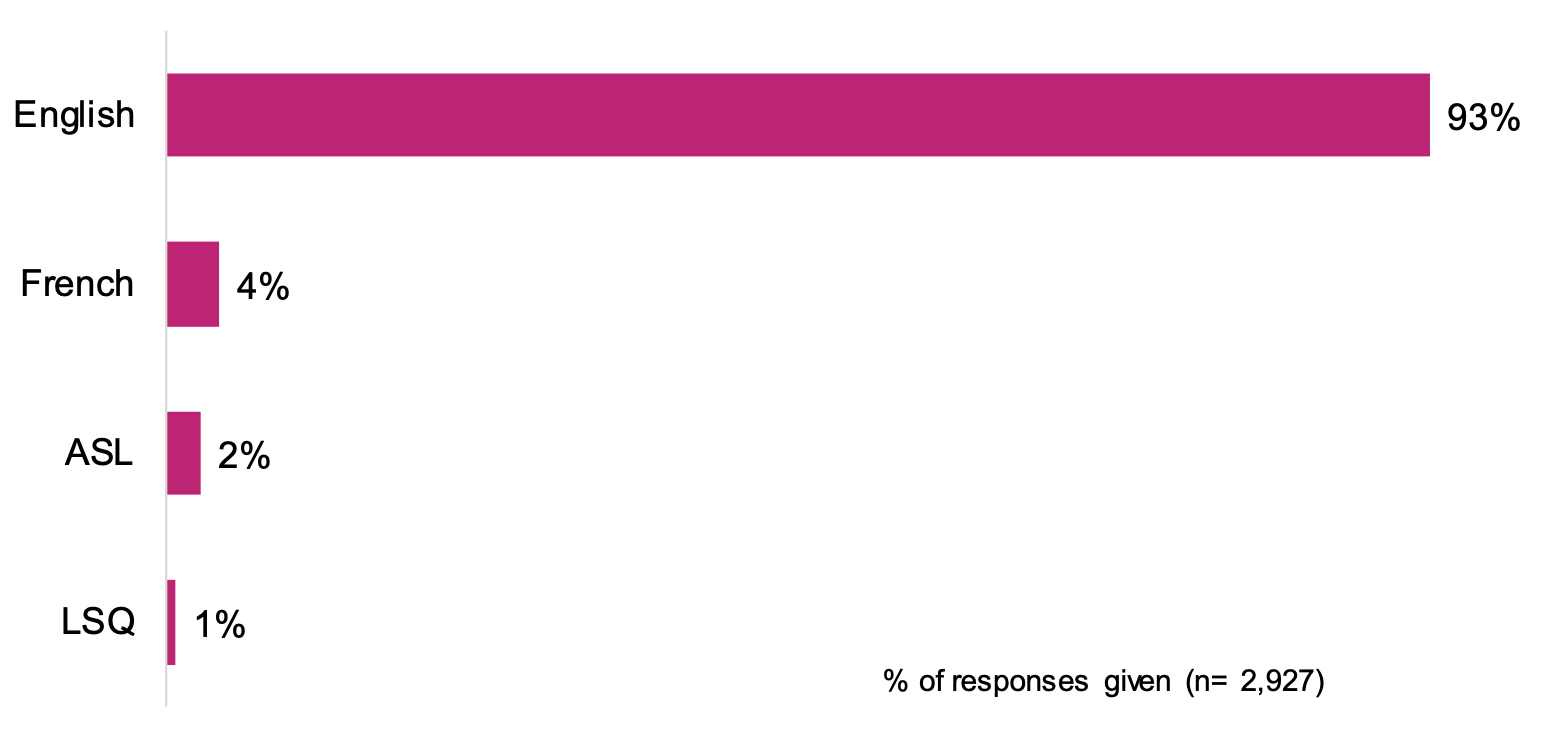
Survey Question: What language would you like to use to take this survey?
Survey Responses: 2,927 people responded. 93% took the survey in 'English.' 4% took the survey in 'French.' 2% took the survey in 'American Sign Language' or 'ASL' for short. 1% took the survey in 'Langue des signes québécoise' or 'LSQ' for short.
Chart 2. Demographic results from the survey
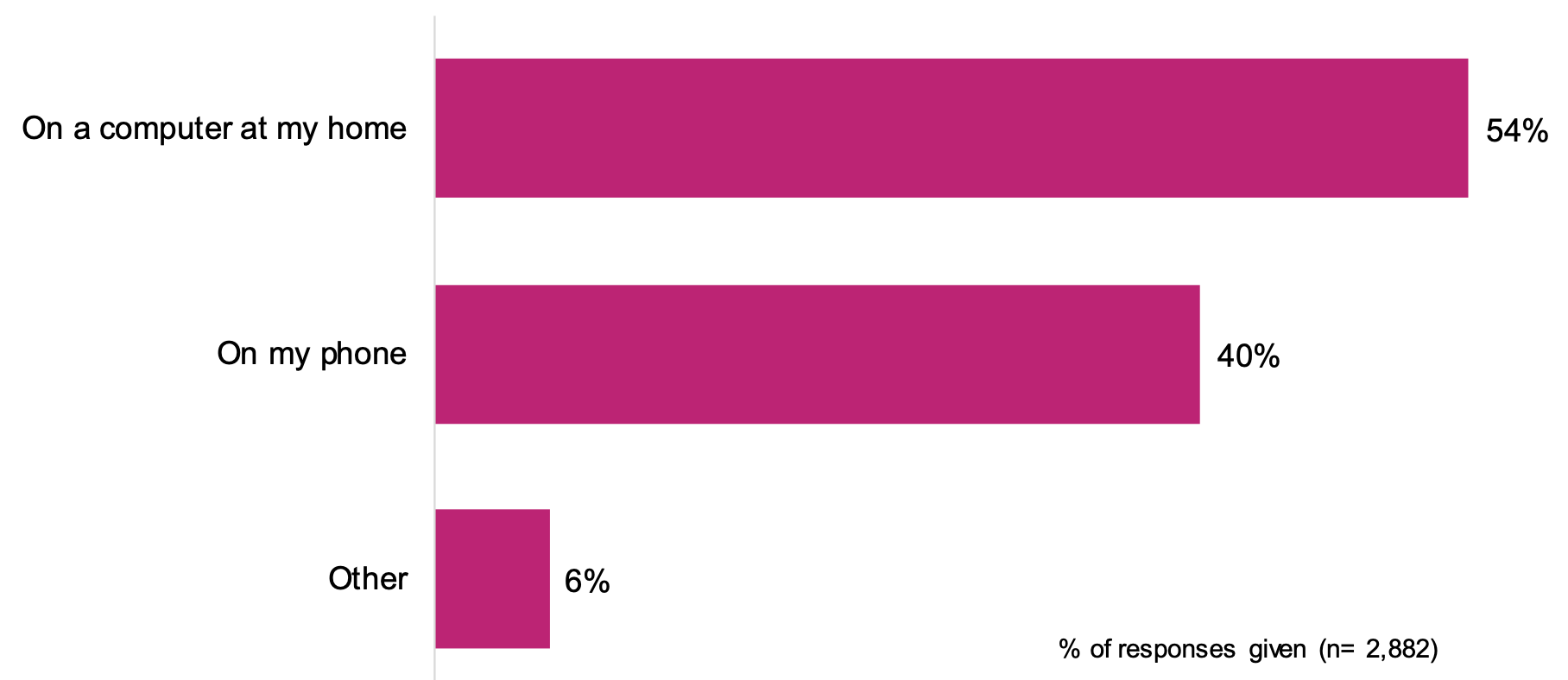
Survey Question: How are you filling out this survey today?
Survey Responses: 2,882 people responded. 54% said 'on a computer at my home.' 40% said 'on my phone.' 6% said 'other.'
Chart 3. Demographic results from the survey
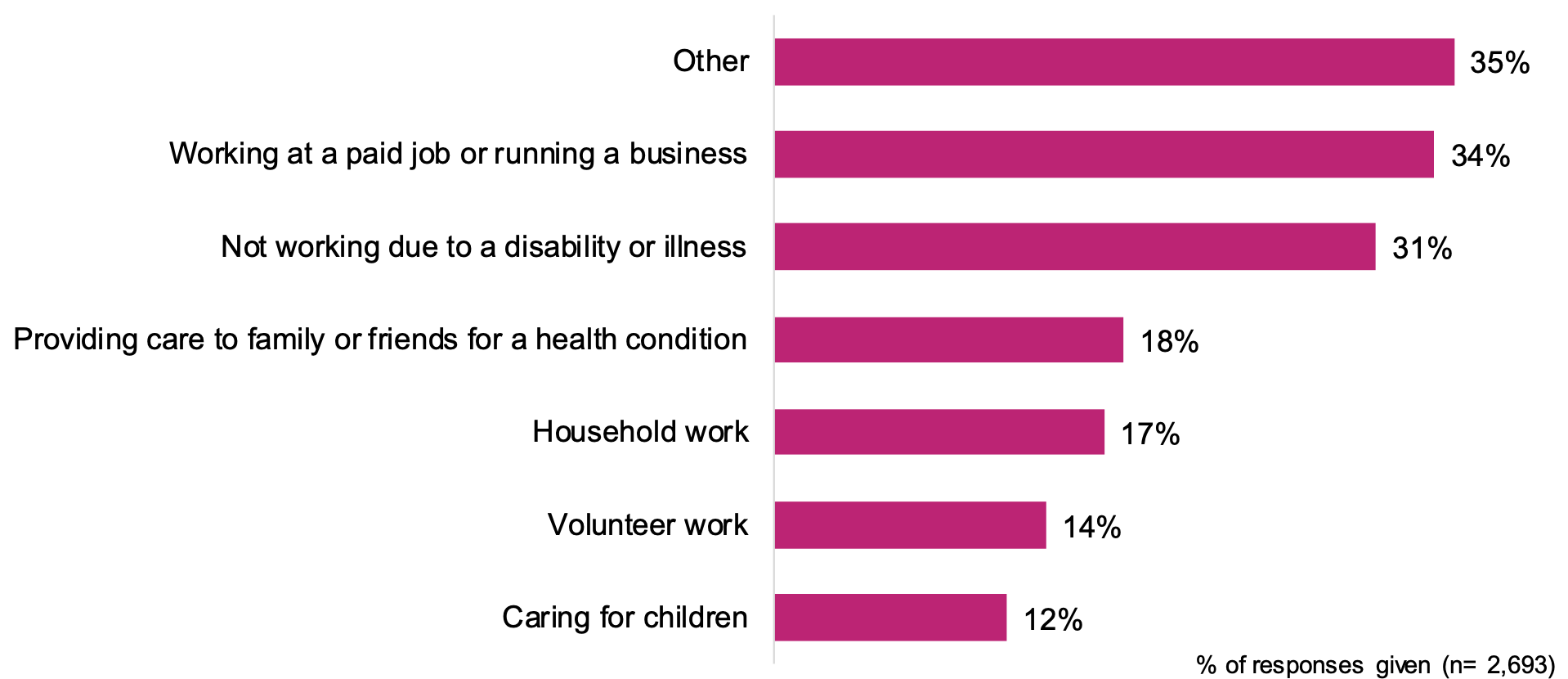
Survey Question: How would you describe your main daily activities?
Survey Responses: 2,693 people responded. They could select more than one answer, so the total adds up to more than 100%. 35% said 'other.' 34% said 'working at a paid job or running a business.' 31% said 'not working due to a disability or illness.' 18% said 'providing care to family or friends for a health condition.' 17% said 'household work.' 14% said 'volunteer work.' 12% said 'caring for children.'
Chart 4. Demographic results from the survey
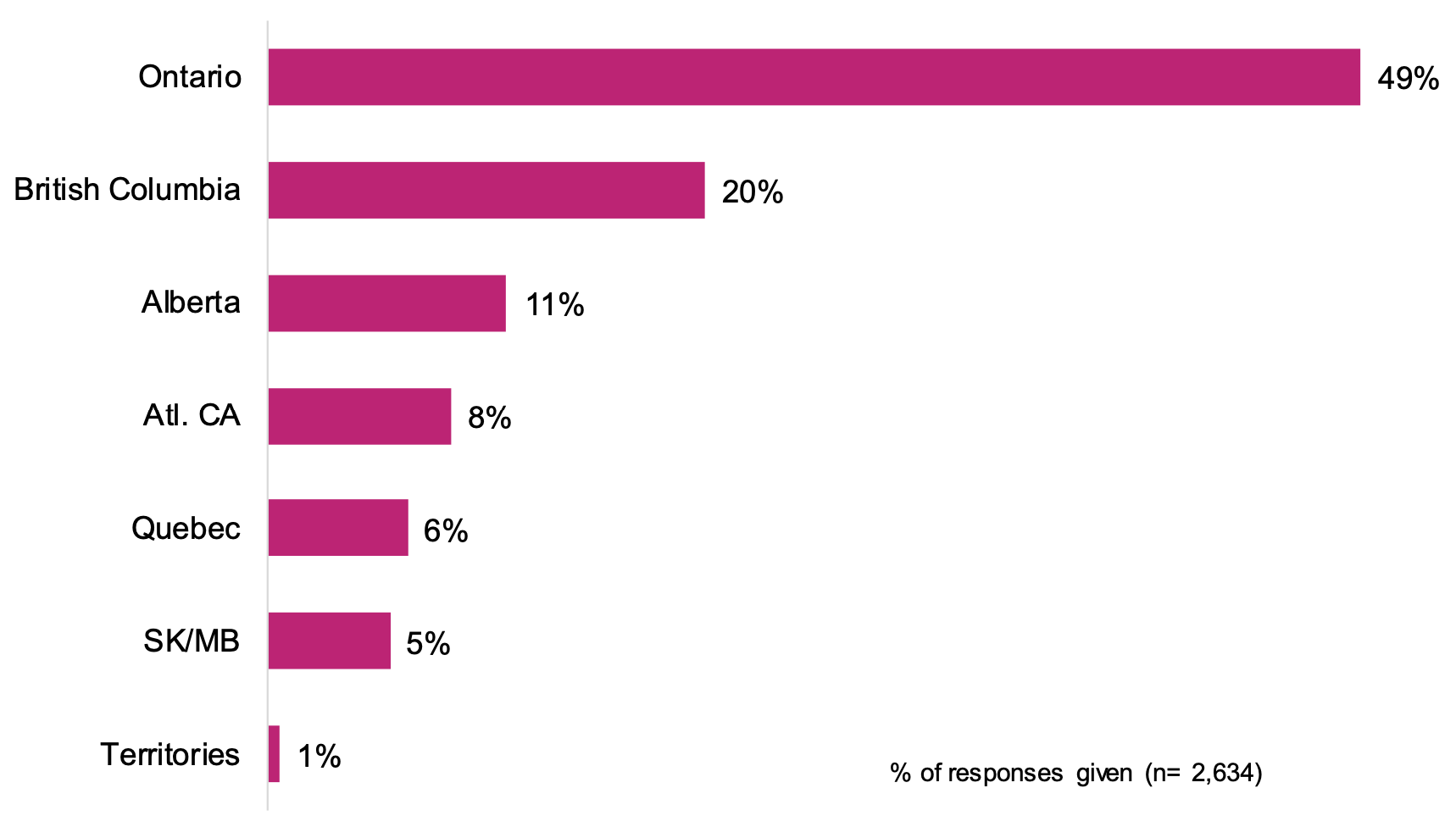
Survey Question: In which province or territory do you live?
Survey Responses: 2,634 people responded. 49% said 'Ontario.' 20% said 'British Columbia.' 11% said 'Alberta.' 8% said 'Atlantic Canada.' 6% said 'Quebec.' 5% said 'Saskatchewan or Manitoba.' 1% said 'Territories.'
Chart 5. Demographic results from the survey
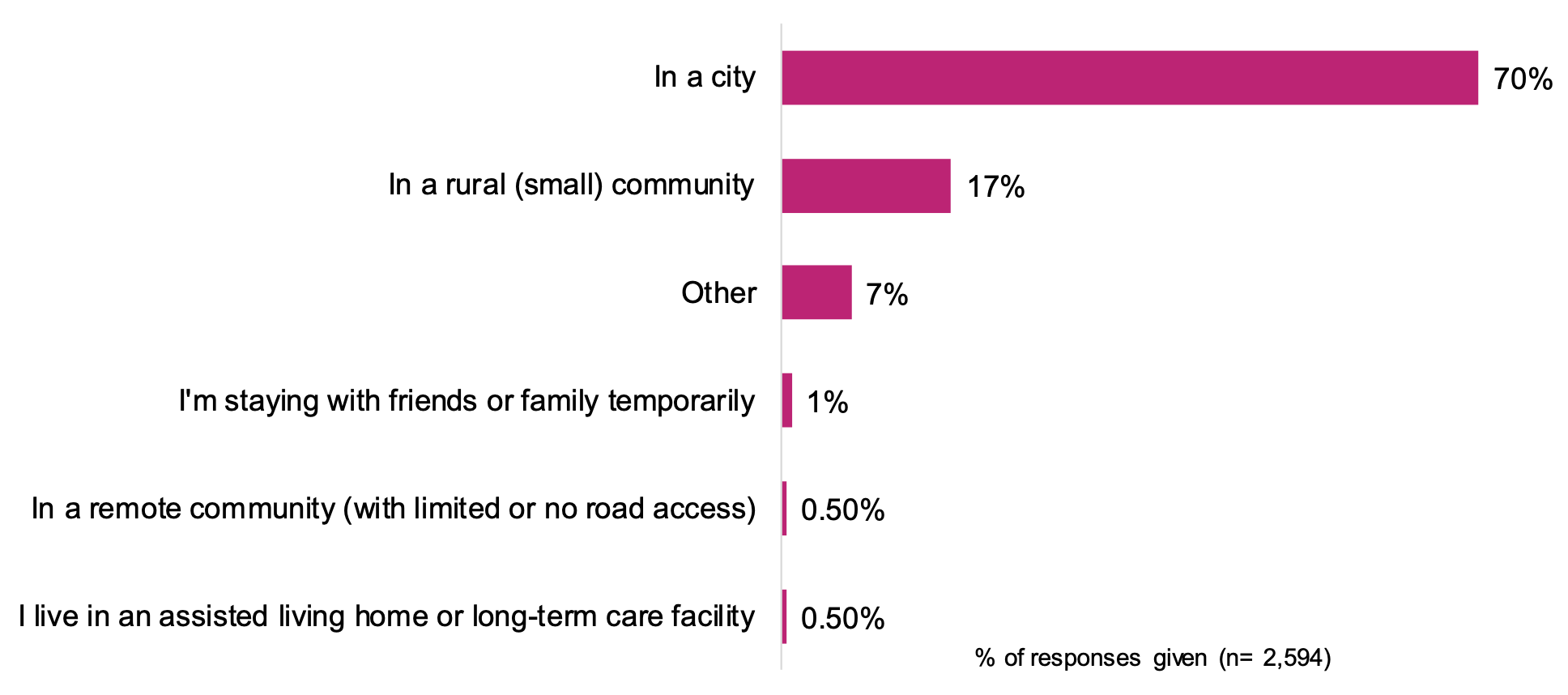
Survey Question: Where do you live?
Survey Responses: 2,594 people responded. 70% said 'in a city.' 17% said 'in a rural (small) community.' 7% said 'other.' 1% said 'I'm staying with friends or family temporarily.' One half of 1% said 'in a remote community (with limited or no road access).' One half of 1% said 'I live in an assisted living home or long-term care facility.'
Chart 6. Demographic results from the survey

Survey Question: Do you have a disability?
Survey Responses: 2,565 people responded. 64% said 'yes.' 29% said 'no.' 4% said 'sometimes.'
Chart 7. Demographic results from the survey
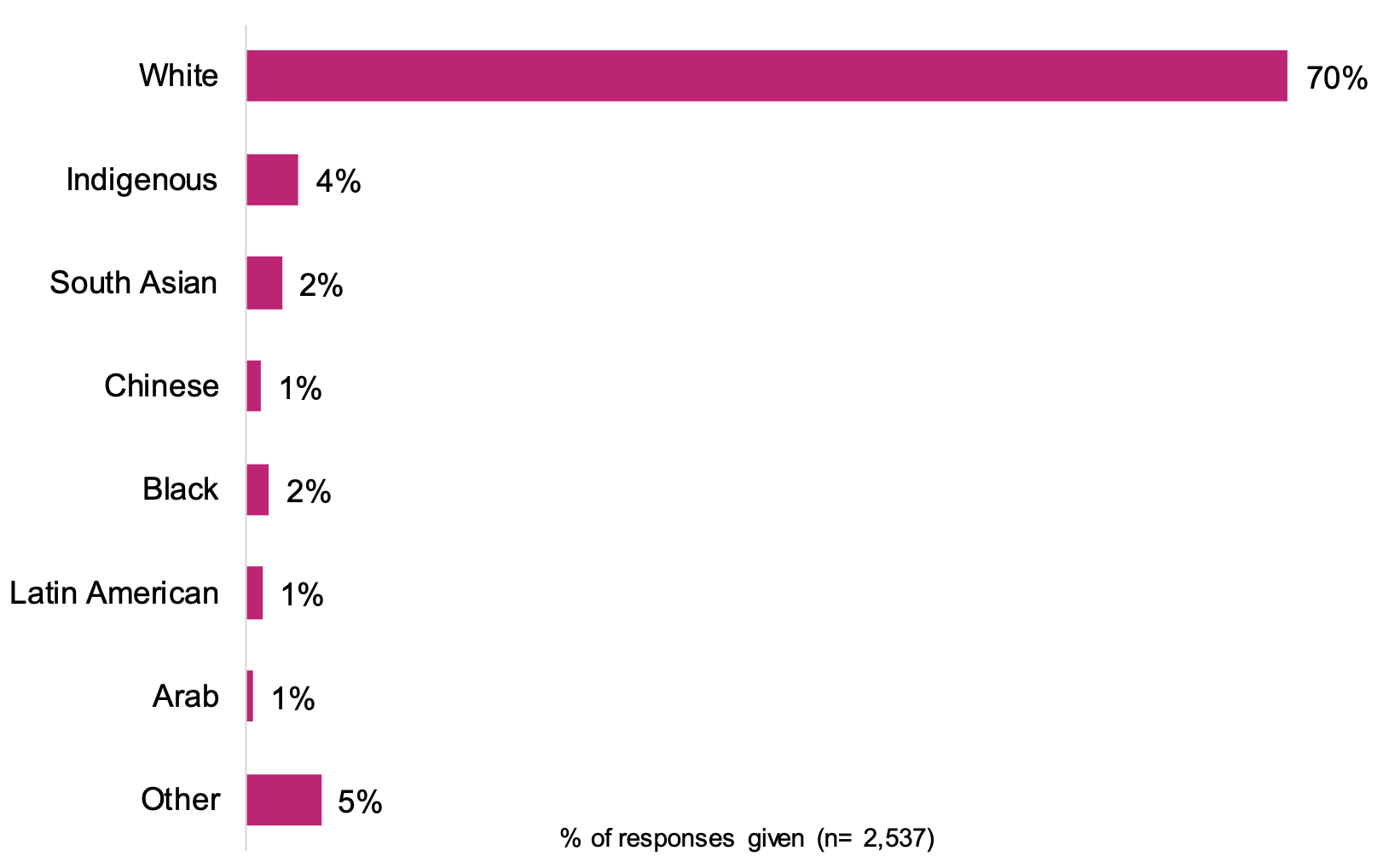
Survey Question: Do you identify as any of the following?
Survey Responses: 2,537 people responded. 70% said 'White.' 4% said 'Indigenous.' 2% said 'South Asian.' 2% said 'Black.' 1% said 'Chinese.' 1% said 'Latin American.' 1% said 'Arab.' 5% said 'other.'
Chart 8. Demographic results from the survey
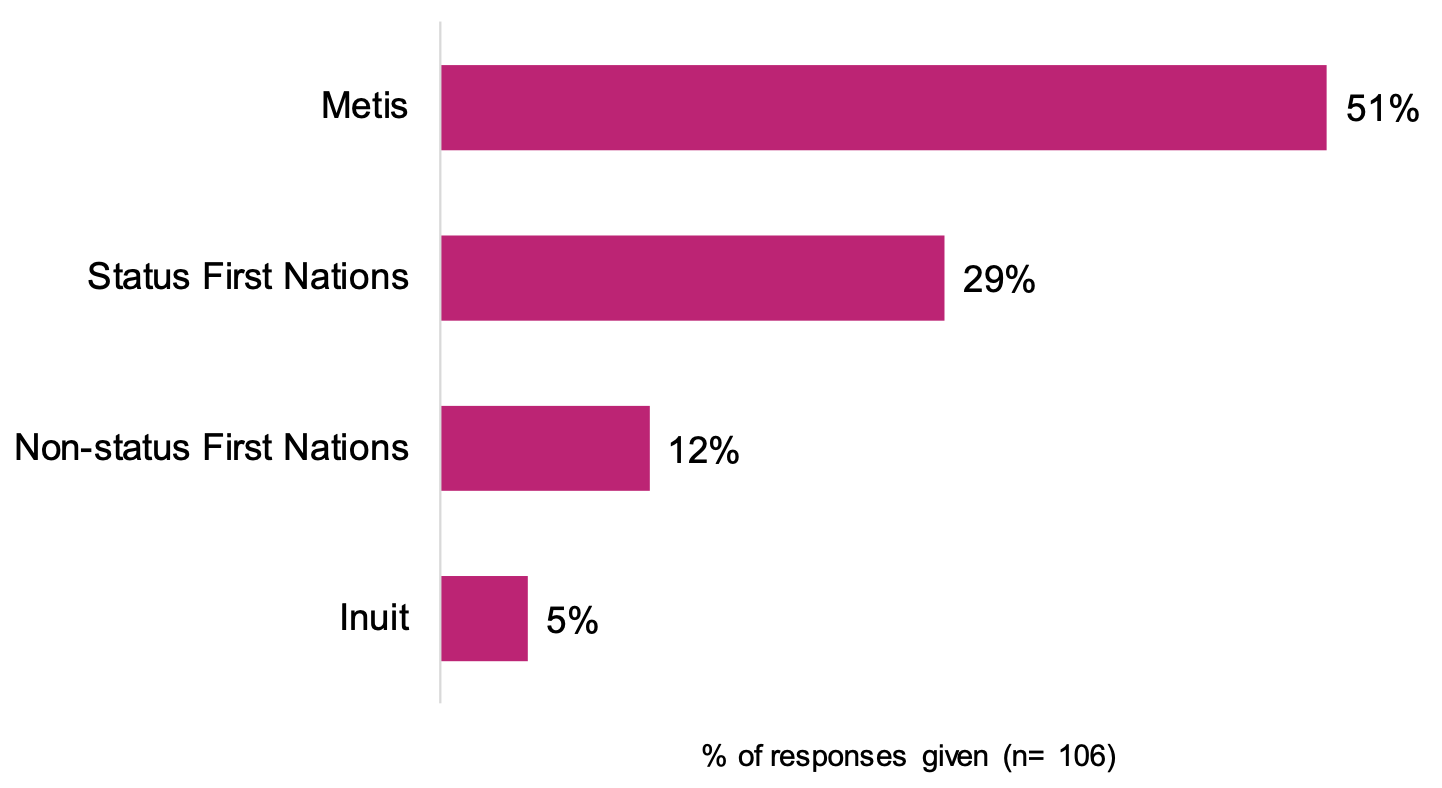
Survey Question: If Indigenous, do you identify as First Nations, Métis or Inuit?
Survey Responses: 106 people responded. 51% said 'Metis.' 29% said 'Status First Nations.' 12% said 'Non-status First Nations.' 5% said 'Inuit.'
Chart 9. Demographic results from the survey
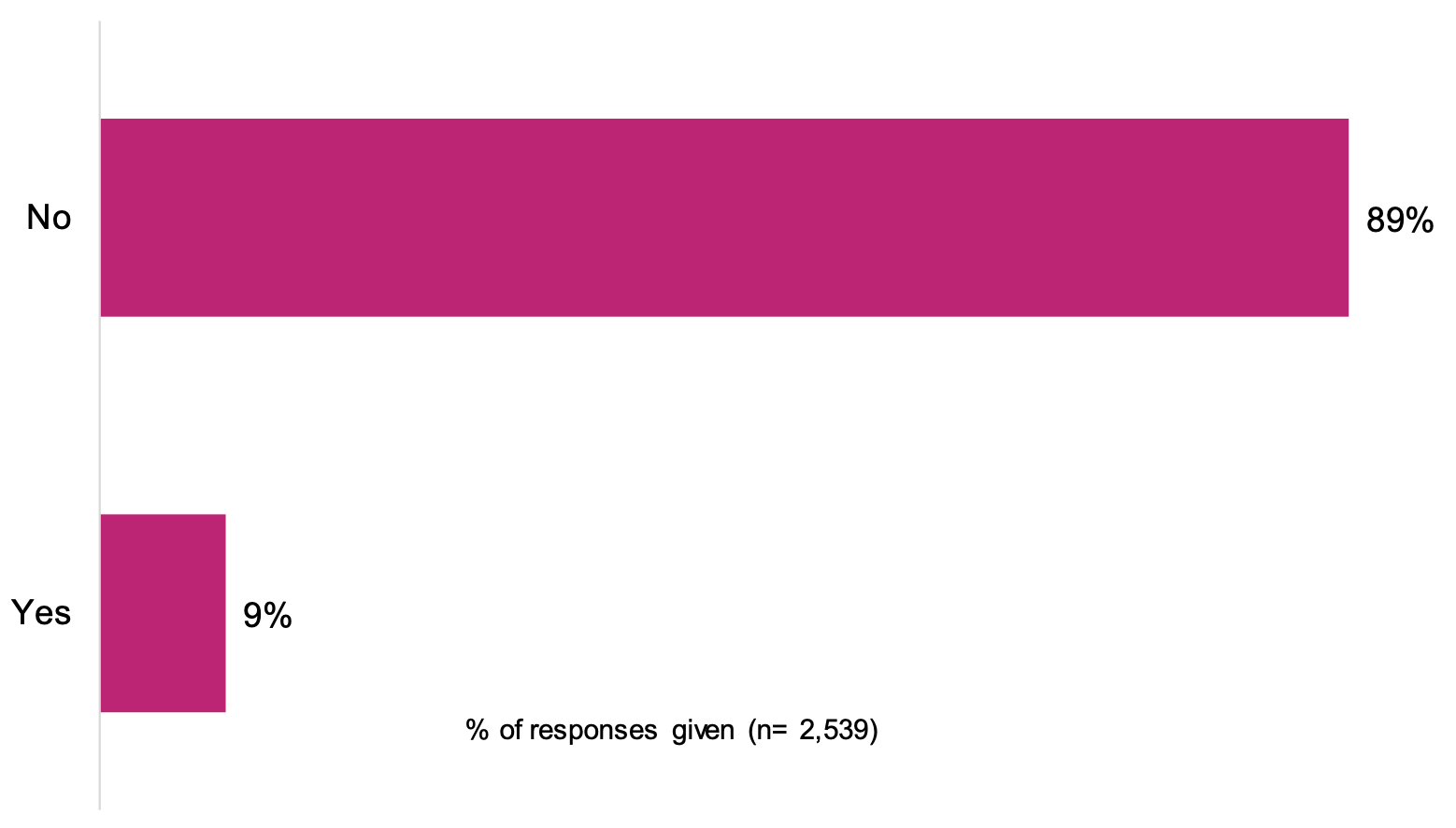
Survey Question: Do you identify as a Deaf person?
Survey Responses: 2,539 people responded. 89% said 'no.' 9% said 'yes.'
Chart 10. Demographic results from the survey
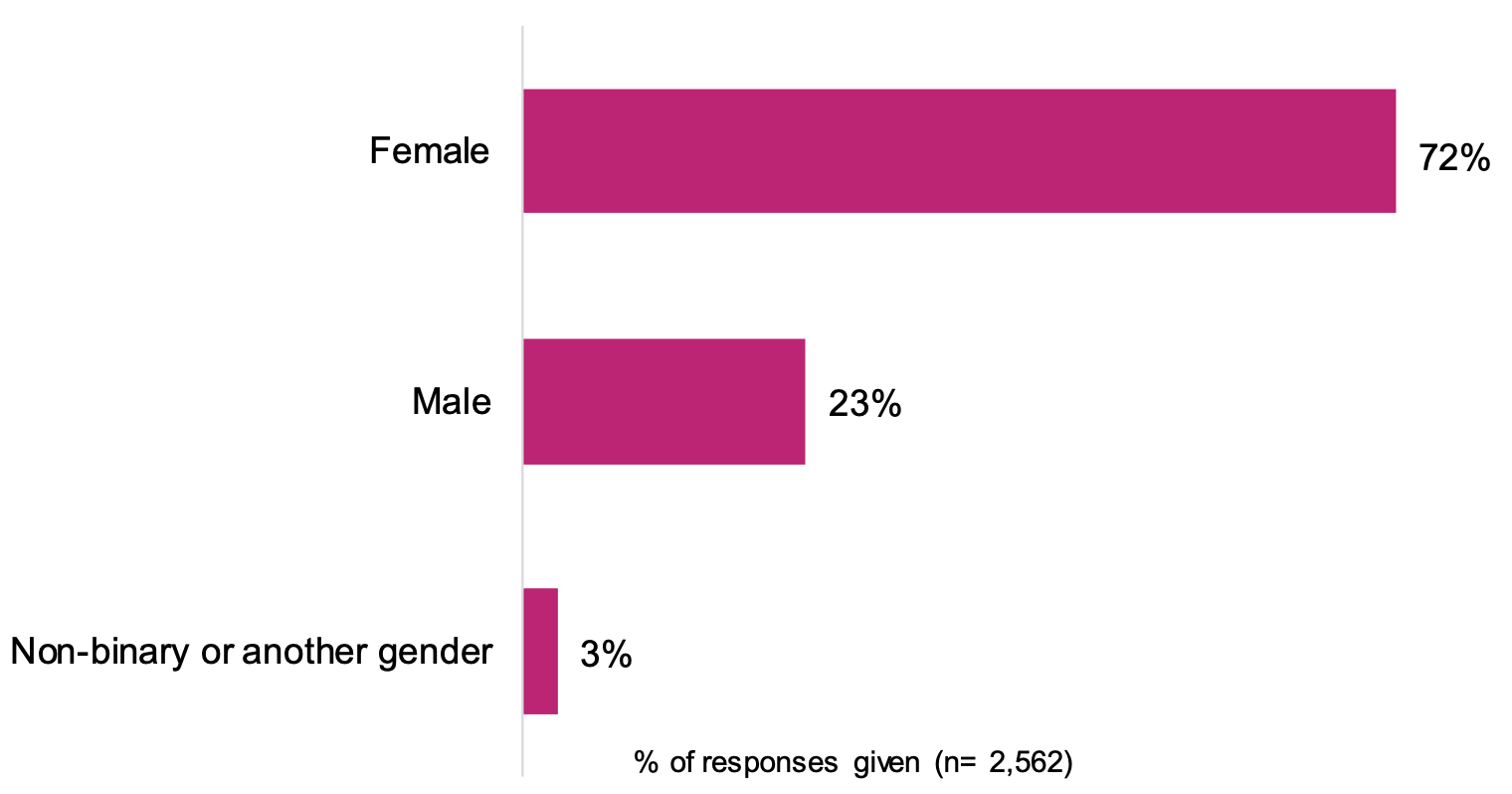
Survey Question: What is your gender?
Survey Responses: 2,562 people responded. 72% said 'female.' 23% said 'male.' 3% said 'non-binary or another gender.'
Chart 11. Demographic results from the survey
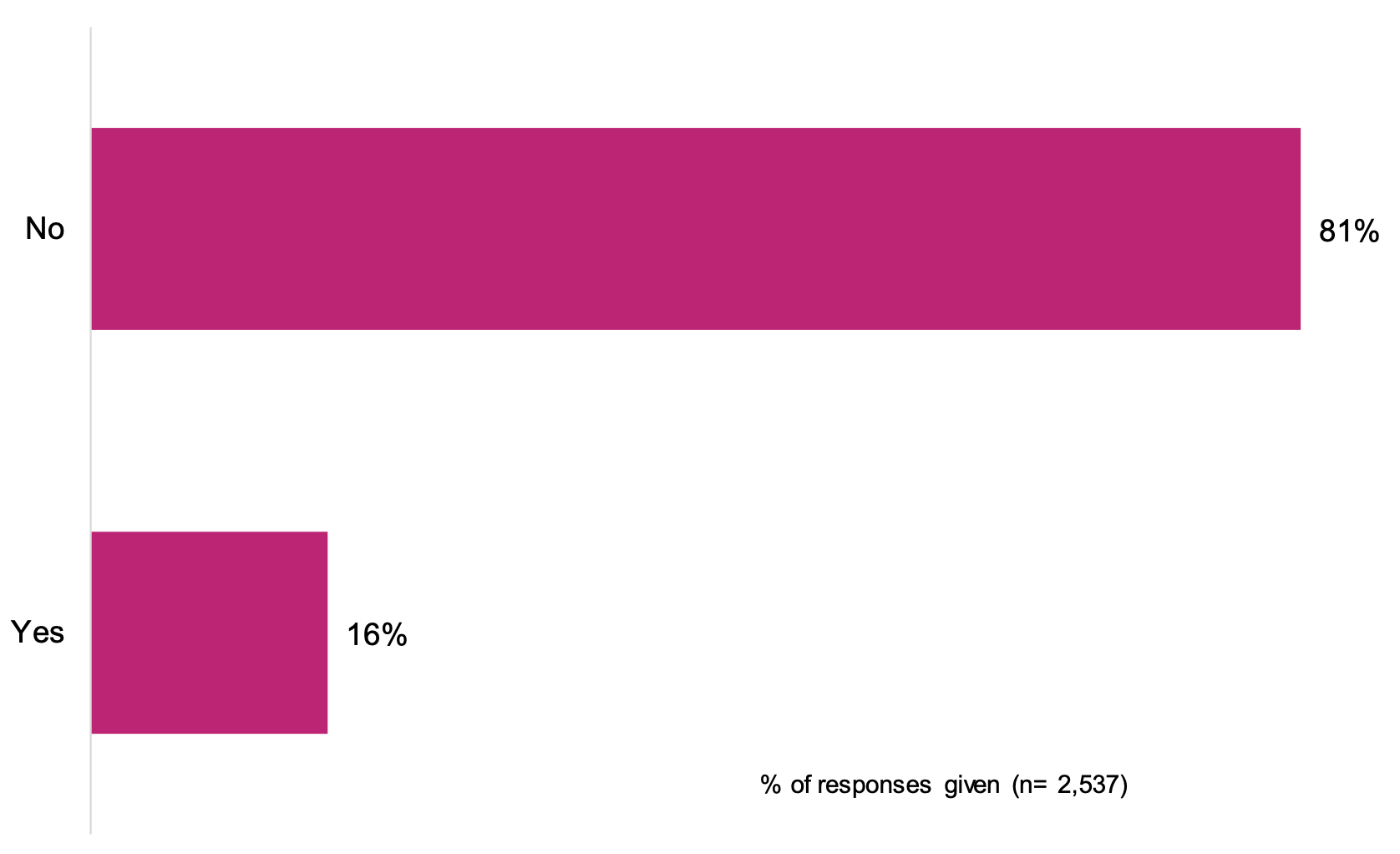
Survey Question: Do you identify as 2SLGBTQQIA?
Survey Responses: 2,537 people responded. 81% said 'no.' 16% said 'yes.'
Chart 12. Demographic results from the survey
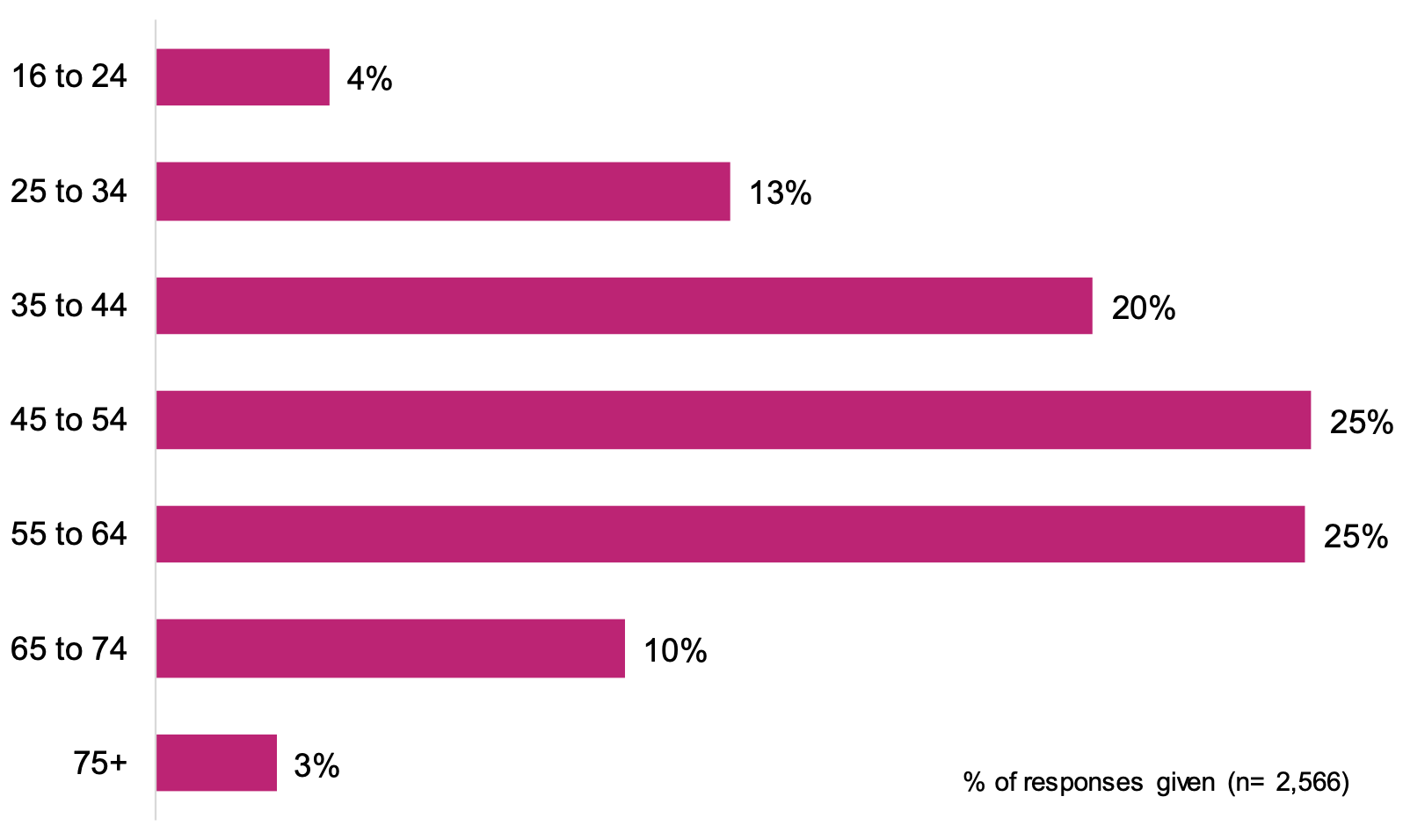
Survey Question: How old are you?
Survey Responses: 2,566 people responded. 4% said '16 to 24.' 13% said '25 to 34.' 20% said '35 to 44.' 25% said '45 to 54.' 25% said '55 to 64.' 10% said '65 to 74.' 3% said '75+.'
Chart 13. Demographic results from the online dialogue, or chat, sessions
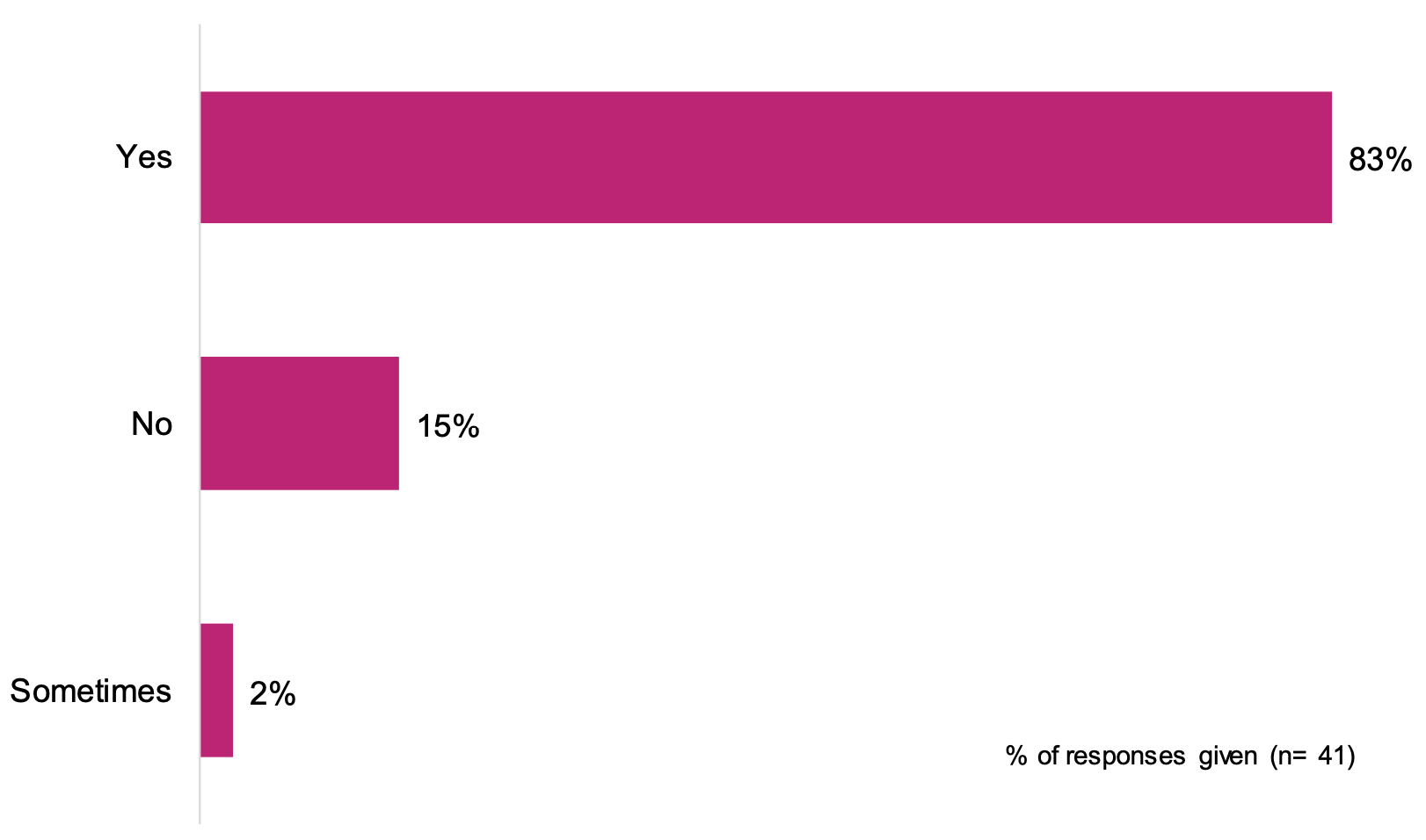
Dialogue Question: Do you have a disability?
Dialogue Responses: 41 people responded. 83% said 'yes.' 15% said 'no.' 2% said 'sometimes.'
Chart 14. Demographic results from the online dialogue, or chat, sessions
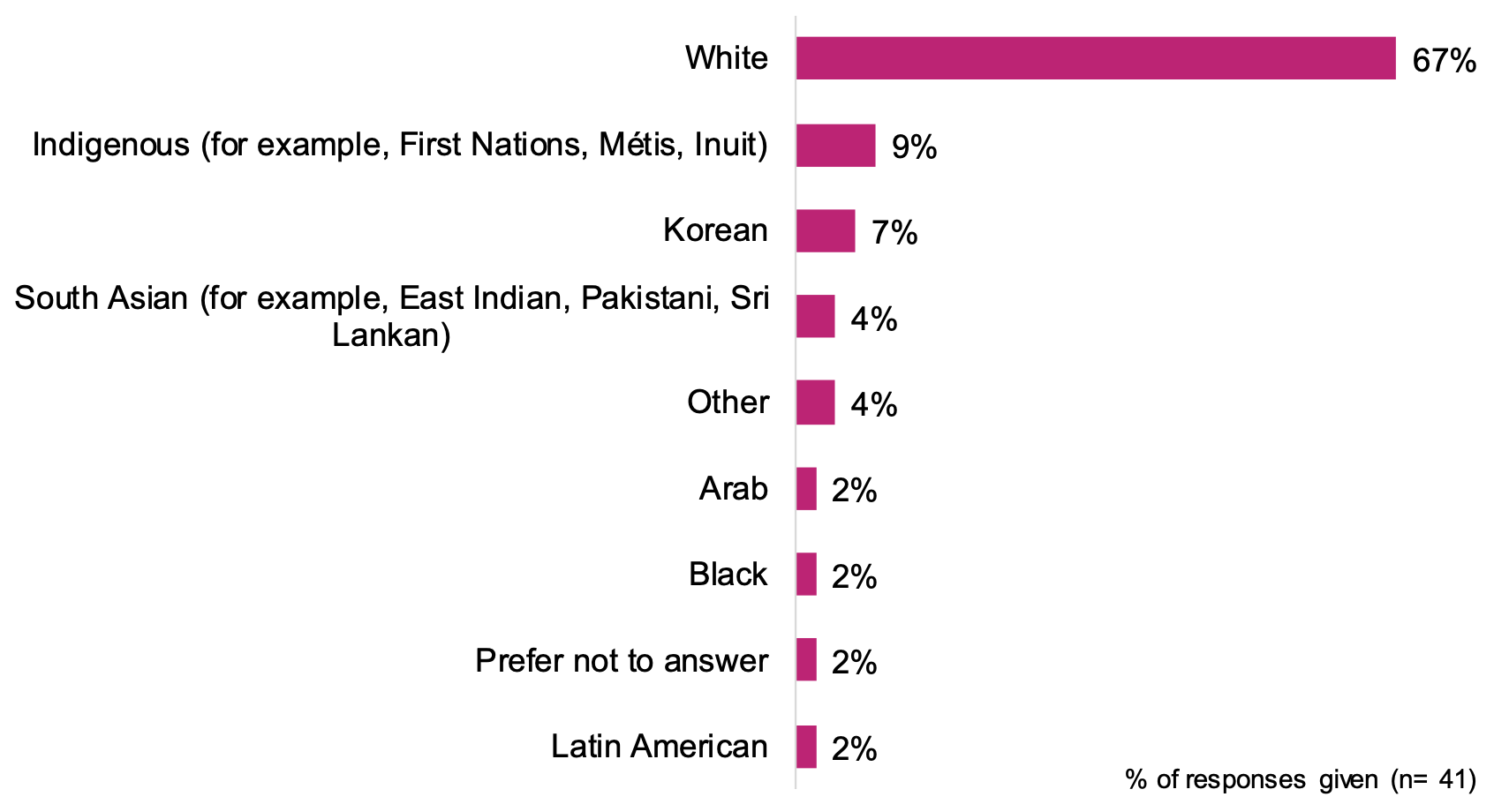
Dialogue Question: Do you identify as any of the following?
Dialogue Responses: 41 people responded. 67% said 'White.' 9% said 'Indigenous.' 7% said 'Korean.' 4% said 'South Asian.' 4% said 'other.' 2% said 'Arab.' 2% said 'Black.' 2% said 'Latin American.' 2% said 'prefer not to answer.'
Chart 15. Demographic results from the online dialogue, or chat, sessions
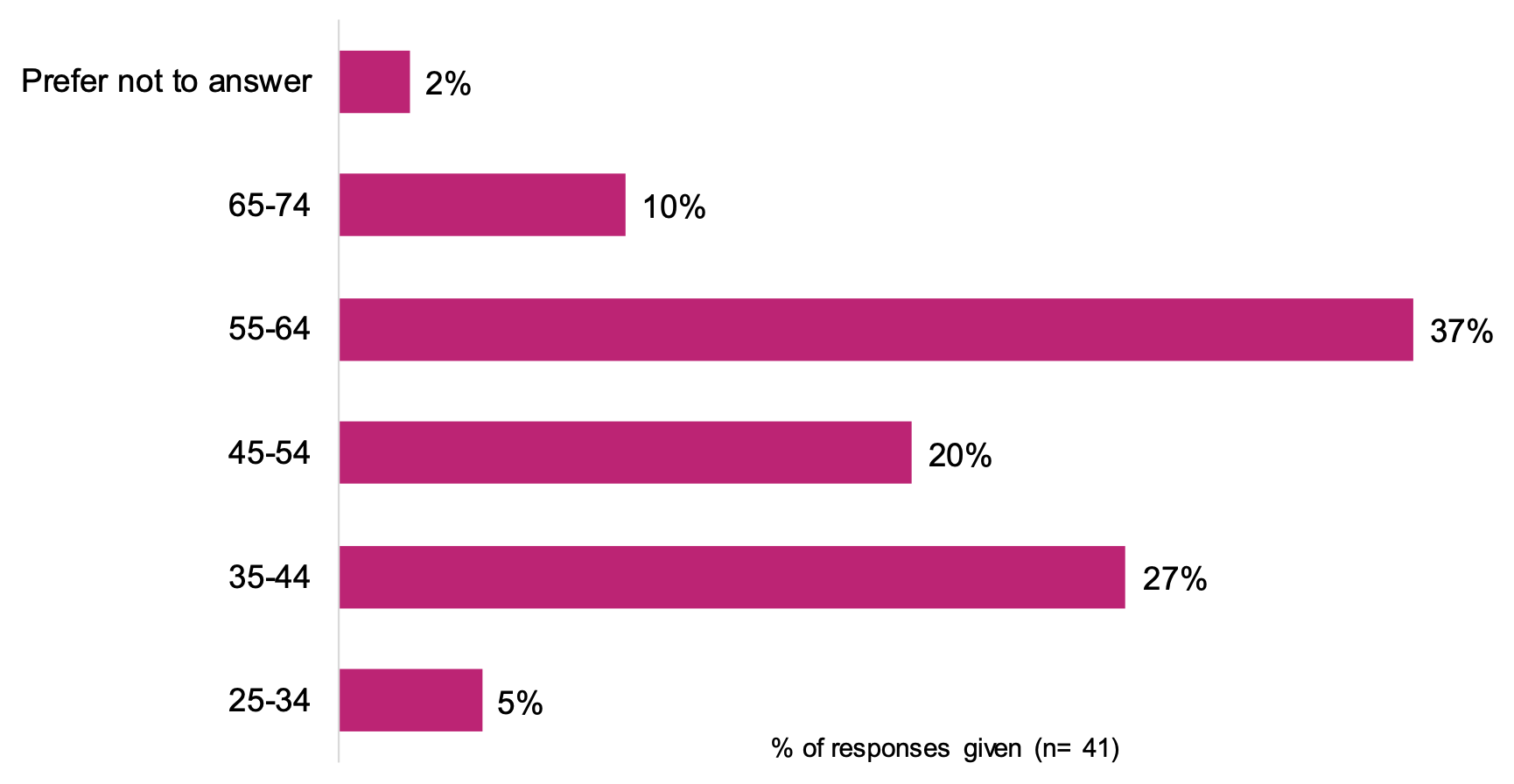
Dialogue Question: How old are you?
Dialogue Responses: 41 people responded. 5% said '25 to 34.' 27% said '35 to 44.' 20% said '45 to 54.' 37% said '55 to 64.' 10% said '65 to 74.' 2% said 'prefer not to answer.'
Chart 16. Demographic results from the online dialogue, or chat, sessions
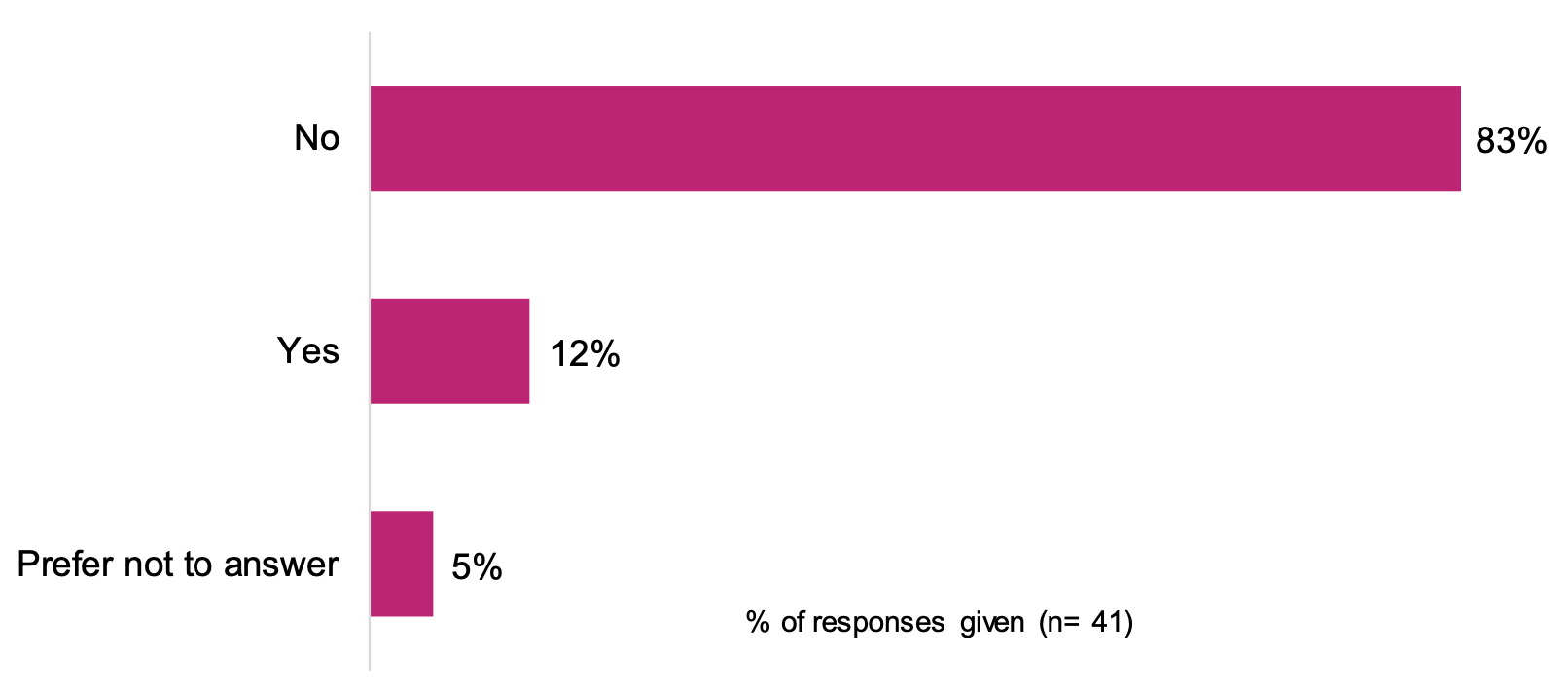
Dialogue Question: Do you identify as 2SLBGTQQIA?
Dialogue Responses: 41 people responded. 83% said 'no.' 12% said 'yes.' 5% said 'prefer not to answer.'
Chart 17. Demographic results from the online dialogue, or chat, sessions
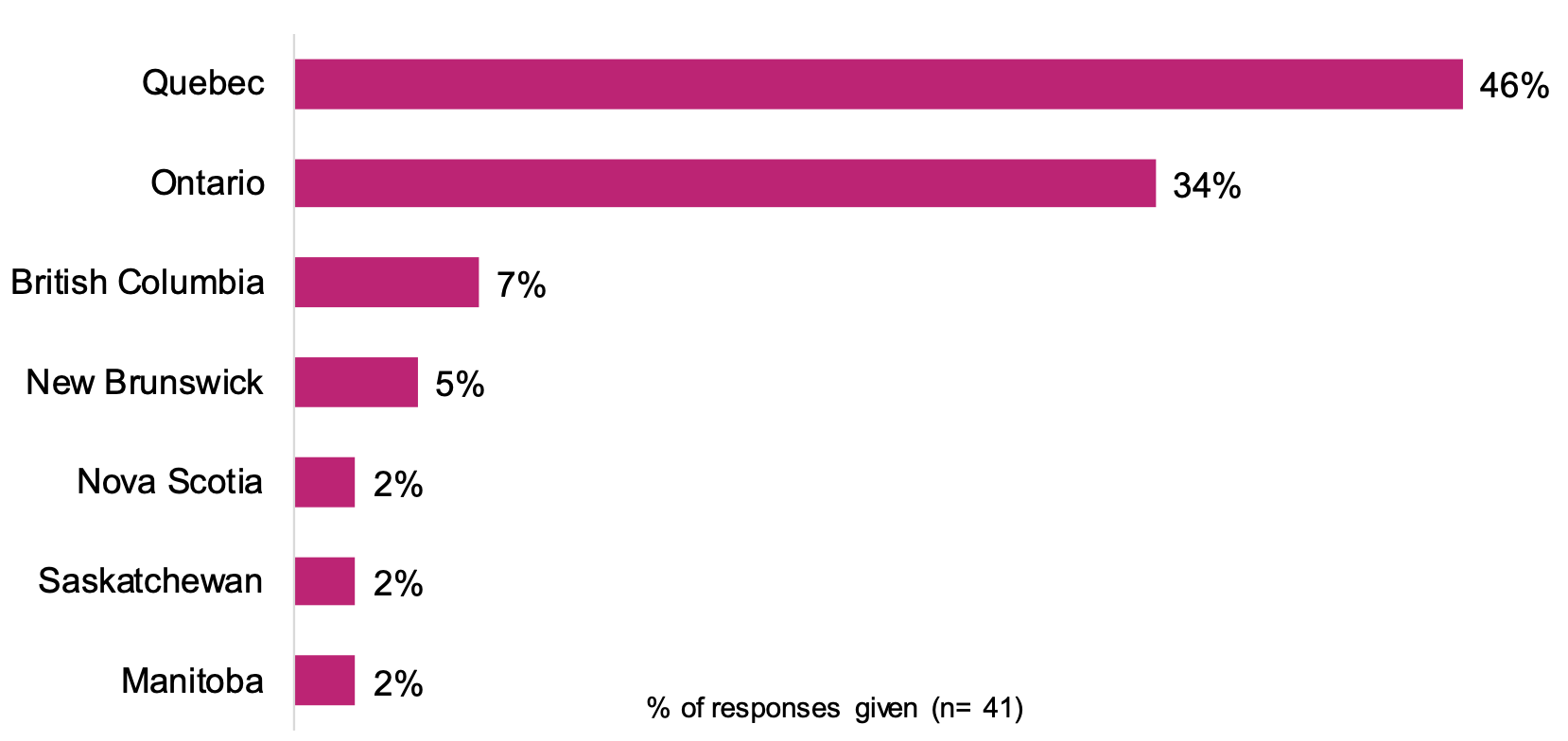
Dialogue Question: In which province or territory do you live?
Dialogue Responses: 41 people responded. 46% said 'Quebec.' 34% said 'Ontario.' 7% said 'British Columbia.' 5% said 'New Brunswick.' 2% said 'Nova Scotia.' 2% said 'Saskatchewan.' 2% said 'Manitoba.'
Chart 18. Familiarity: Commission, Convention and Accessible Canada Act
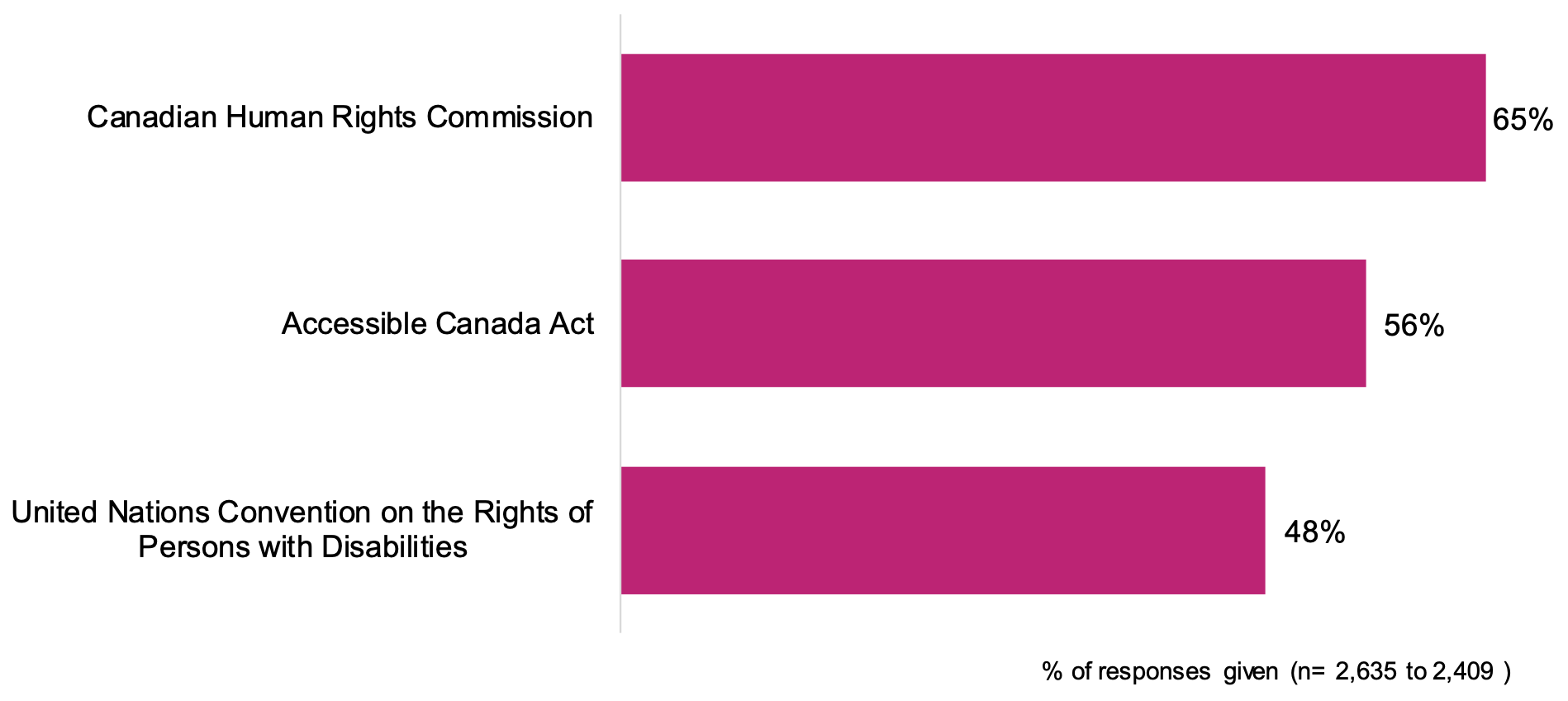
Survey Question: Before today, how much did you know about the following?
Survey Responses: This question had three parts. There was a range in the number of responses to this question. 2,635 to 2,409 people responded. 65% said 'very familiar or somewhat familiar with the Canadian Human Rights Commission.' 56% said 'very familiar or somewhat familiar with the Accessible Canada Act.' 48% said 'very familiar or somewhat familiar with the United Nations Convention on the Rights of Persons with Disabilities.'
Chart 19. Familiarity: Positive effect from the Convention
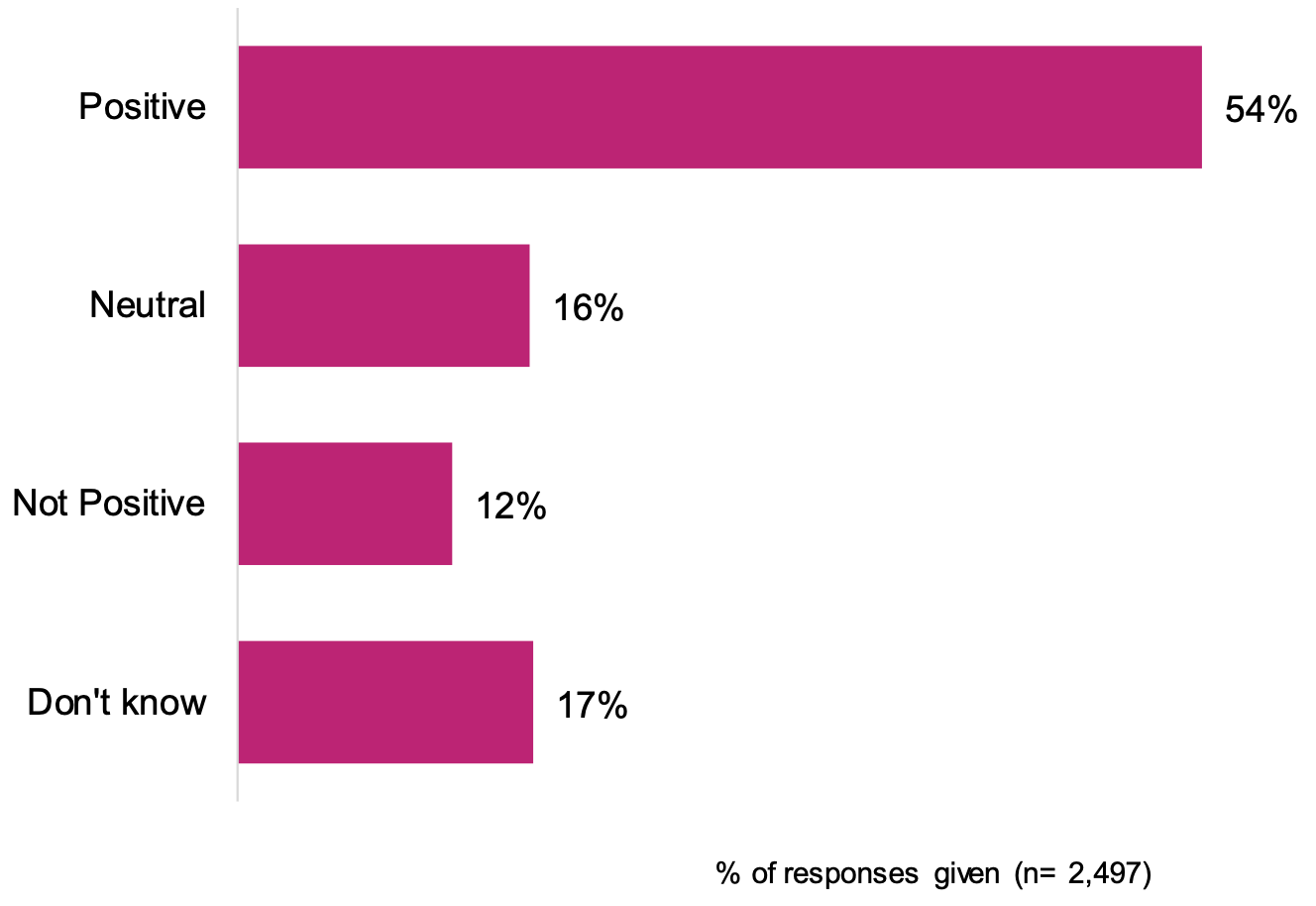
Survey Question: How much positive effect do you think the Convention will have for people with disabilities?
Survey Responses: 2,497 people responded. The answers were grouped as follows. 54% said 'positive.' 16% said 'neutral.' 12% said 'not positive.' 17% said 'don't know.'
Chart 20. Familiarity: Importance of the Commission to partner
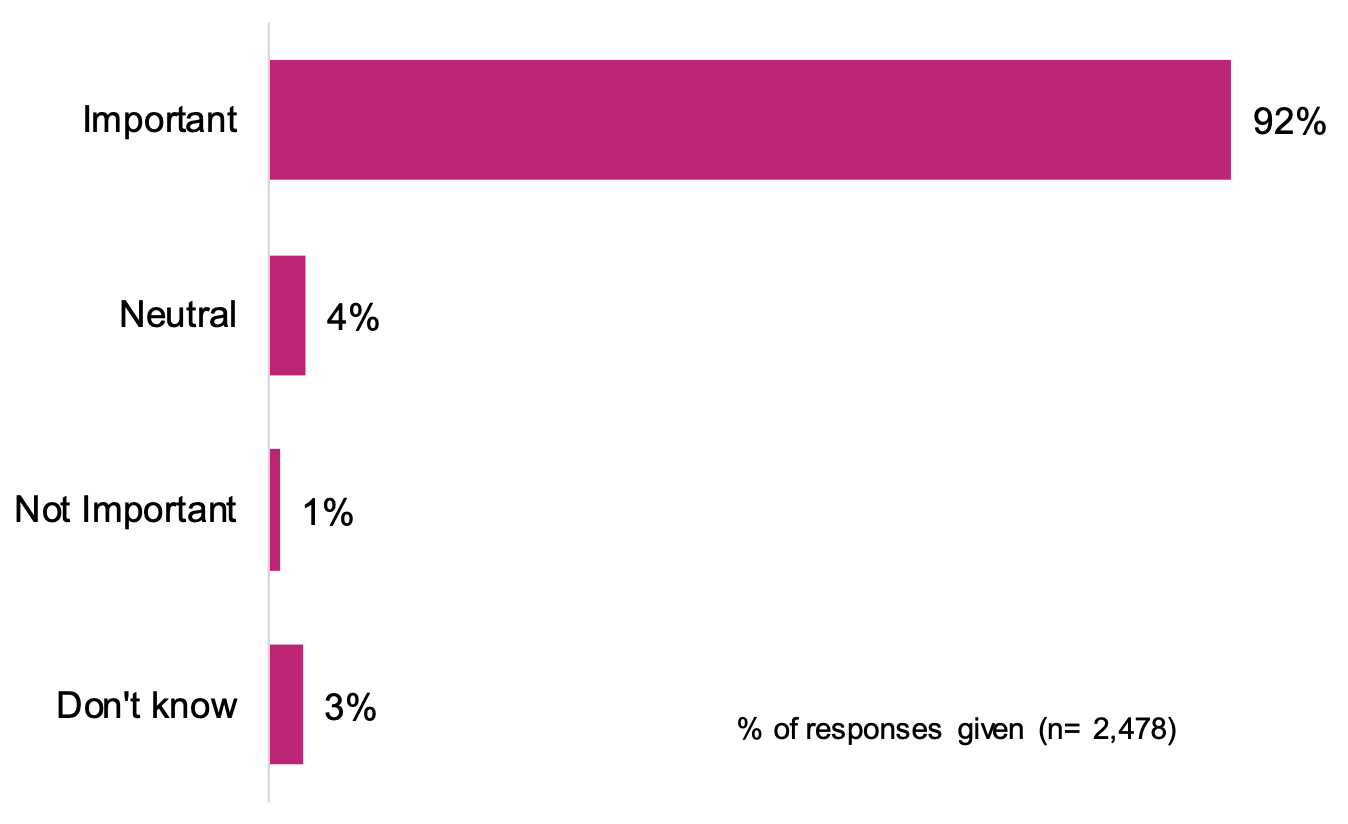
Survey Question: How important do you think it is for the Commission to partner with others to make sure Canada follows the Convention?
Survey Responses: 2,478 people responded. The answers were grouped as follows. 92% said 'important.' 4% said 'neutral.' 1% said 'not important.' 3% said 'don't know.'
Chart 21. Guiding Principles: Participation
Survey Question: In this question, we are asking you to share any examples from your life where you were not able, comfortable or asked to take part in decision making about an issue that affected you.
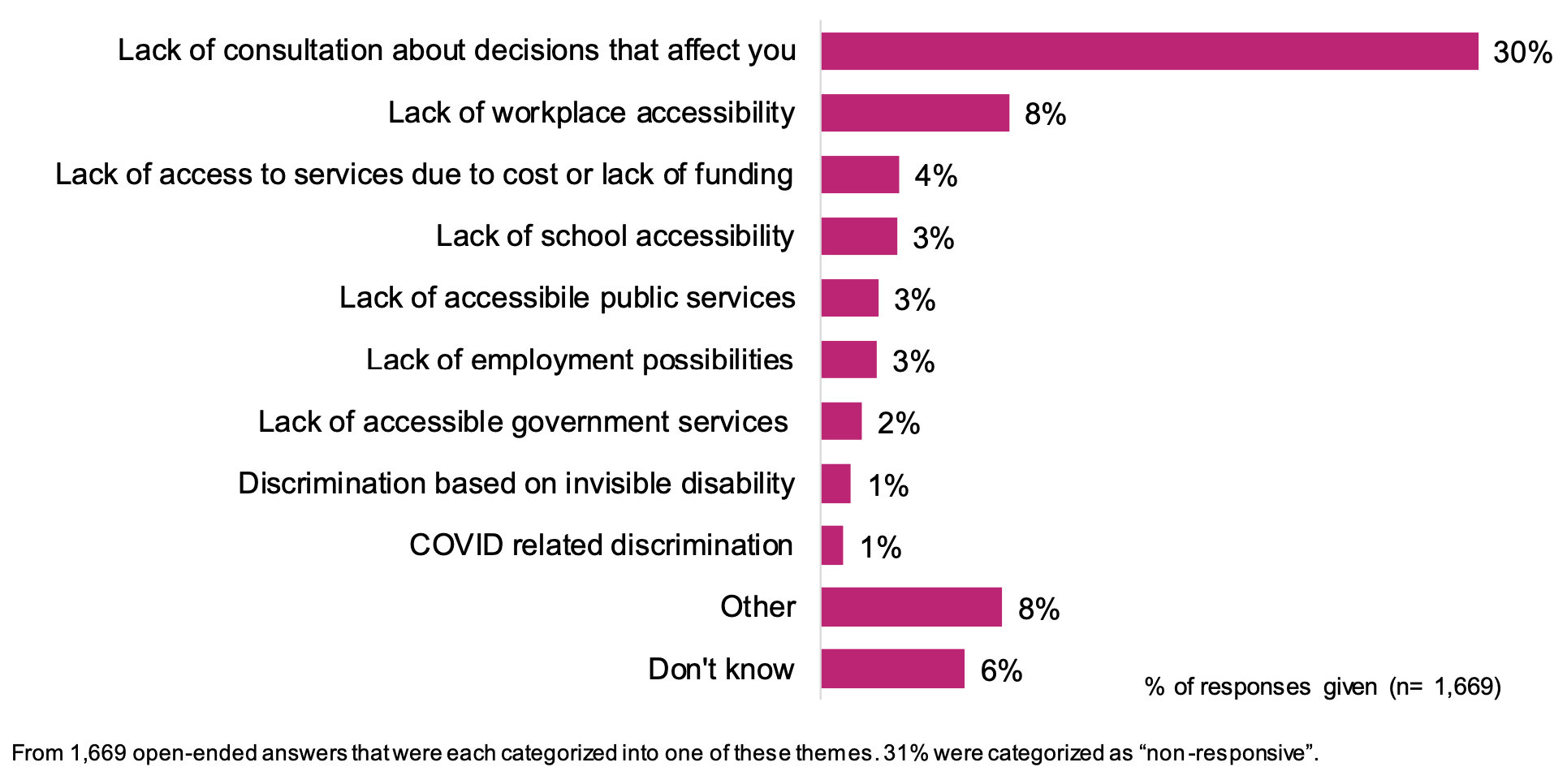
Survey Answers: 1,669 people responded. 30% said 'lack of consultation about decisions that affect you.' 8% said 'lack of workplace accessibility.' 4% said 'lack of access to services due to cost or lack of funding.' 3% said 'lack of school accessibility.' 3% said 'lack of accessible public services. 3% said 'lack of employment possibilities.' 2% said 'lack of accessible government services.' 1% said 'discrimination based on invisible disability.' 1% said 'COVID-19 related discrimination.' 8% said 'other.' 6% said 'don't know.' In this question, 31% were categorized as 'non-responsive.'
Chart 22. Guiding Principles: Participation
Survey Question: What kept you from taking part?
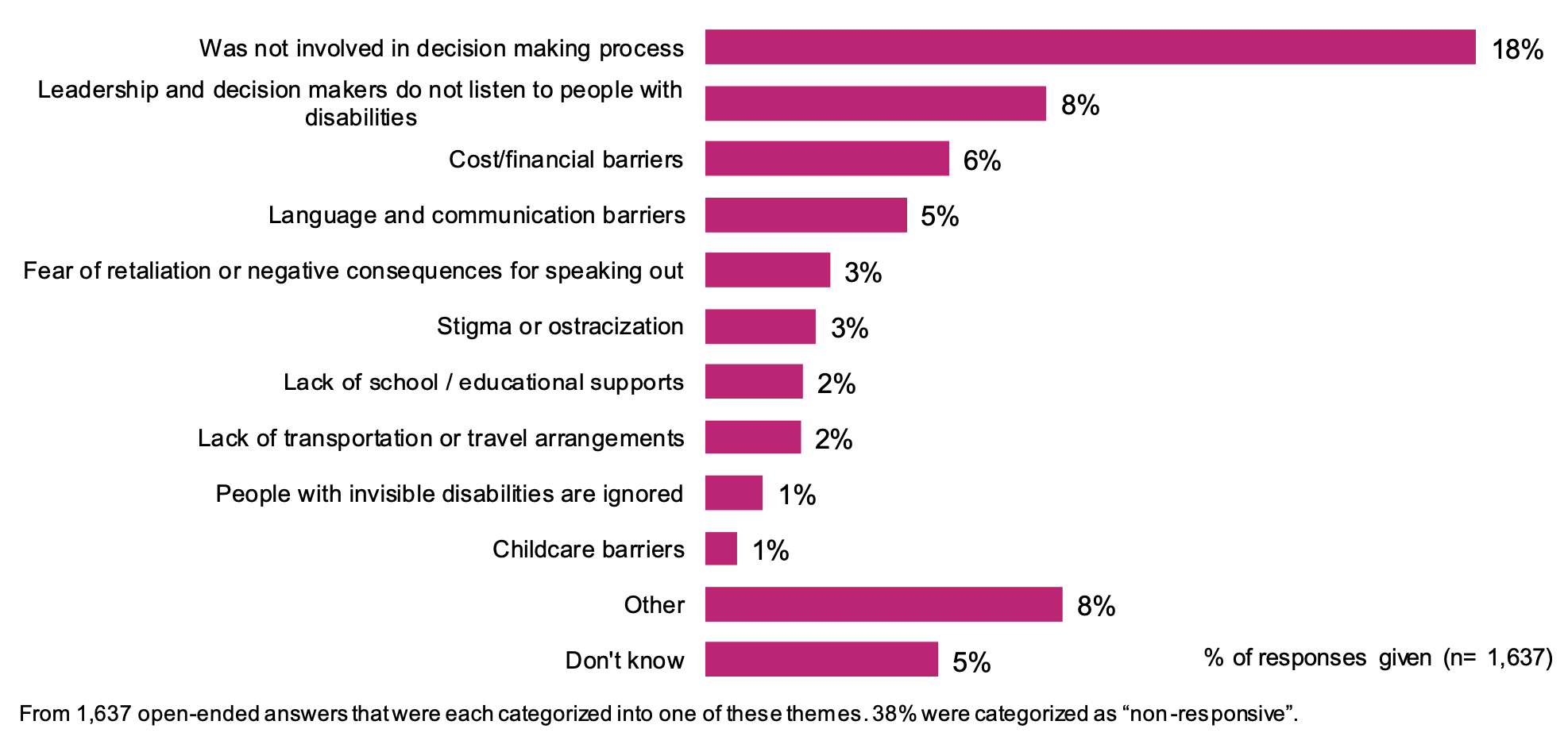
Survey Responses: 1,637 people responded. 18% said 'was not involved in decision making process.' 8% said 'leadership and decision makers do not listen to people with disabilities.' 6% said 'cost or financial barriers.' 5% said 'language and communication barriers.' 3% said 'fear of retaliation or negative consequences for speaking out.' 3% said 'stigma or ostracization.' 2% said 'lack of school or educational supports.' 2% said 'lack of transportation or travel arrangements.' 1% said 'people with invisible disabilities are ignored.' 1% said 'childcare barriers.' 8% said 'other.' 5% said 'don't know.' In this question, 38% were categorized as 'non-responsive.'
Chart 23. Guiding Principles: Accessibility
Survey Question: Can you think of any examples from your life where you faced barriers to taking part in an activity?
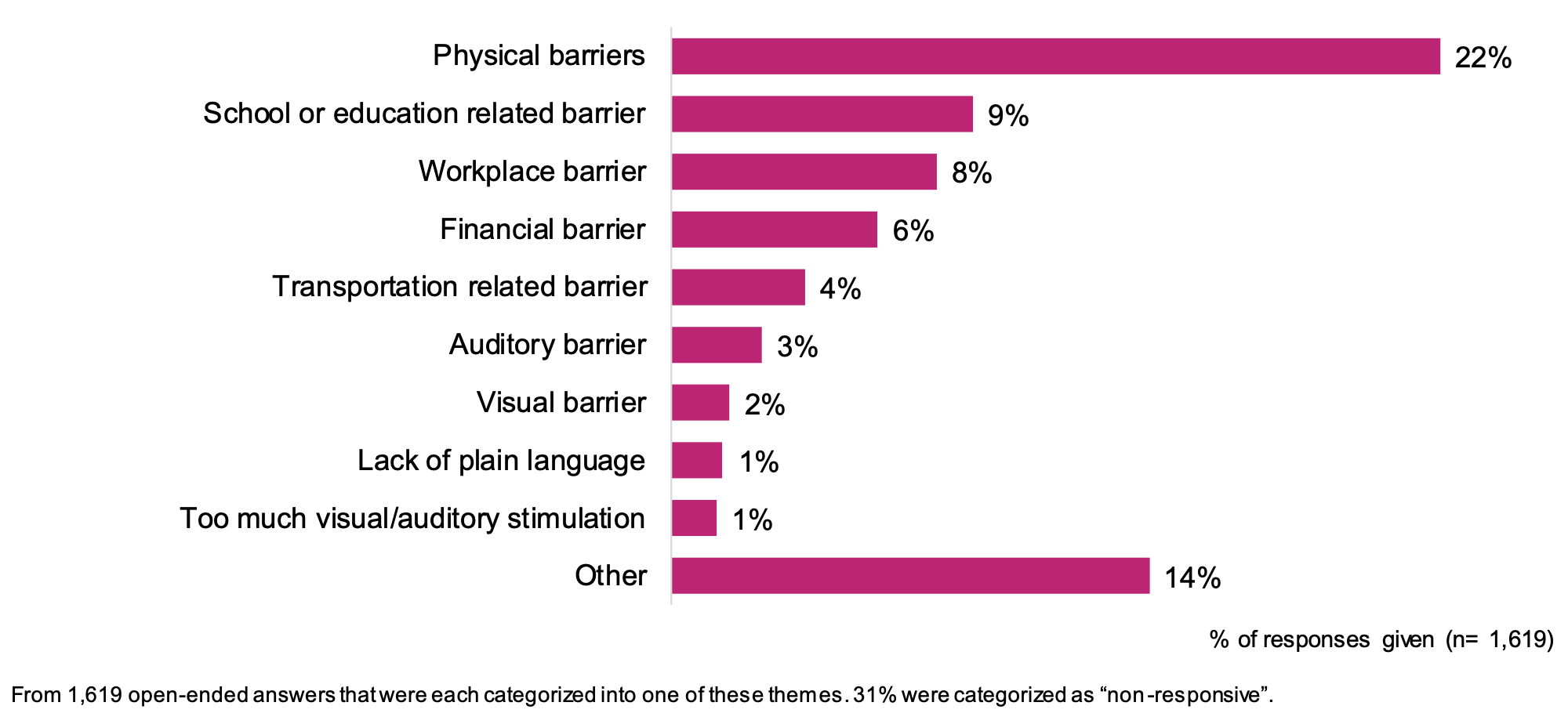
Survey Responses: 1,619 people responded. 22% said 'physical barriers.' 9% said 'school or education related barrier.' 8% said 'workplace barrier.' 6% said 'financial barrier.' 4% said 'transportation related barrier.' 3% said 'auditory barrier.' 2% said 'visual barrier.' 1% said 'lack of plain language.' 1% said 'too much visual or auditory stimulation.' 14% said 'other.' In this question, 31% were categorized as 'non-responsive.'
Chart 24. Guiding Principles: Accessibility
Survey Question: Can you tell us anything that might have helped in your example?
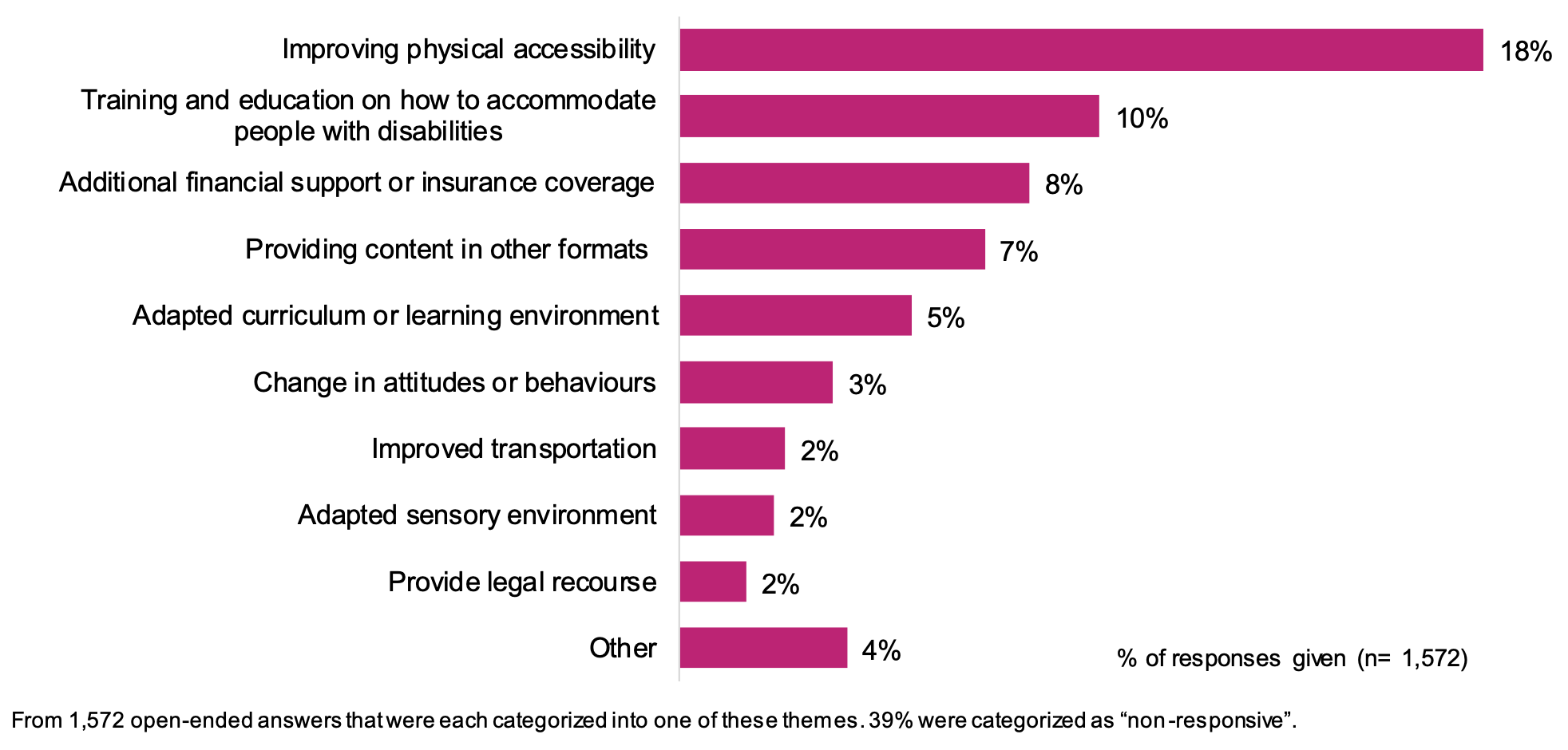
Survey Responses: 1,572 people responded. 18% said 'improving physical accessibility.' 10% said 'training and education on how to accommodate people with disabilities.' 8% said 'additional financial support or insurance coverage.' 7% said 'providing content in other formats.' 5% said 'adapted curriculum or learning environment.' 3% said 'change in attitudes or behaviours.' 2% said 'improved transportation.' 2% said 'adapted sensory environment.' 2% said 'provide legal recourse.' 4% said 'other.' In this question, 39% were categorized as 'non-responsive.'
Chart 25. Guiding Principles: Equality and non-discrimination
Survey Question: Can you share any examples from your life where you were not treated equally or discriminated against because of your disability?
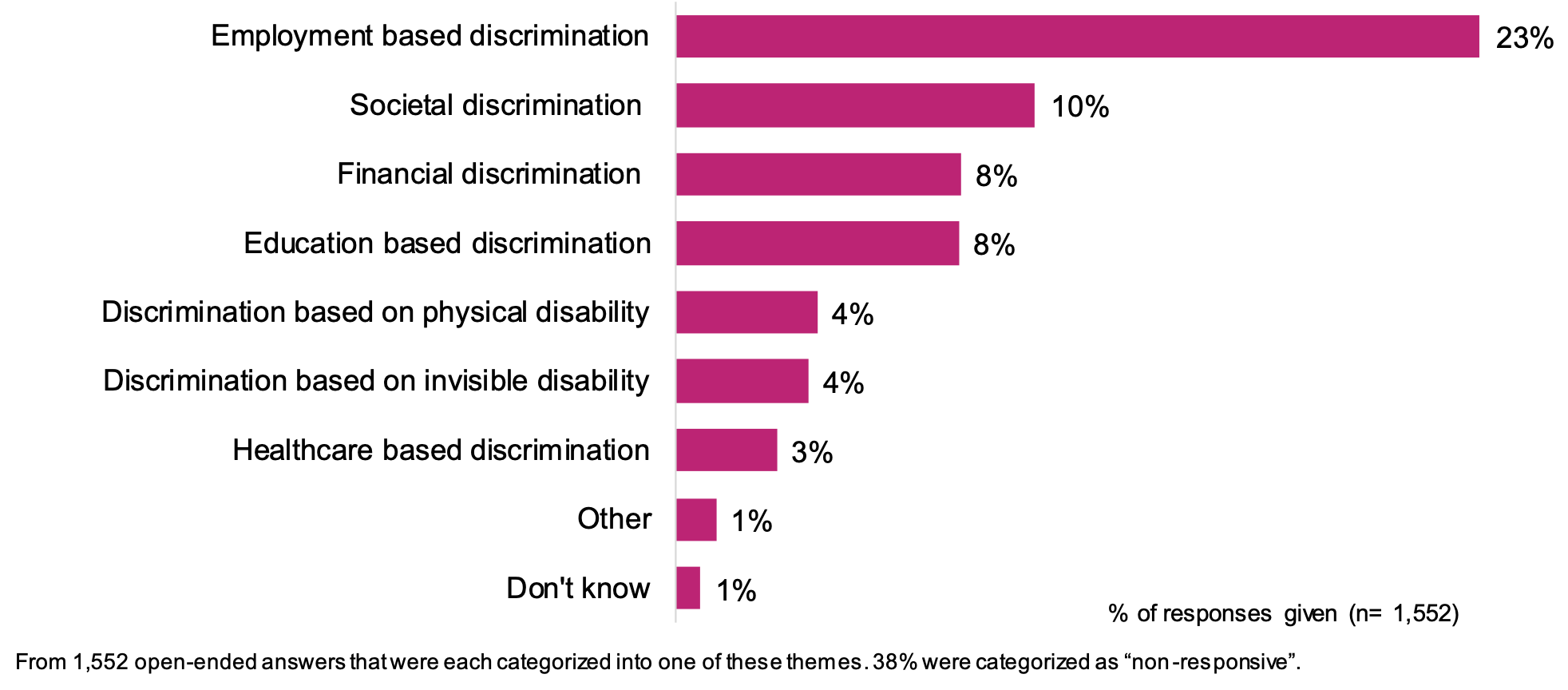
Survey Responses: 1,552 people responded. 23% said 'employment based discrimination.' 10% said 'societal discrimination.' 8% said 'financial discrimination.' 8% said 'education based discrimination.' 4% said 'discrimination based on physical disability.' 4% said 'discrimination based on invisible disability.' 3% said 'healthcare based discrimination.' 1% said 'other.' 1% said 'don't know.' In this question, 38% were categorized as 'non-responsive.'
Chart 26. Guiding Principles: Equality and non-discrimination
Survey Question: Can you tell us anything that might have helped in your example?
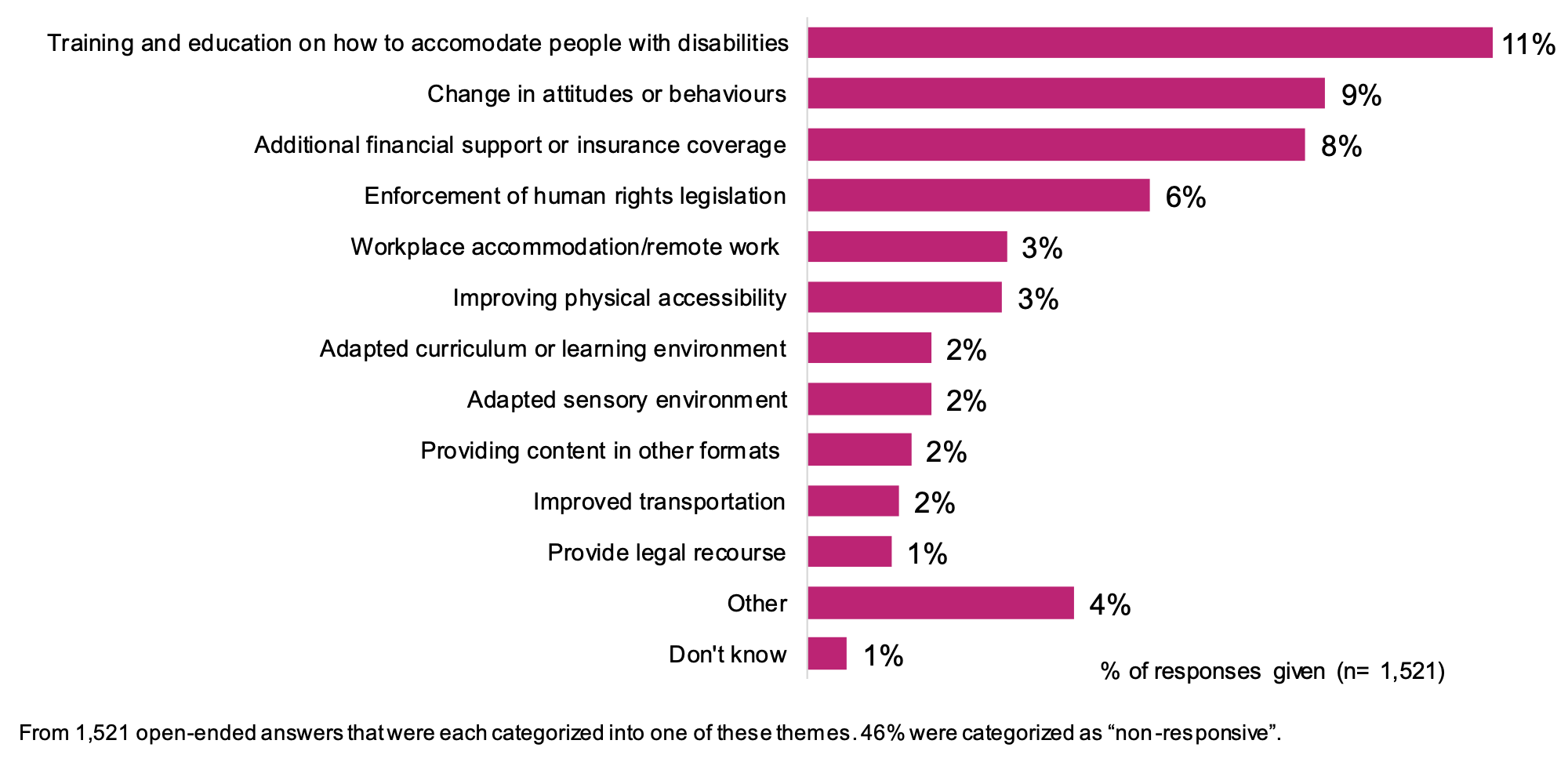
Survey Responses: 1,521 people responded. 11% said 'training and education on how to accommodate people with disabilities.' 9% said 'change in attitudes or behaviours.' 8% said 'additional financial support or insurance coverage.' 6% said 'enforcement of human rights legislation.' 3% said 'workplace accommodations or remote work.' 3% said 'improving physical accessibility.' 2% said 'adapted curriculum or learning environment.' 2% said 'adapted sensory environment.' 2% said 'providing content in other formats.' 2% said 'improved transportation.' 1% said 'provide legal recourse.' 4% said 'other.' 1% said 'don't know.' In this question, 46% were categorized as 'non-responsive.'
Chart 27. Guiding Principles: Intersectionality
Survey Question: Can you think of any examples from your life where you felt you were treated unfairly because of the combination of factors related to your identity?
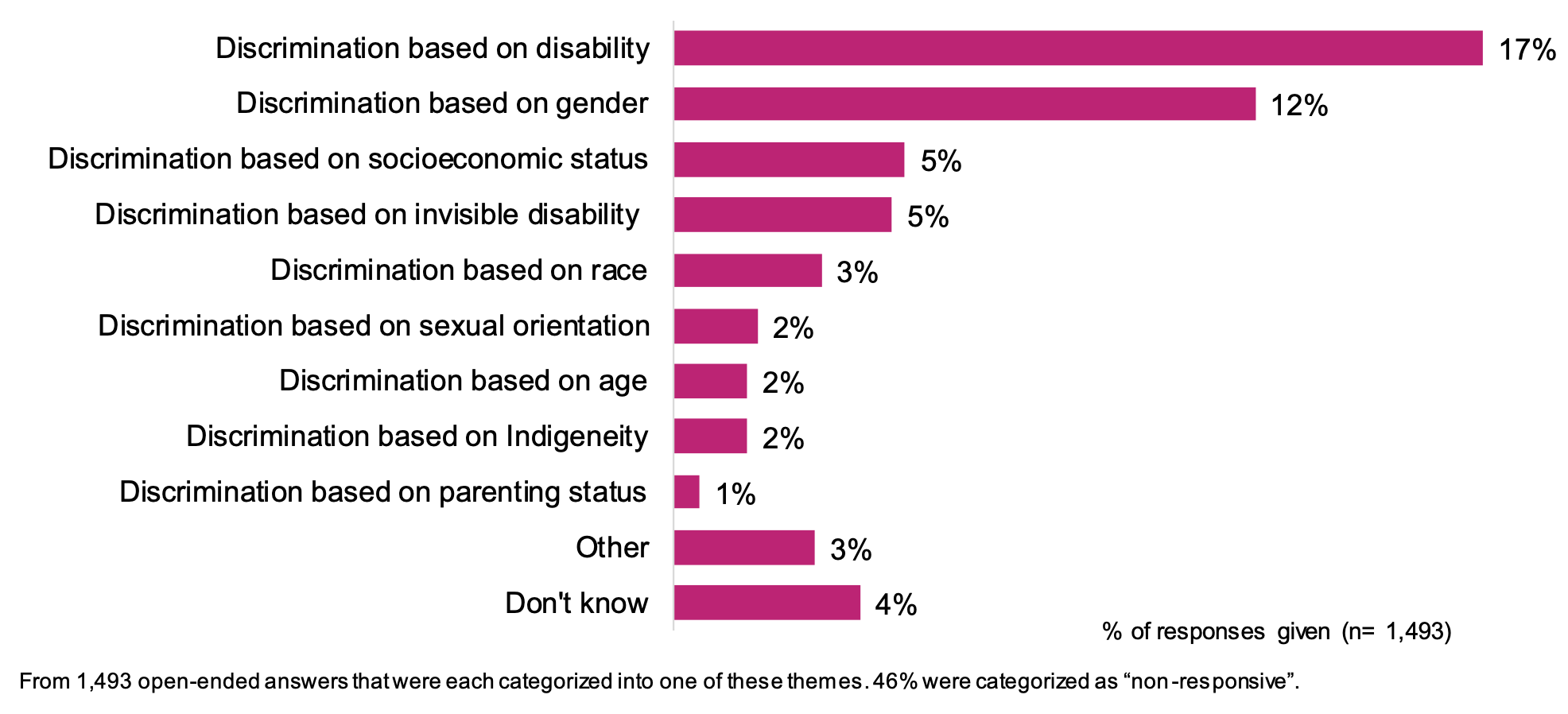
Survey Responses: 1,493 people responded. 17% said 'discrimination based on disability.' 12% said 'discrimination based on gender.' 5% said 'disability based on socioeconomic status.' 5% said 'discrimination based on invisible disability.' 3% said 'discrimination based on race.' 2% said 'discrimination based on sexual orientation.' 2% said 'discrimination based on age.' 2% said 'discrimination based on Indigeneity.' 1% said 'discrimination based on parenting status.' 3% said 'other.' 4% said 'don't know.' In this question, 46% were categorized as 'non-responsive.'
Chart 28. Guiding Principles: Intersectionality
Survey Question: Can you tell us of anything that might have helped in your example?
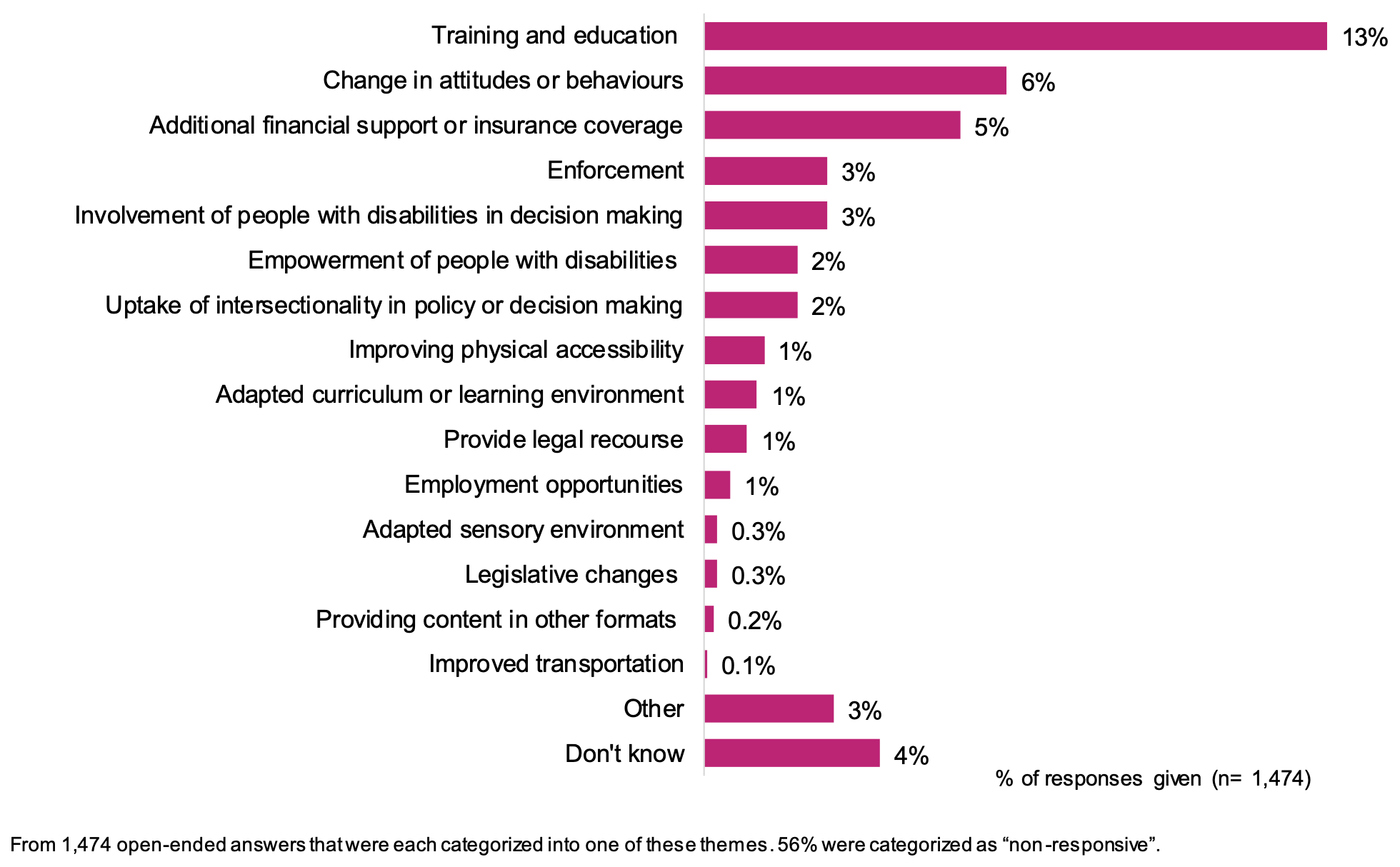
Survey Responses: 1,474 people responded. 13% said 'training and education.' 6% said 'changes in attitudes or behaviours.' 5% said 'additional financial support or insurance coverage.' 3% said 'enforcements.' 3% said 'involvement of people with disabilities in decision making.' 2% said 'empowerment of people with disabilities.' 2% said 'uptake of intersectionality in policy or decision making.' 1% said 'improving physical accessibility.' 1% said 'adapted curriculum or learning environment.' 1% said 'provide legal recourse.' 1% said 'employment opportunities.' 0.3% said 'adapted sensory environment.' 0.3% said 'legislative changes.' 0.2% said 'providing content in other formats.' 0.1% said 'improved transportation.' 3% said 'other.' 4% said 'don't know.' In this question, 56% were categorized as 'non-responsive.'
Chart 29. Guiding Principles: Other
Survey Question: We would like to hear about any other principles you think are important to our work and how they have impacted your life.
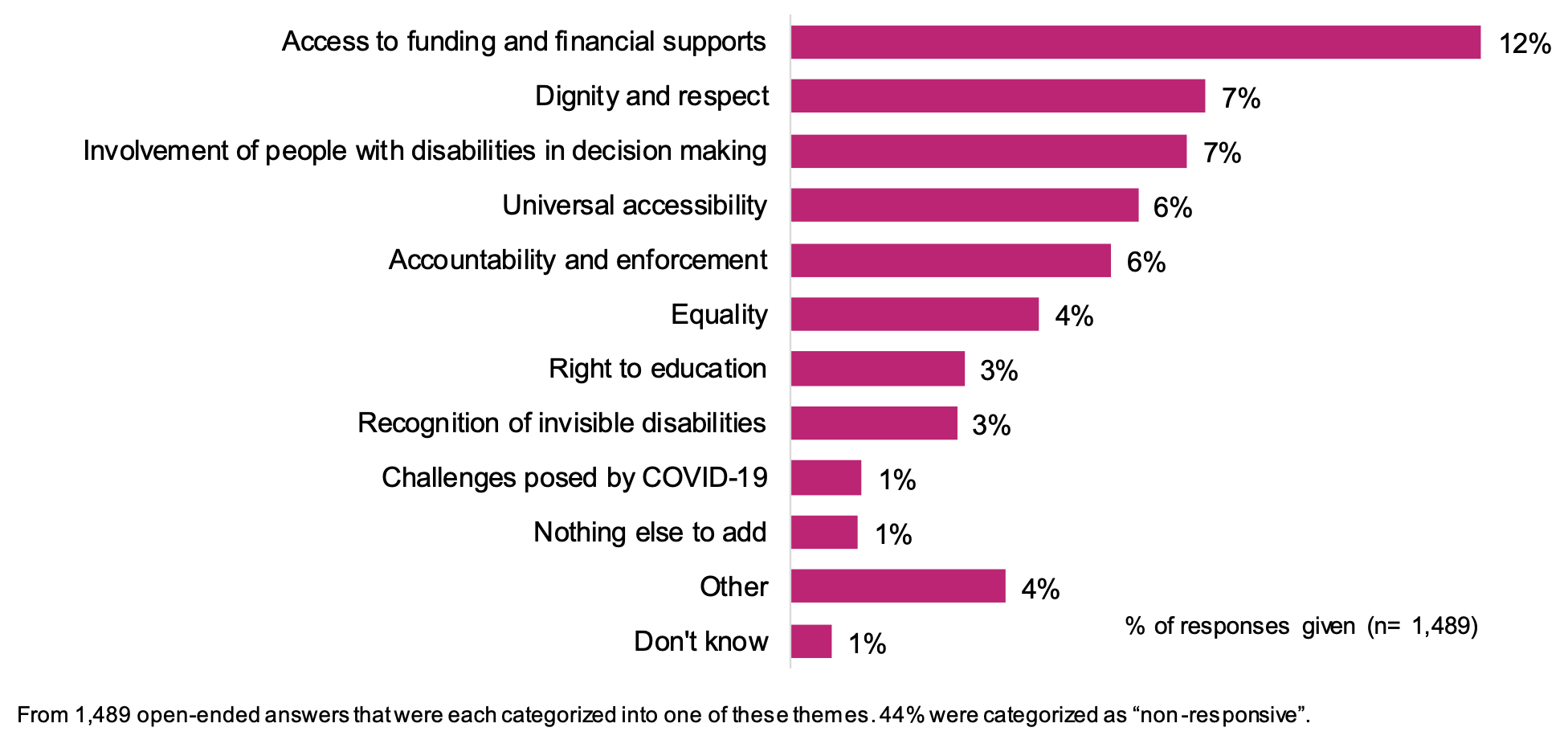
Survey Responses: 1,489 people responded. 12% said 'access to funding and financial supports.' 7% said 'dignity and respect.' 7% said 'involvement of people with disabilities in decision making.' 6% said 'universal accessibility.' 6% said 'accountability and enforcement.' 4% said 'equality.' 3% said 'right to education.' 3% said 'recognition of invisible disabilities.' 1% said 'challenges posed by COVID-19.' 1% said 'nothing else to add.' 4% said 'other.' 1% said 'don't know.' In this question, 44% were categorized as 'non-responsive.'
Chart 30. Involvement: Interest
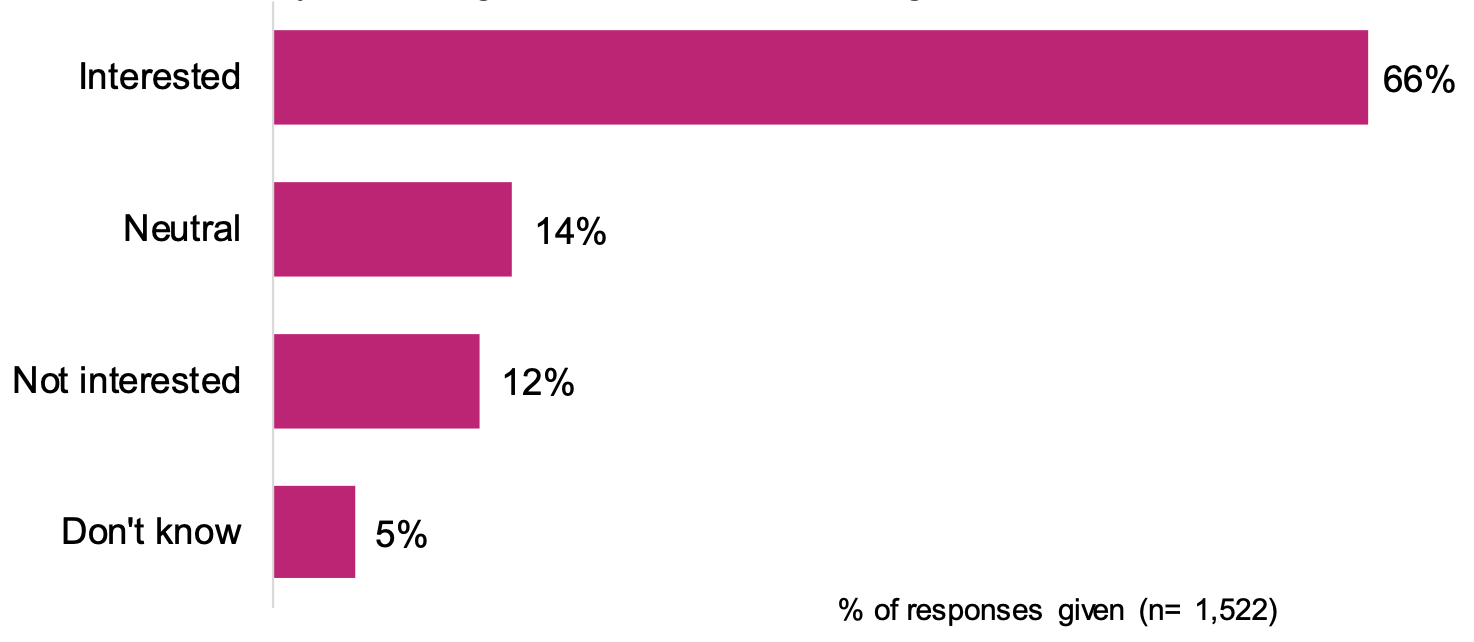
Survey Question: How interested are you in being involved in this monitoring work?
Survey Responses: 1,522 people responded. The answers were grouped as follows. 66% said 'interested.' 14% said 'neutral.' 12% said 'not interested.' 5% said 'don't know.'
Chart 31. Involvement: Supports and resources
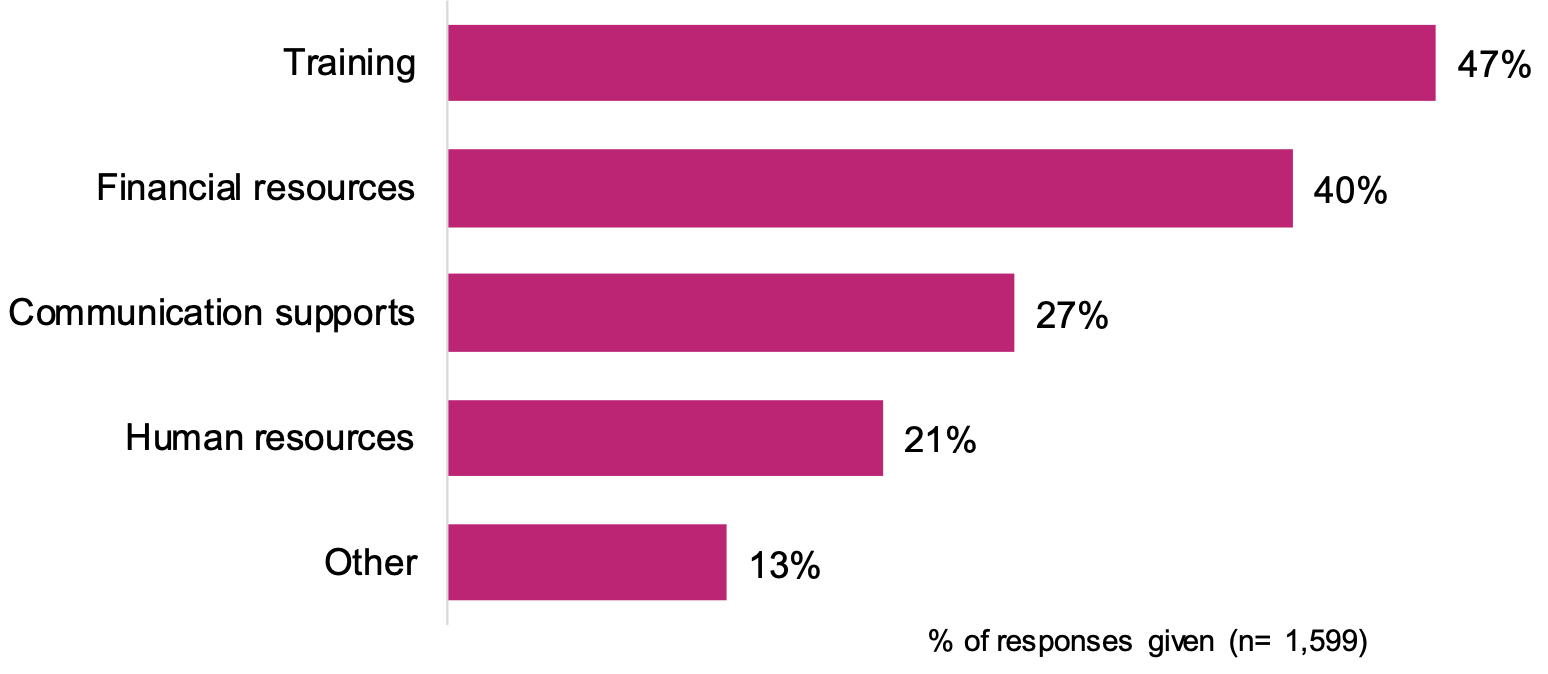
Survey Question: Are there any supports you would need to be able to take part in monitoring activities?
Survey Responses: 1,599 people responded. They could select more than one answer. 47% said 'training.' 40% said 'financial resources.' 27% said 'communications supports.' 21% said 'human resources.' 13% said 'other.'
Chart 32. Monitoring: People's role
Survey Question: Which of the following roles could you see yourself playing?
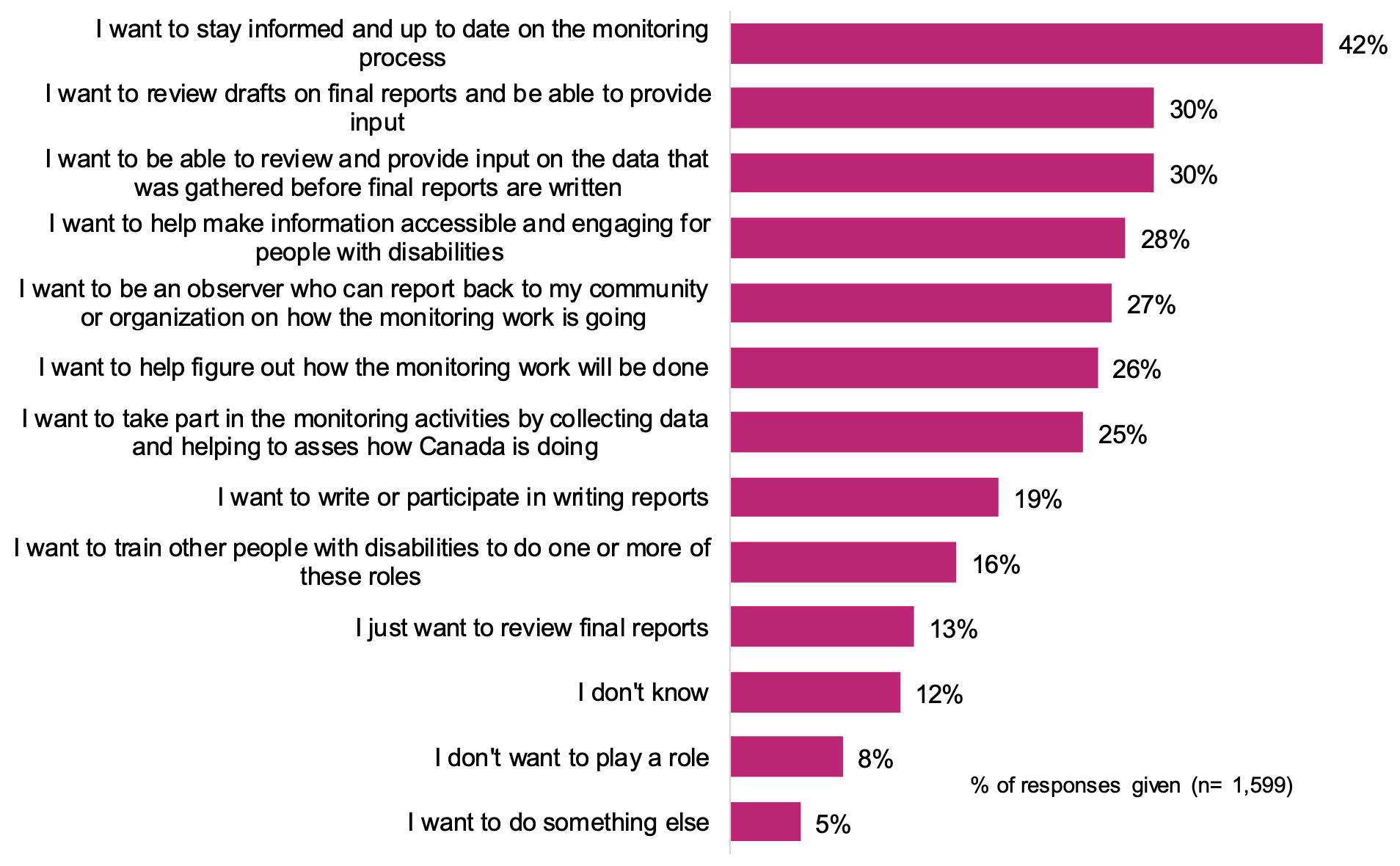
Survey Responses: 1,599 people responded. They could select more than one answer. 42% said 'I want to stay informed and up to date on the monitoring process.' 30% said 'I want to review drafts of final reports and be able to provide input.' 30% said 'I want to be able to review and provide input on the data that was gathered before final reports are written.' 28% said 'I want to help make information accessible and engaging for people with disabilities.' 27% said 'I want to be an observer who can report back to my community or organization on how the monitoring work is going.' 26% said 'I want to help figure out how the monitoring work will be done.' 25% said 'I want to take part in the monitoring activities by collecting data and helping to assess how Canada is doing.' 19% said 'I want to write or participate in writing reports.' 16% said 'I want to train other people with disabilities to do one or more of these roles.' 13% said 'I just want to review the final reports.' 12% said 'I don't know.' 8% said 'I don't want to play a role.' 5% said 'I want to do something else.'
Chart 33. Monitoring: Organizations' role
Survey Question: What could an organization, such as those that represent people with disabilities, do to help you participate in monitoring?
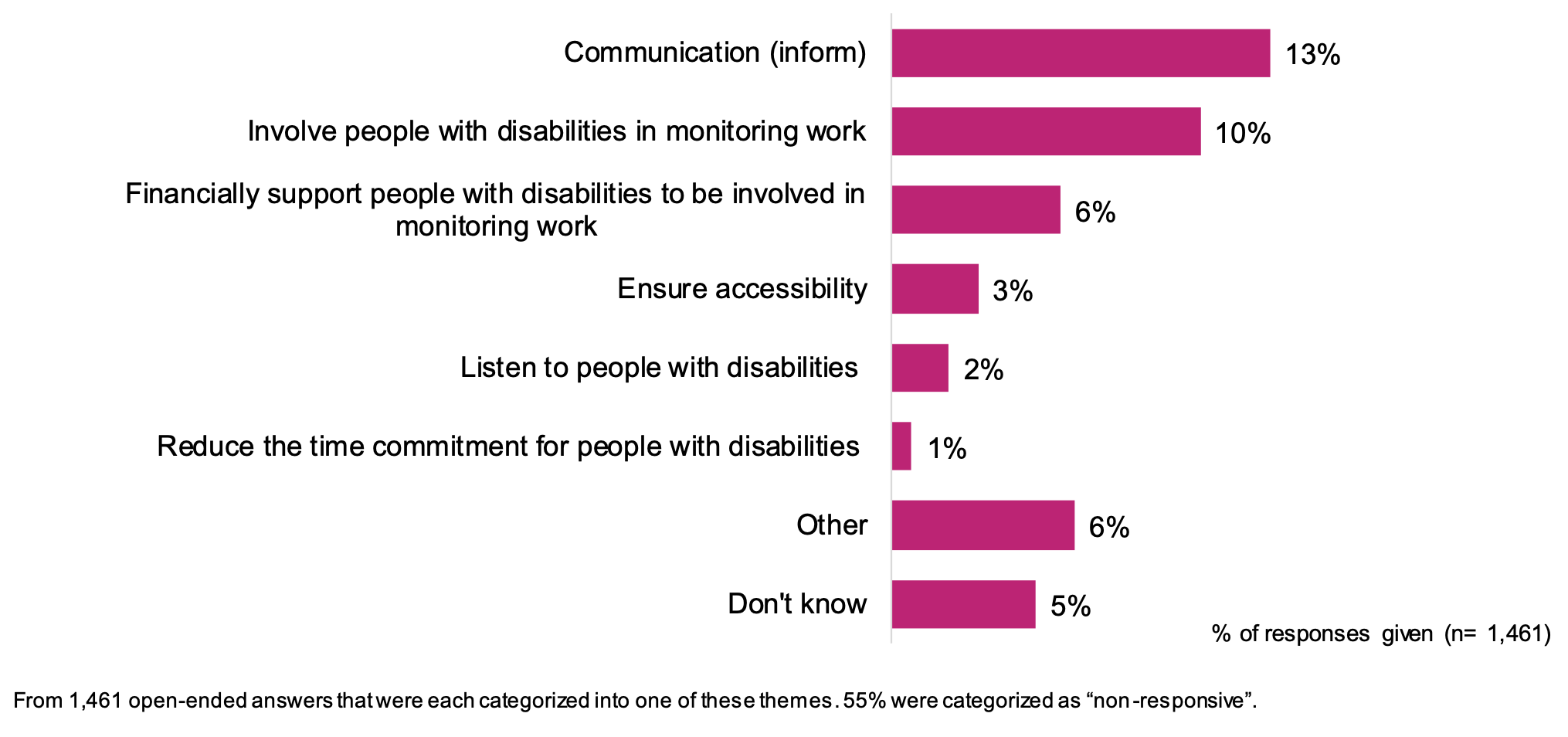
Survey Responses: 1,461 people responded. 13% said 'communication (inform).' 10% said 'involve people with disabilities in monitoring work.' 6% said 'financially support people with disabilities to be involved in monitoring work.' 3% said 'ensure accessibility.' 2% said 'listen to people with disabilities.' 1% said 'reduce the time commitment for people with disabilities.' 6% said 'other.' 5% said 'don't know.' In this question, 55% were categorized as 'non-responsive.'
Chart 34. Priorities: Issues or areas of concern
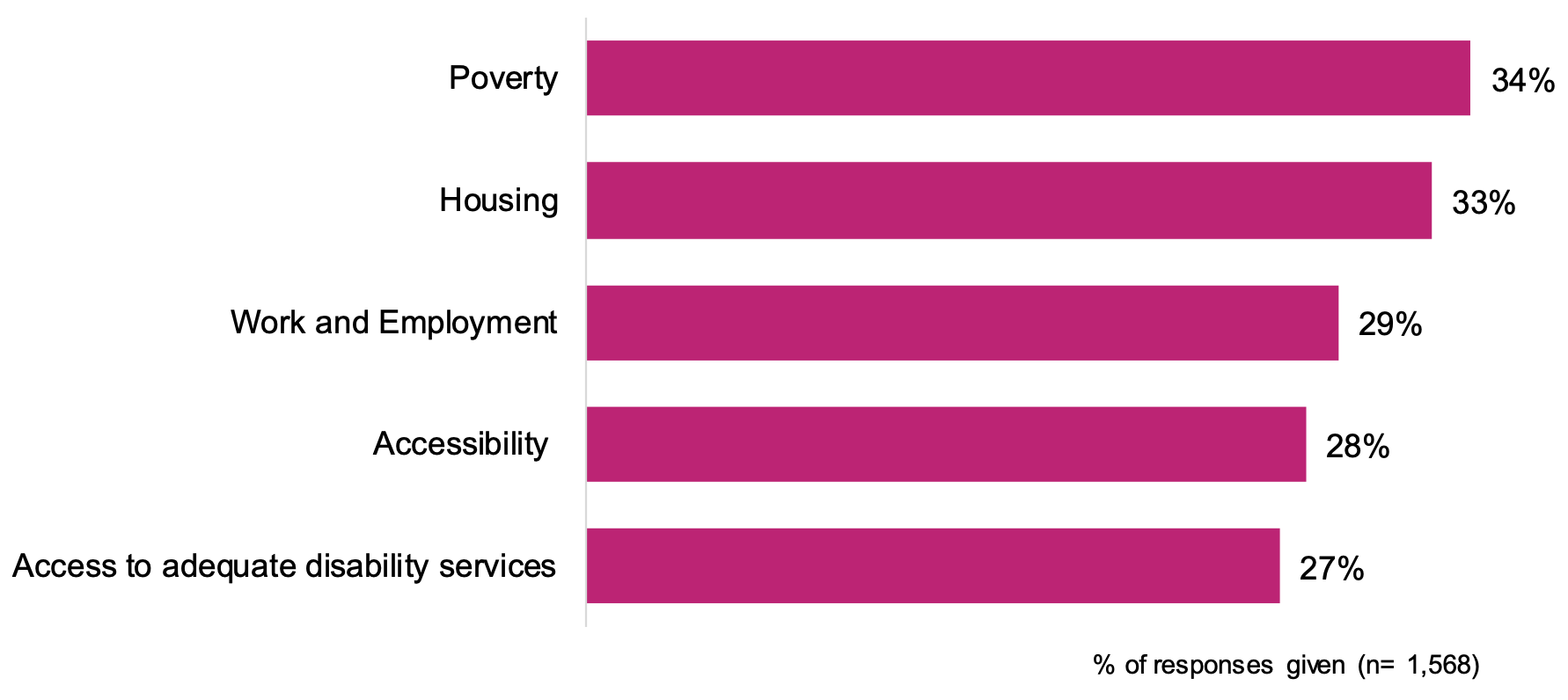
Survey Question: What are the top three issues or areas of concern for you?
Survey Responses: 1,568 people responded. They could select more than one answer. 34% said 'poverty.' 33% said 'housing.' 29% said 'work and employment.' 28% said 'accessibility.' 27% said 'access to adequate disability services.'
Chart 35. Framework: Preferred option to monitor the Convention
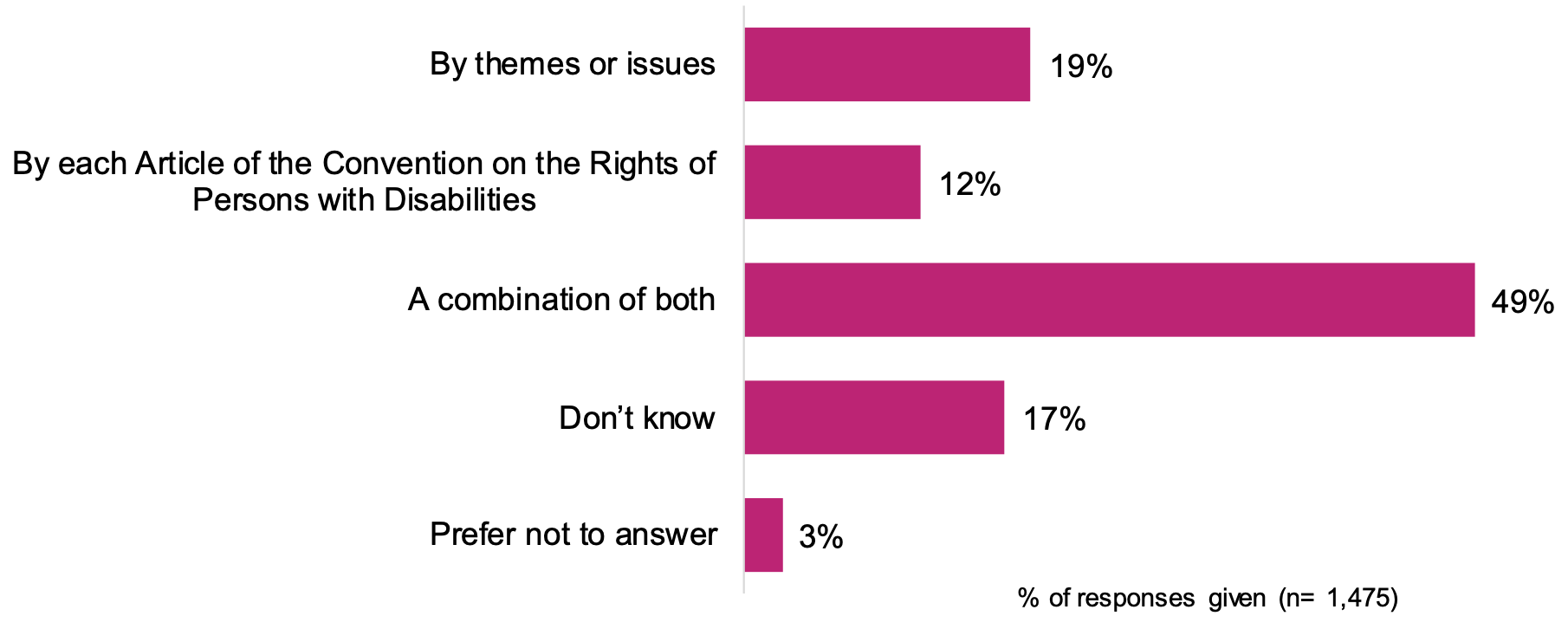
Survey Question: Which of these options would you prefer to monitor the Convention?
Survey Responses: 1,475 people responded. 19% said 'by themes or issues.' 12% said 'by each article of the Convention on the Rights of Persons with Disabilities.' 49% said 'a combination of both.' 17% said 'don't know.' 3% said 'prefer not to answer.'
Chart 36. Monitoring: Types of data
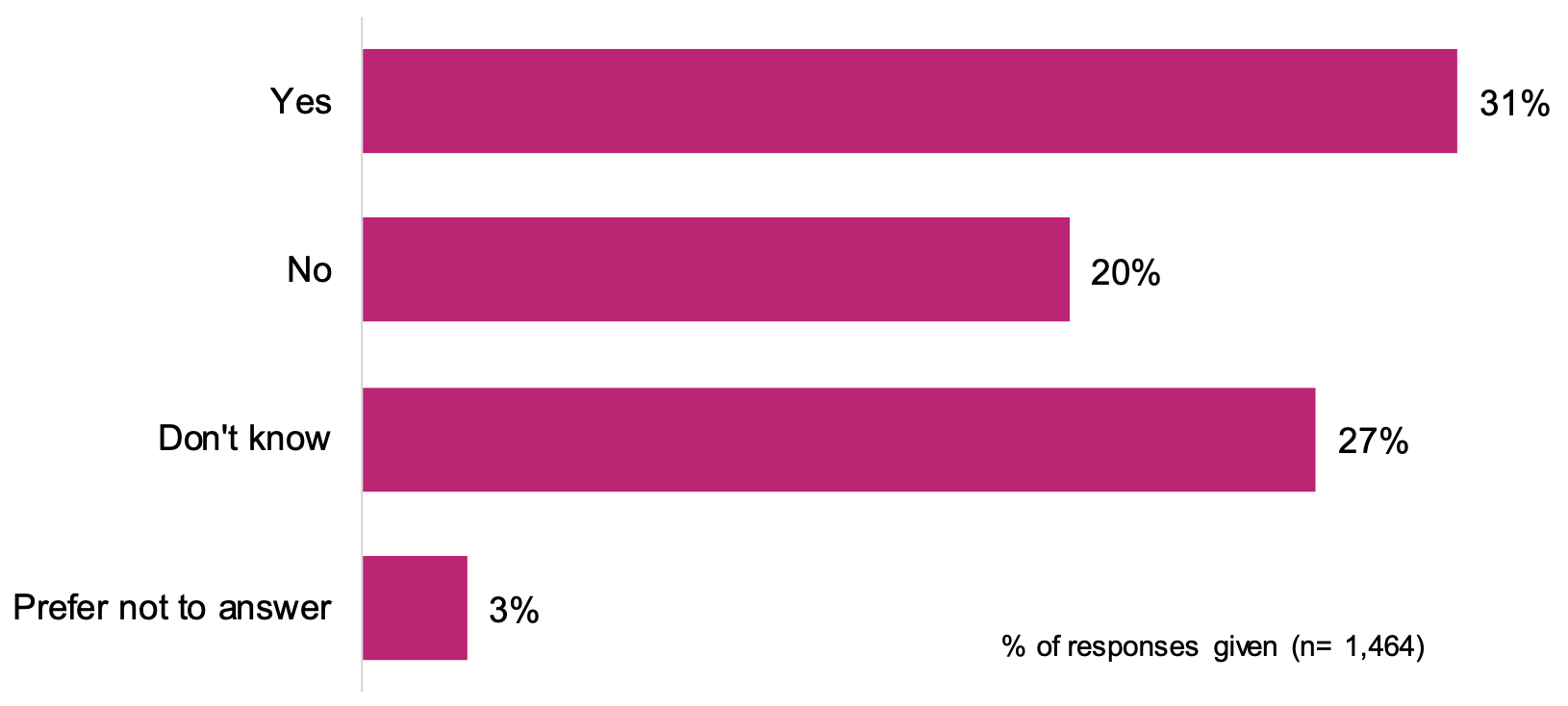
Survey Question: Besides the types of data listed above, are there any other types of information that you think should be included?
Survey Responses: 1,464 people responded. 31% said 'yes.' 20% said 'no.' 27% said 'don't know.' 3% said 'prefer not to answer.'
Chart 37. Monitoring: Types of data
Survey Question: There are different types of information (or data) we can collect. This information could tell us how the Convention is being followed in Canada. Can you please share examples of information that you think should be included? (*Only people who answered 'yes' to the previous question answered this question so responses may be low.)
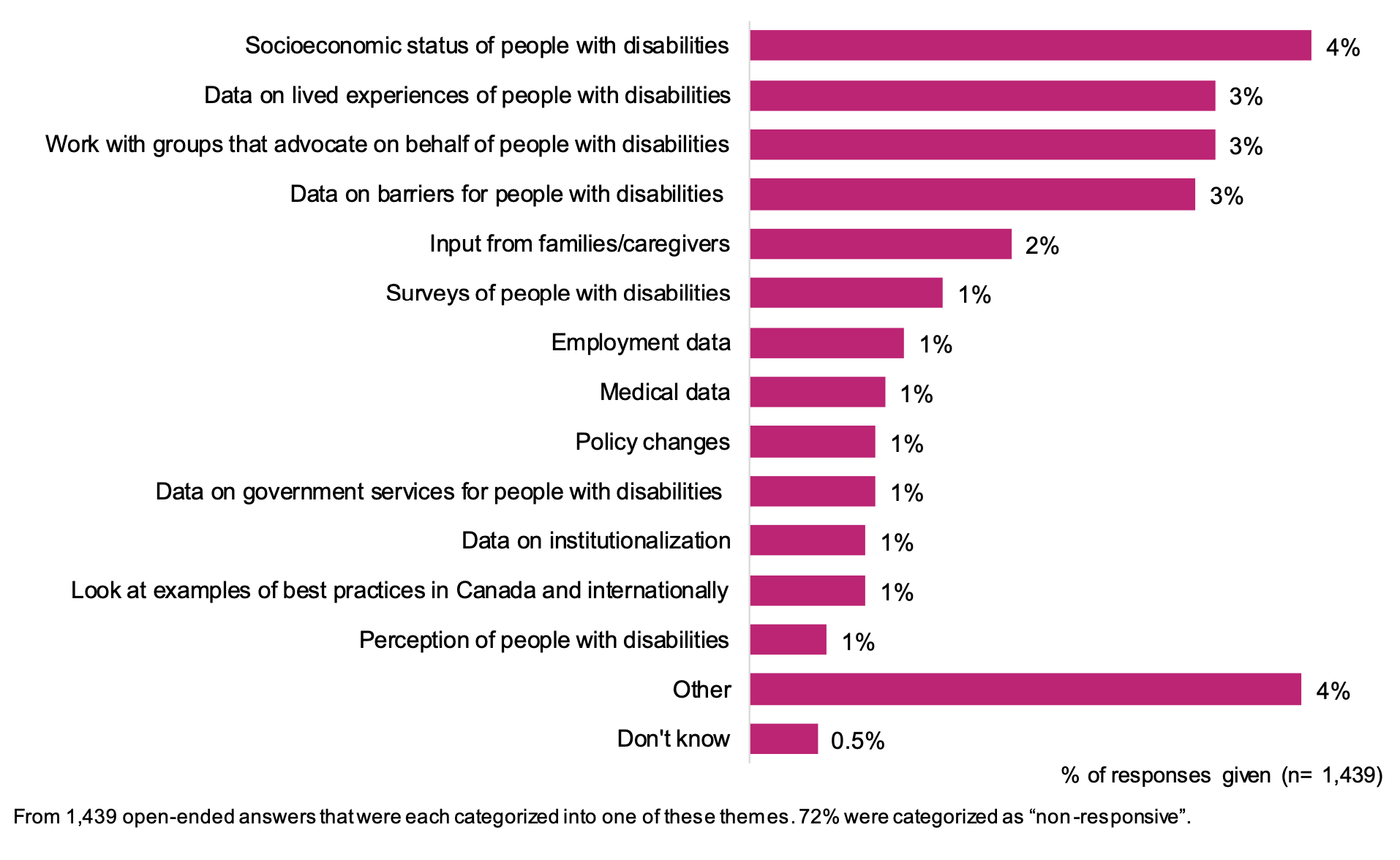
Survey Responses: 1,439 people responded. 4% said 'socioeconomic status of people with disabilities.' 3% said 'data on lived experiences of people with disabilities.' 3% said 'work with groups that advocate on behalf of people with disabilities.' 3% said 'data on barriers for people with disabilities.' 2% said 'input from families and caregivers.' 1% said 'surveys of people with disabilities.' 1% said 'employment data.' 1% said 'medical data.' 1% said 'policy changes.' 1% said 'data on government services for people with disabilities.' 1% said 'data on institutionalization.' 1% said 'look at examples of best practices in Canada and internationally.' 1% said 'perception of people with disabilities.' 4% said 'other.' 0.5% said 'don't know.' In this question, 72% were categorized as 'non-responsive.'
Chart 38. Most useful outputs
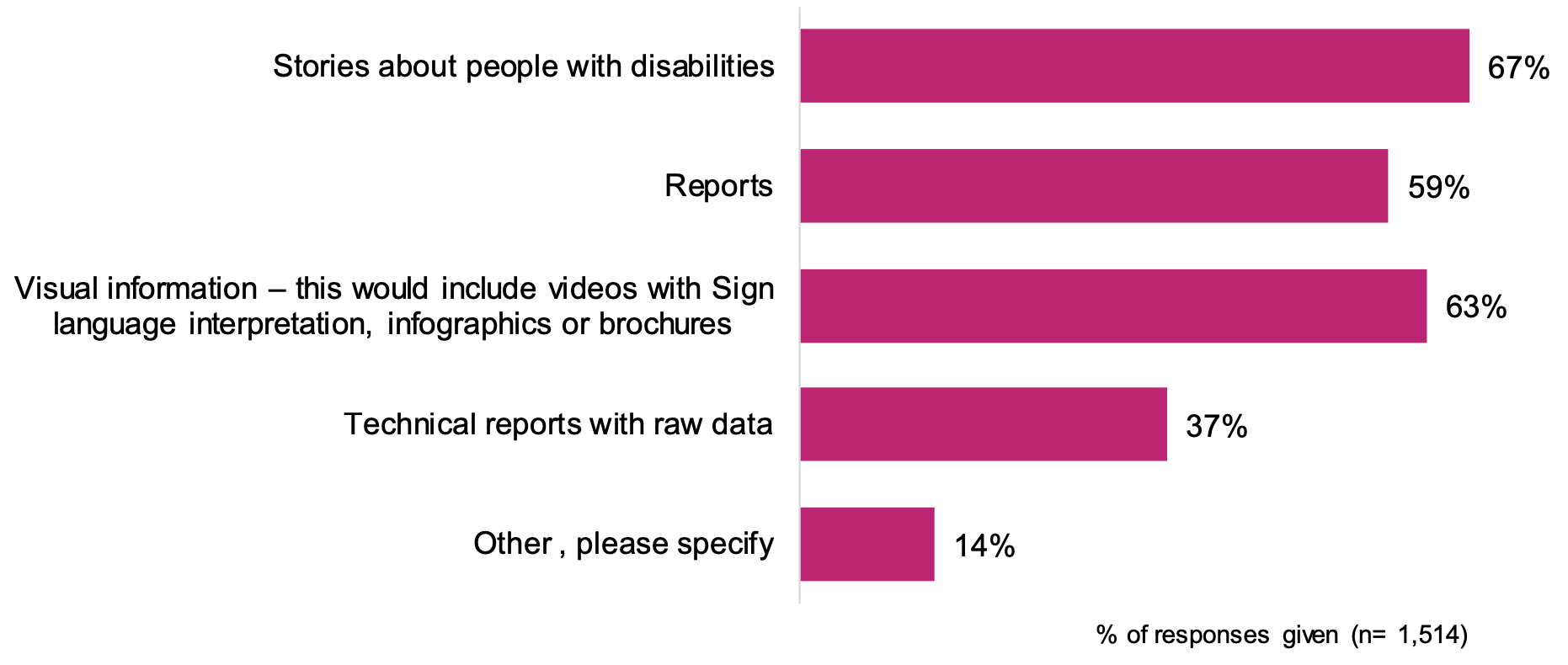
Survey Question: What types of outputs would you find most useful?
Survey Responses: 1,514 people responded. They could select more than one answer. 67% said 'stories about people with disabilities.' 59% said 'reports.' 63% said 'visual information – this would include videos with Sign language interpretation, infographics or brochures.' 37% said 'technical reports with raw data.' 14% said 'other.'
Chart 39. Questions to think about: How is Canada doing
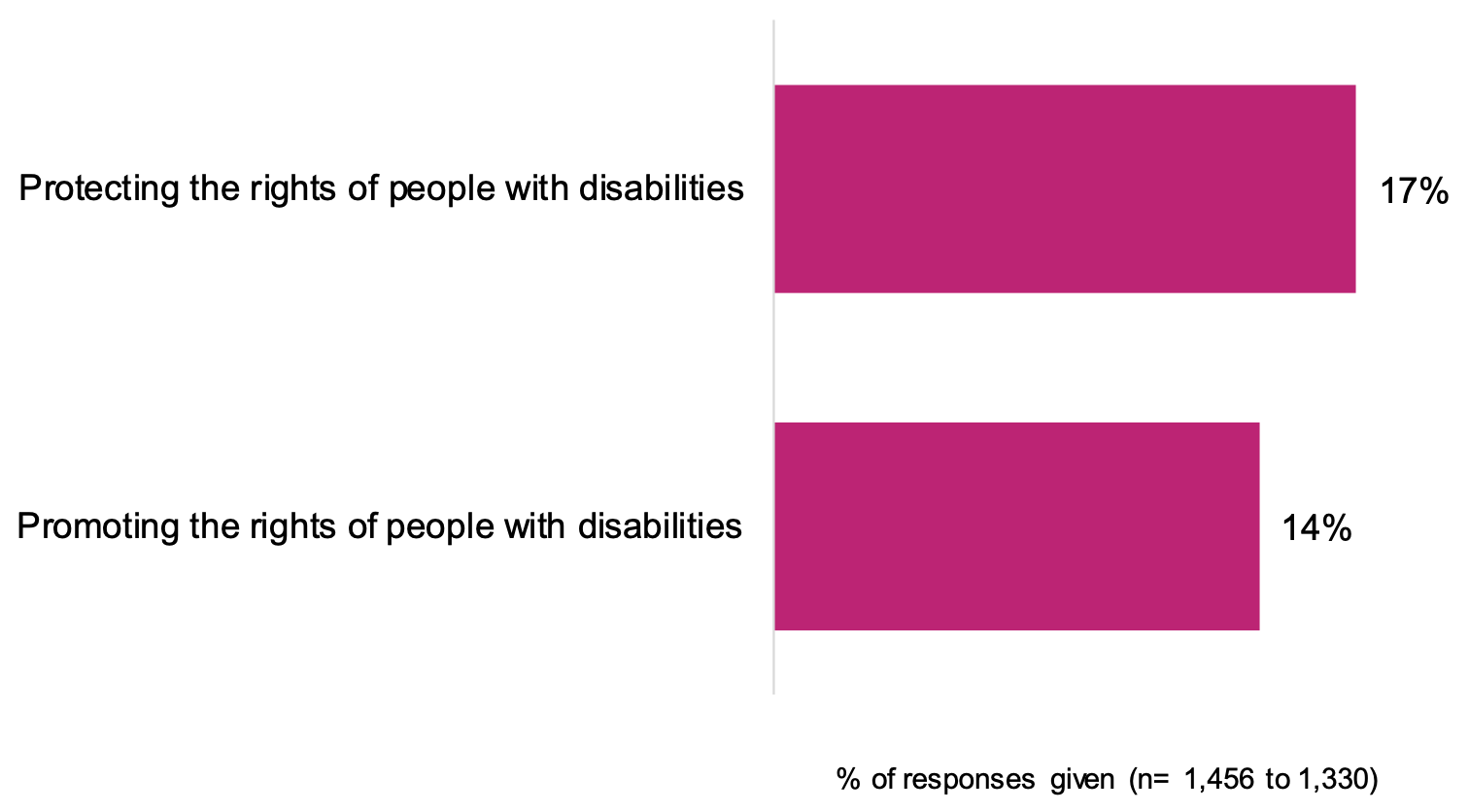
Survey Questions: Overall, how do you feel Canada is doing in protecting the rights of people with disabilities? Overall, how do you feel Canada is doing in promoting the rights of people with disabilities?
Survey Responses: 1,456 people responded to the first question about protecting the rights of people with disabilities and 1,330 people responded to the second question about promoting the rights of people with disabilities. 17% said 'Canada is doing very well or good at protecting the rights of people with disabilities.' 14% said 'Canada is doing very well or good at promoting the rights of people with disabilities.'
Chart 40. Questions to think about: Positive Impact from the Convention
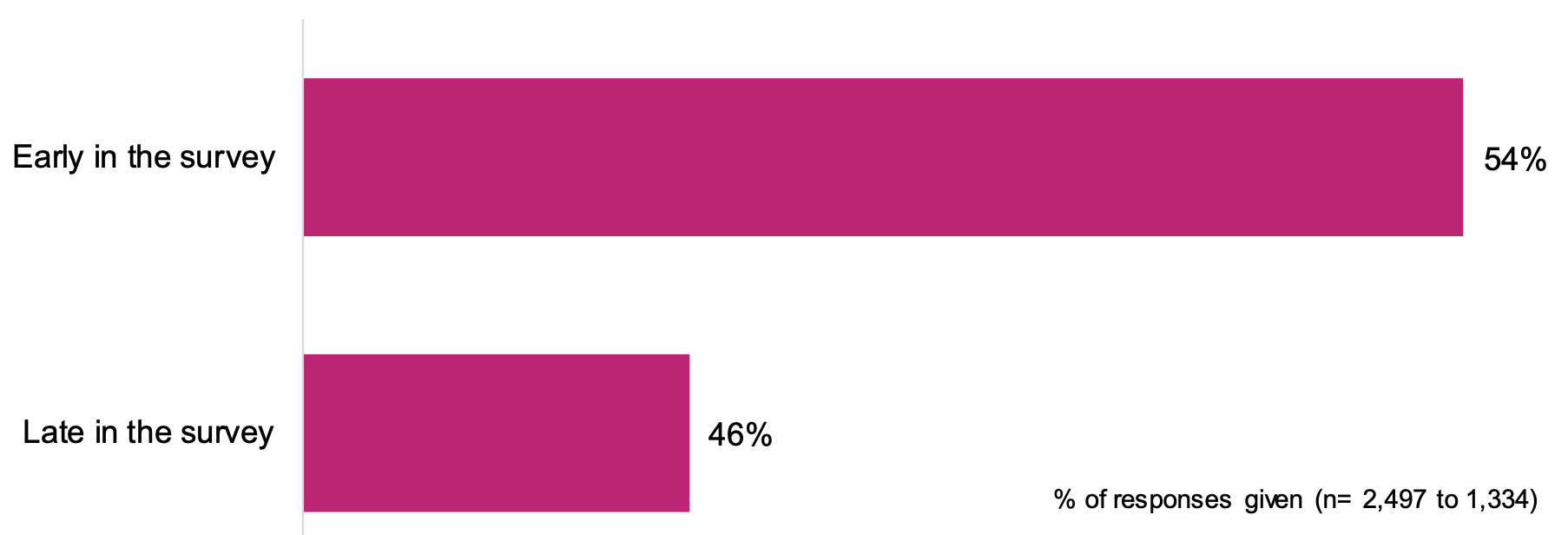
Survey Question: How much of a positive impact do you think the Convention will have on your life in the future?
Survey Responses: 2,497 people responded early in the survey and 1,334 people responded late in the survey. 54% said 'very positive or somewhat positive' early in the survey. 46% said 'very positive or somewhat positive' late in the survey.
Chart 41. Questions to think about: Importance to partner
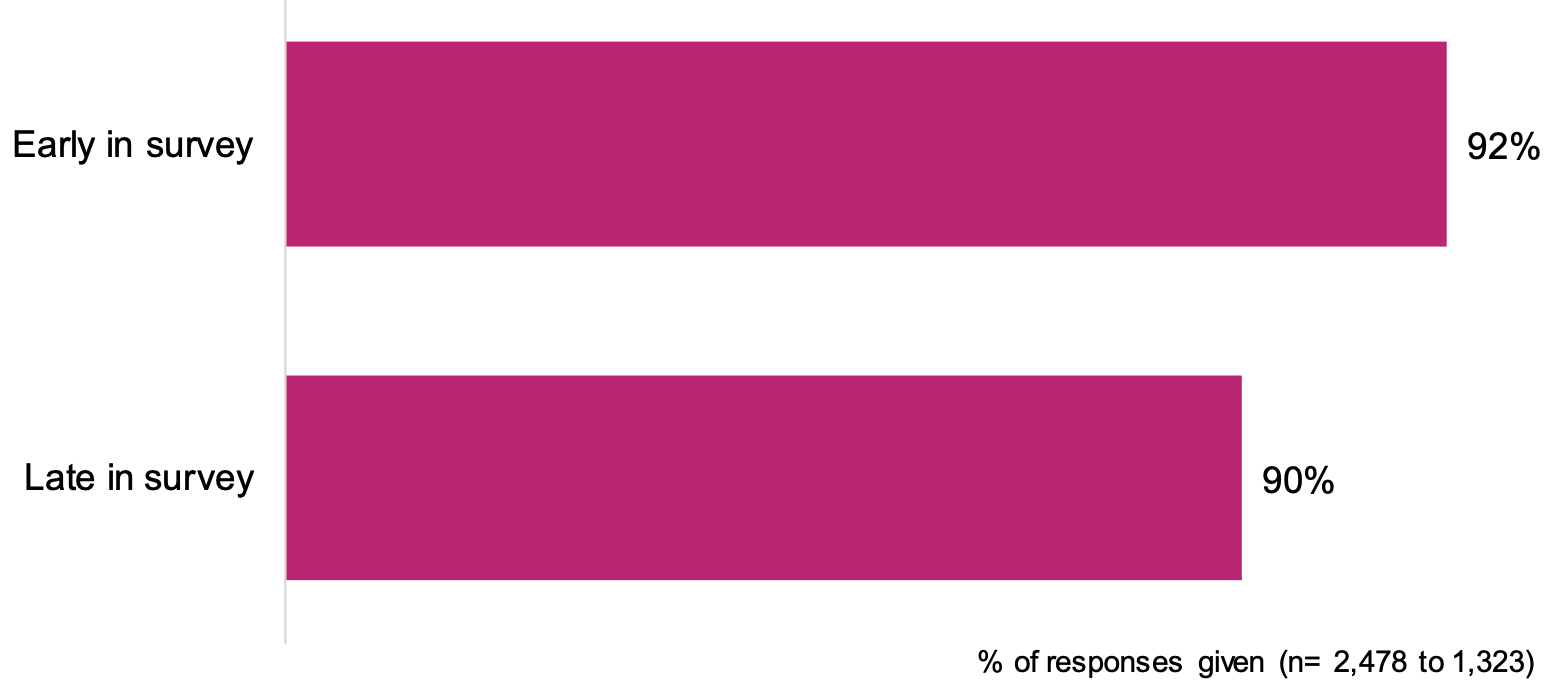
Survey Question: How important do you think it is that the Commission partners with others to make sure Canada follows the Convention?
Survey Responses: 2,478 people responded early in the survey and 1,323 people responded late in the survey. 92% said 'very important or somewhat important' early in the survey. 90% said ''very important or somewhat important' late in the survey.
Chart 42. Evaluation
Survey Question: Please tell us how you liked this survey experience.
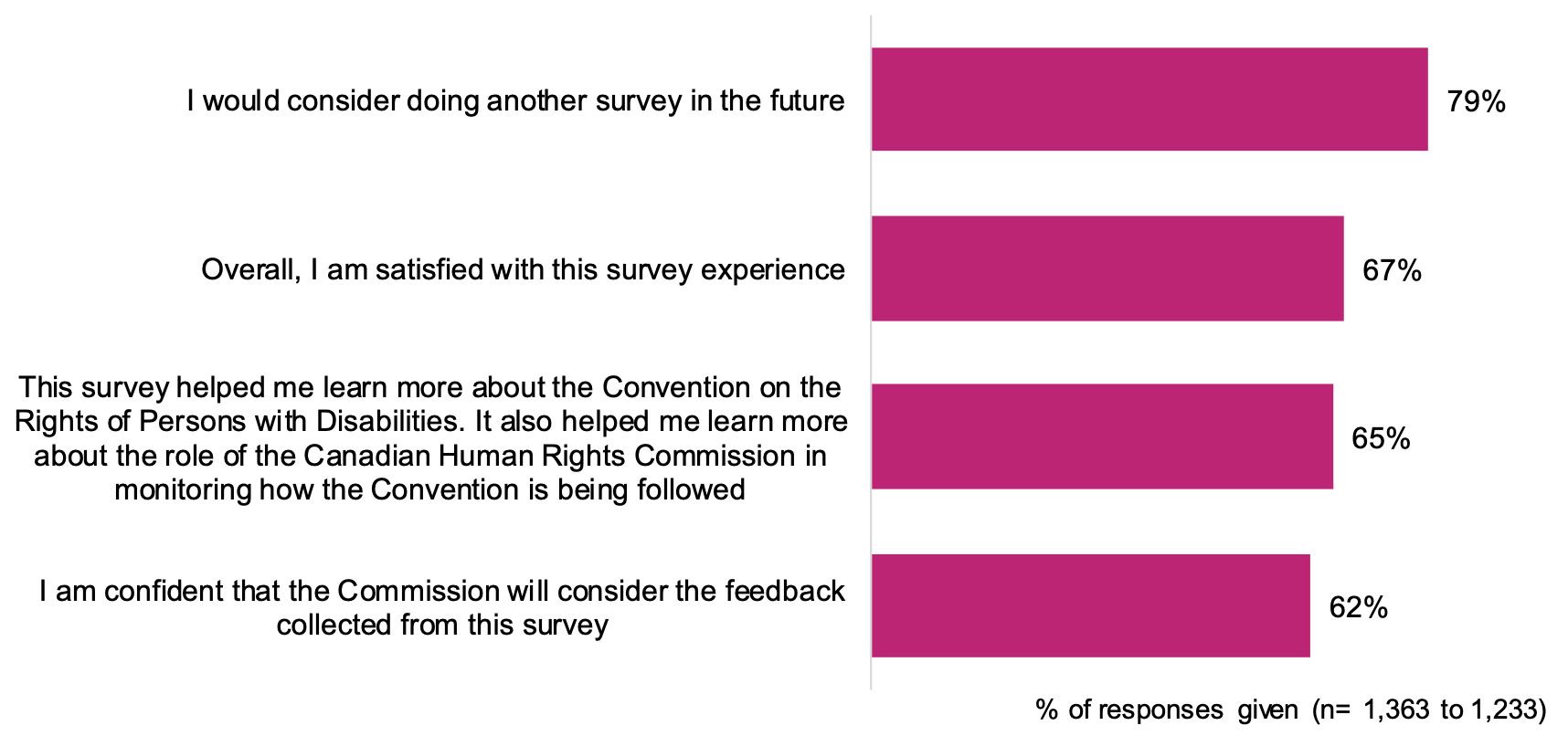
Survey Responses: This question had four parts. There was a range in the number of responses to this question. 1,363 to 1,233 people answered. 79% said 'strongly agree or agree: I would consider doing another survey in the future.' 67% said 'strongly agree or agree: Overall, I am satisfied with this survey experience.' 65% said 'strongly agree or agree: This survey helped me learn more about the Convention on the Rights of Persons with Disabilities. It also helped me learn more about the role of the Canadian Human Rights Commission in monitoring how the Convention is being followed.' 62% said 'strongly agree or agree: I am confident that the Commission will consider the feedback collected from this survey.'
Appendix D: Provincial breakdowns
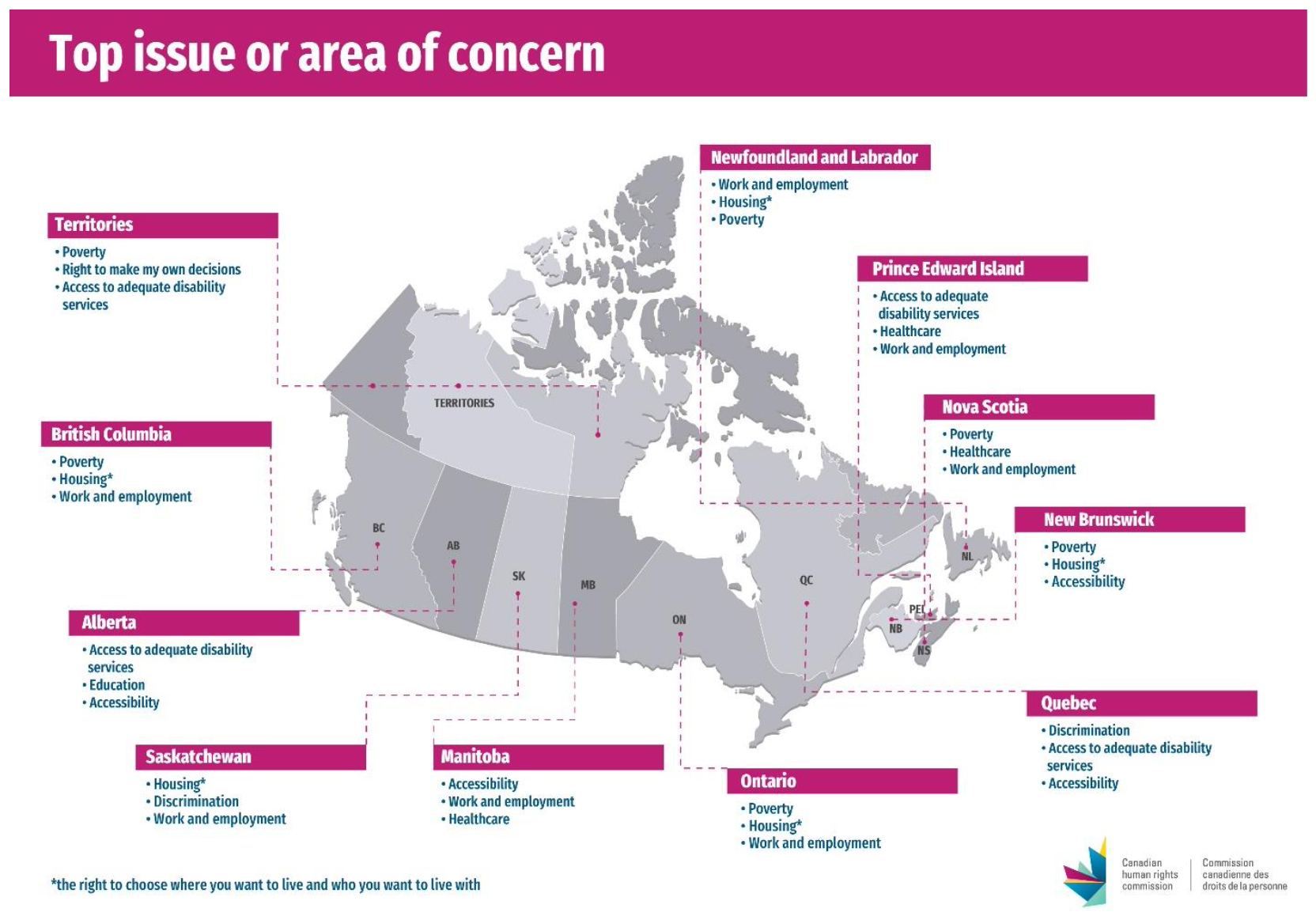
Please note that these are ranked in order of preference.
